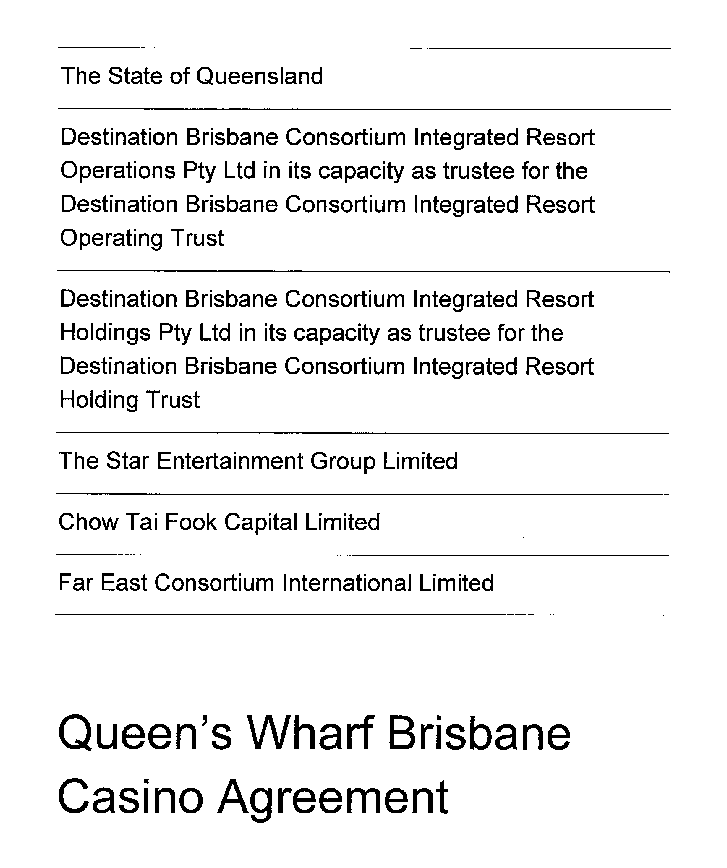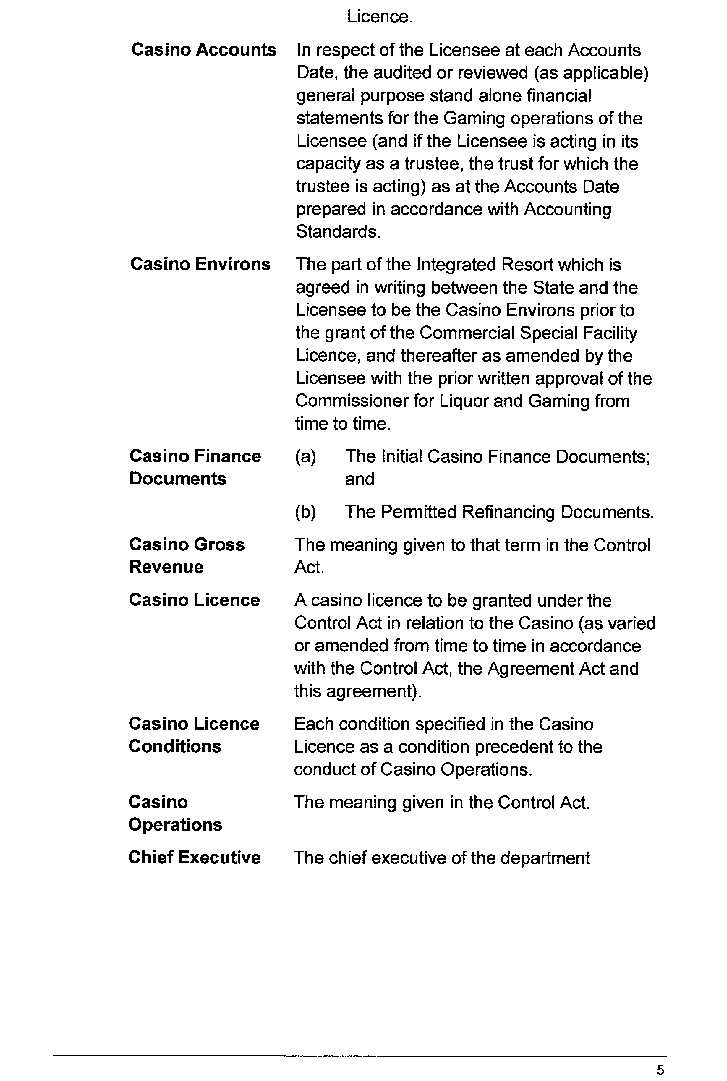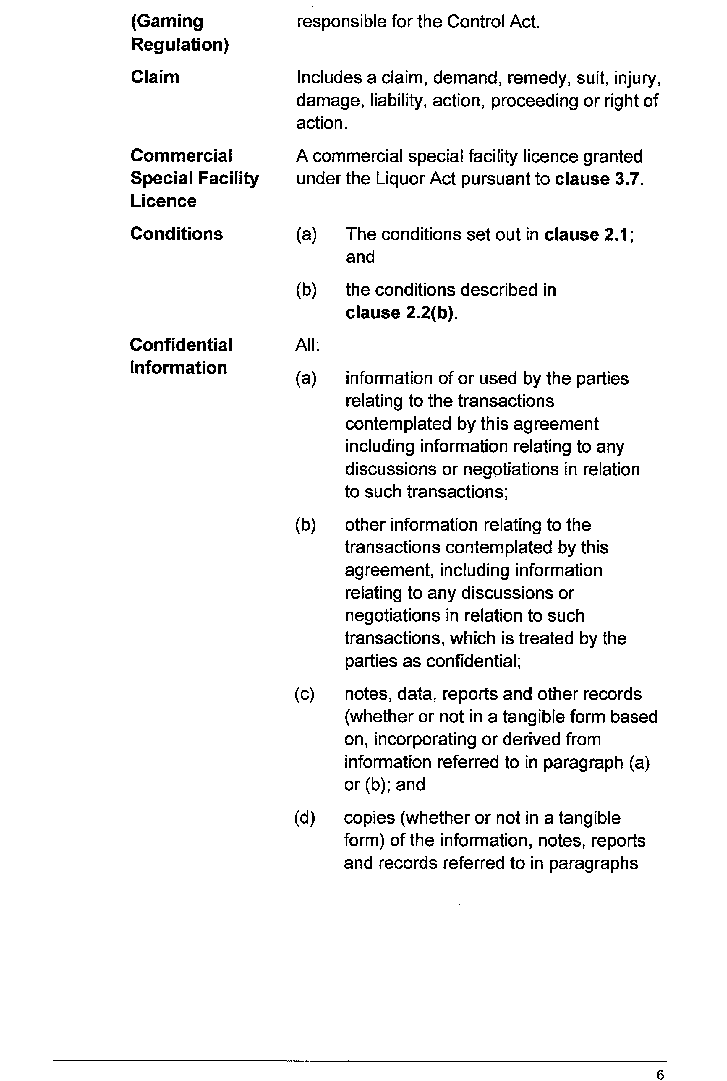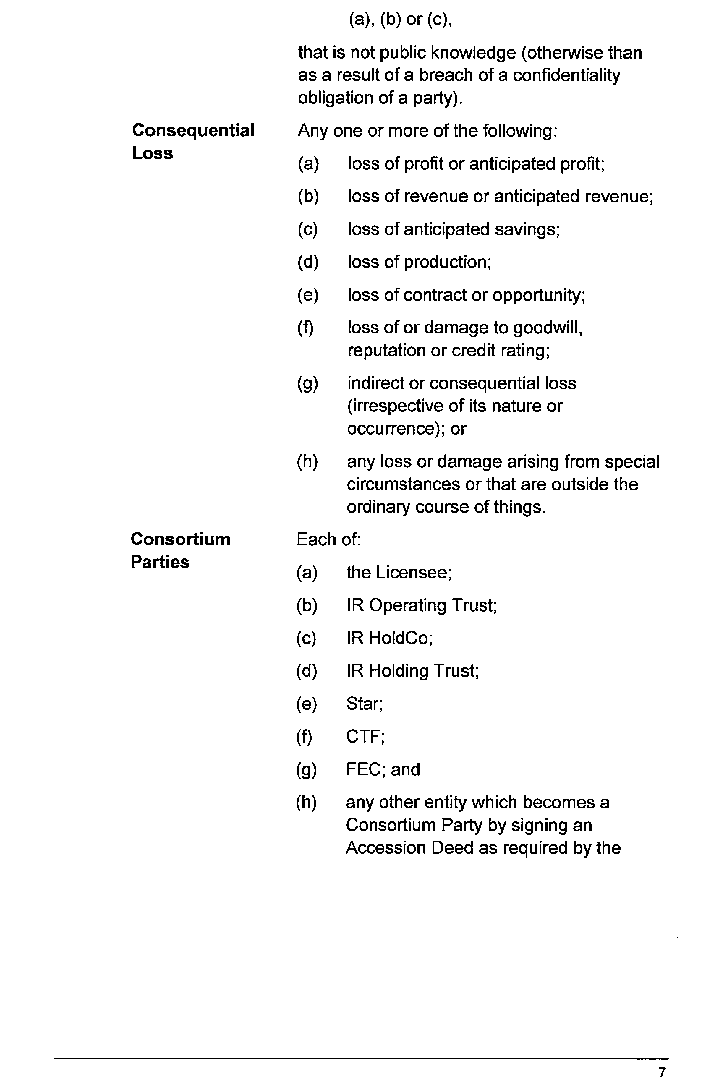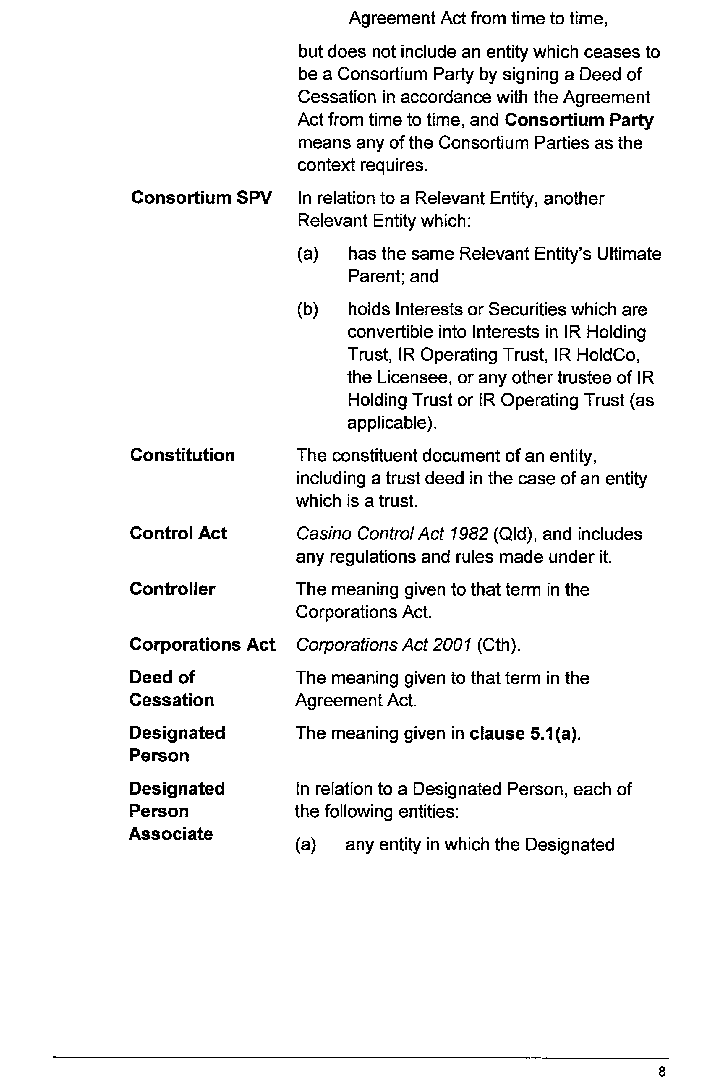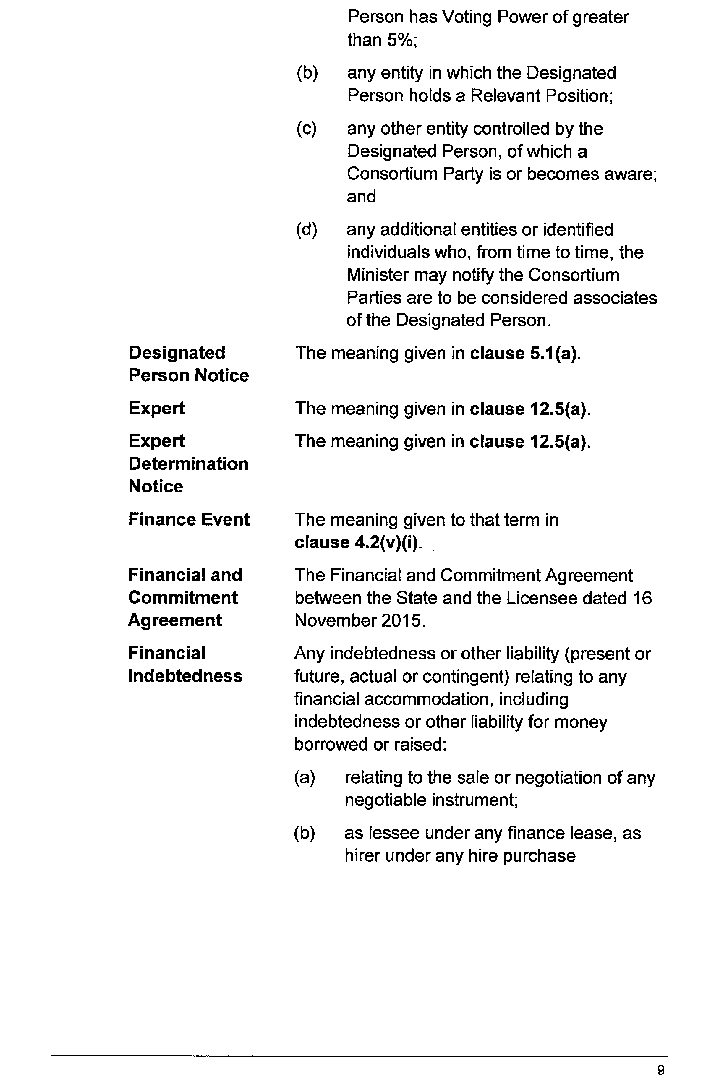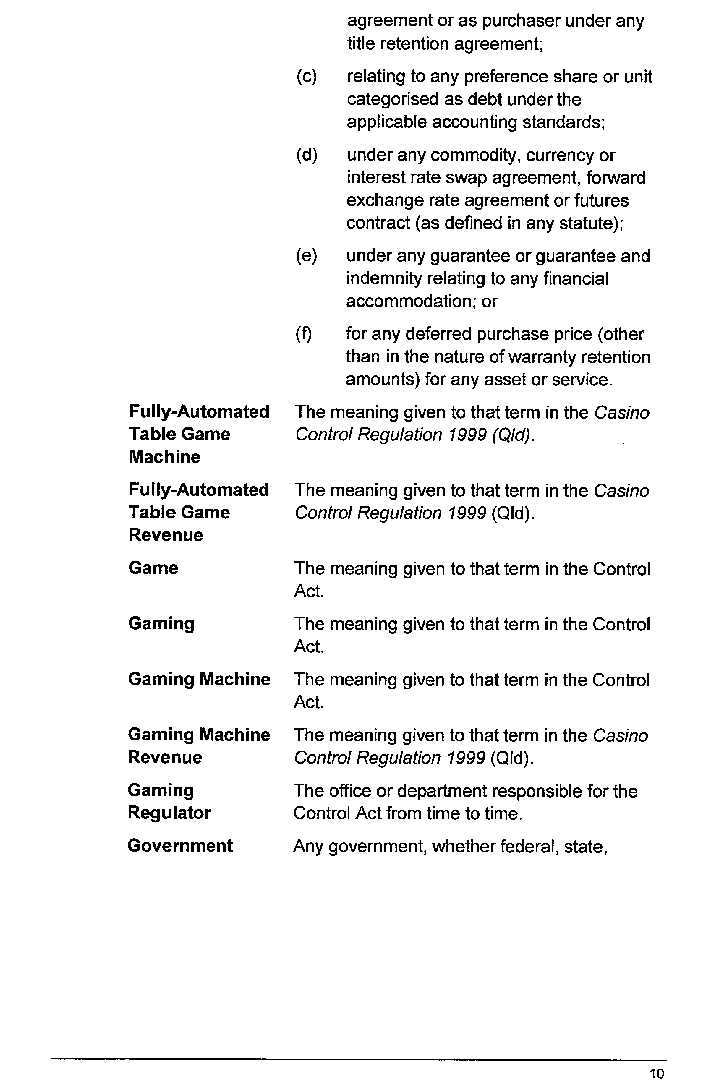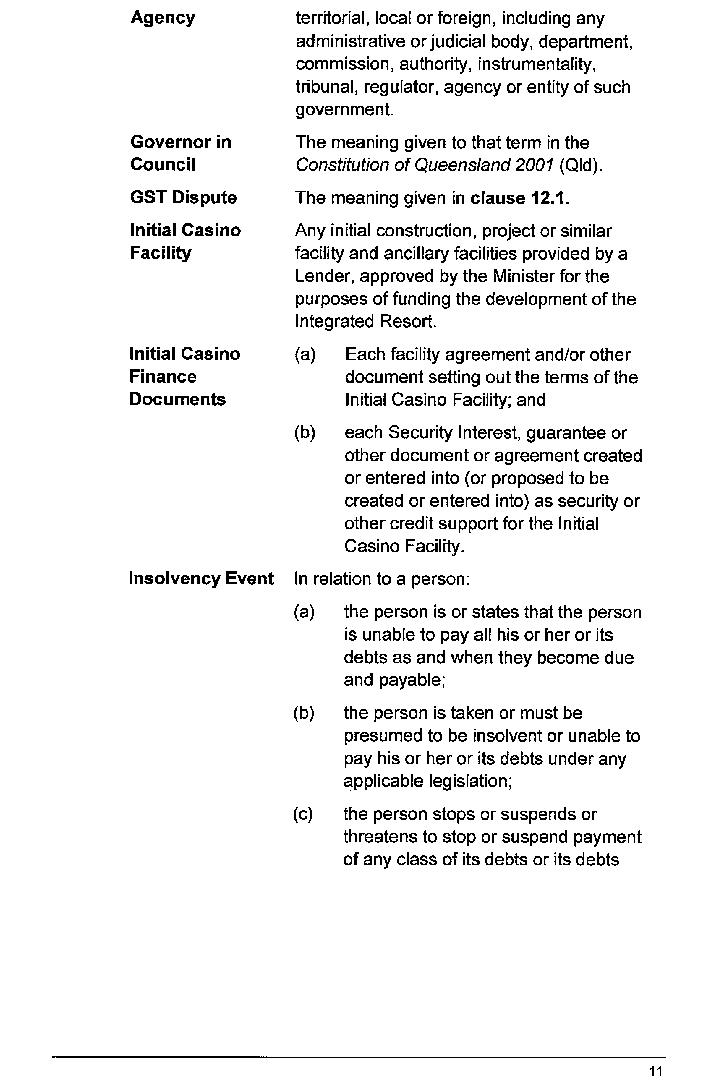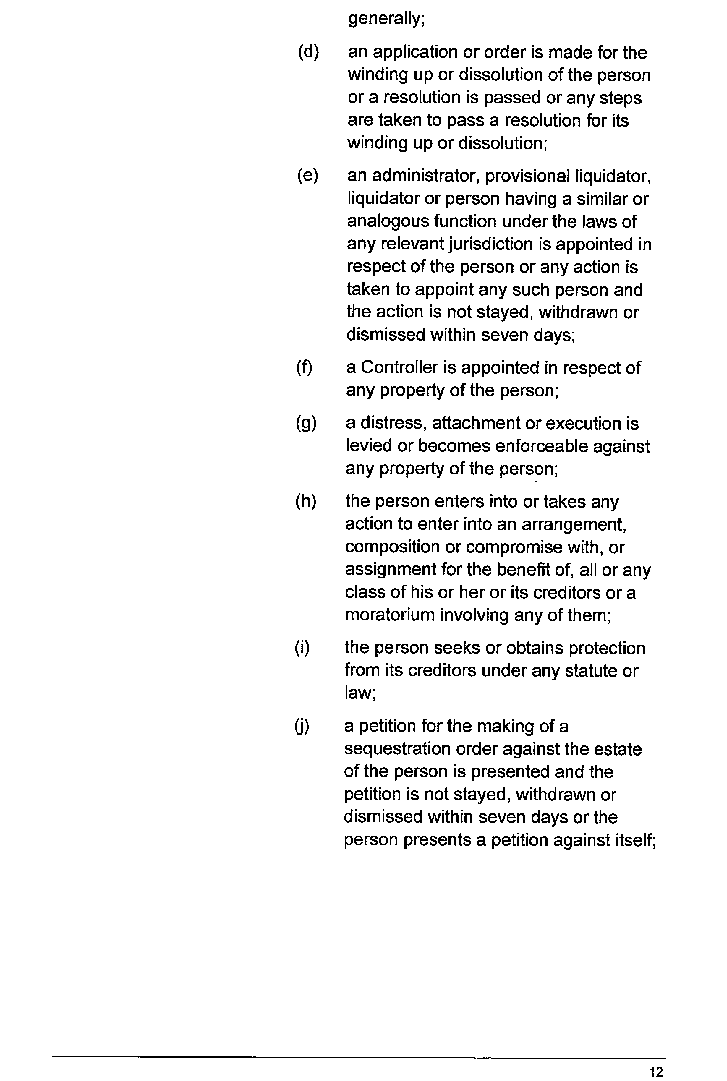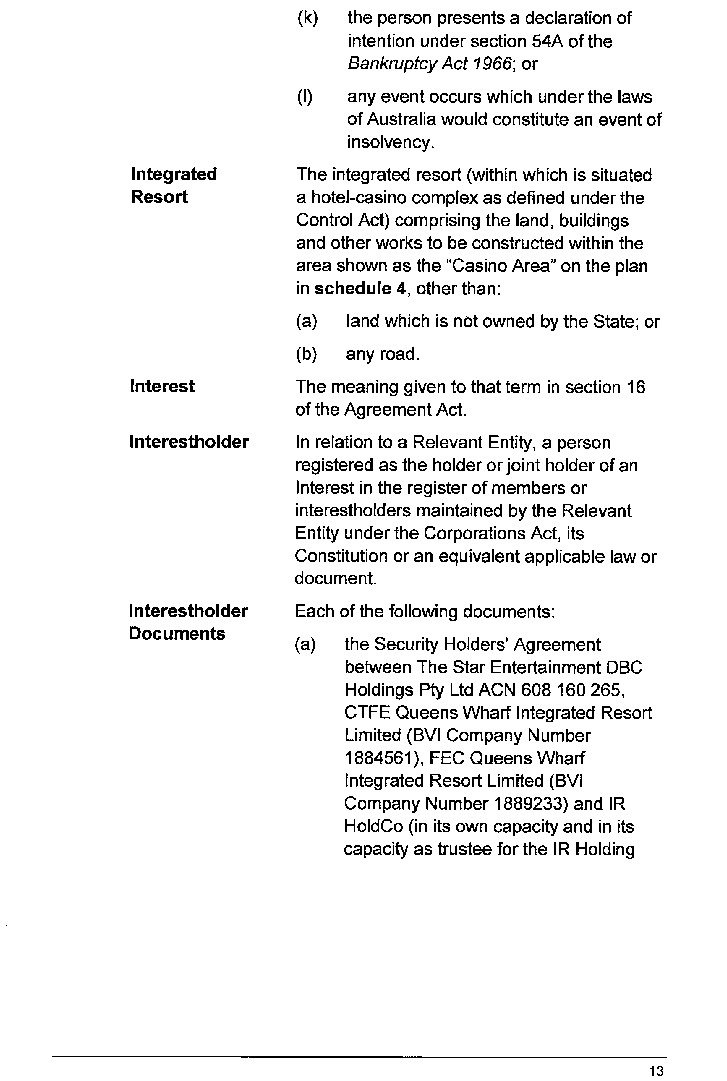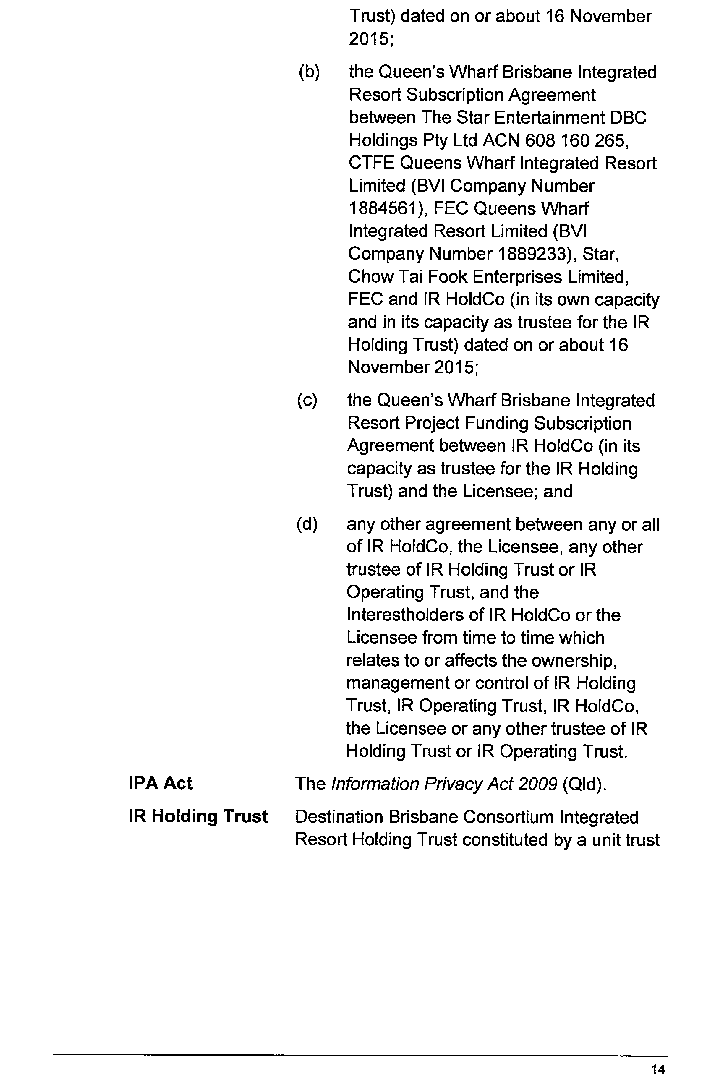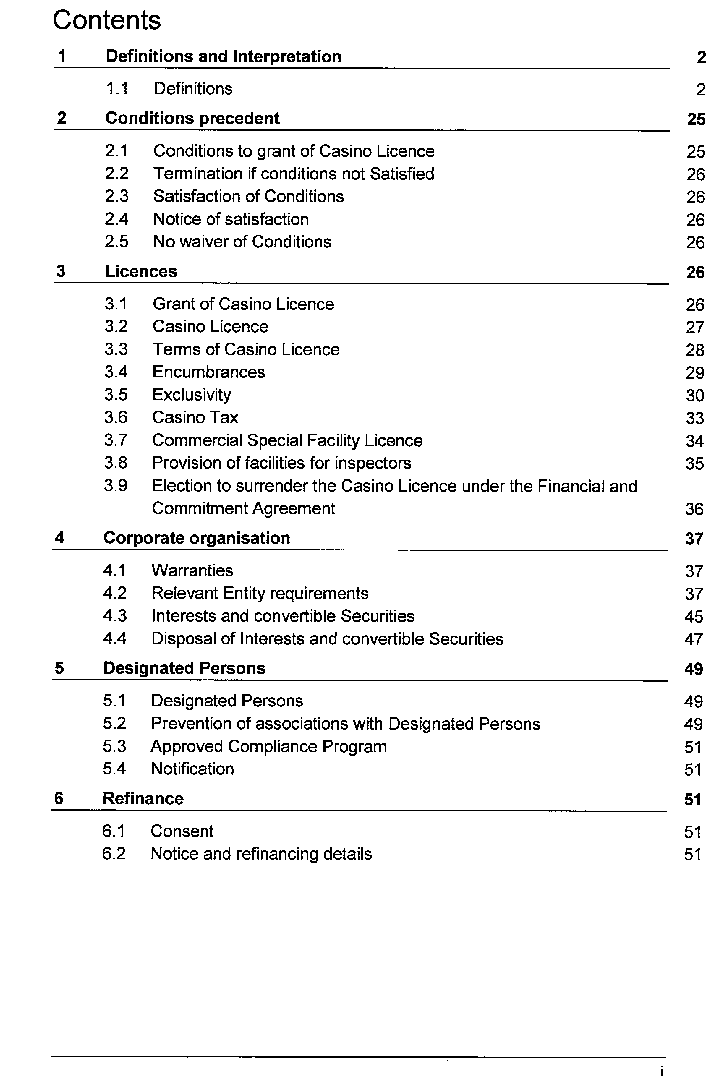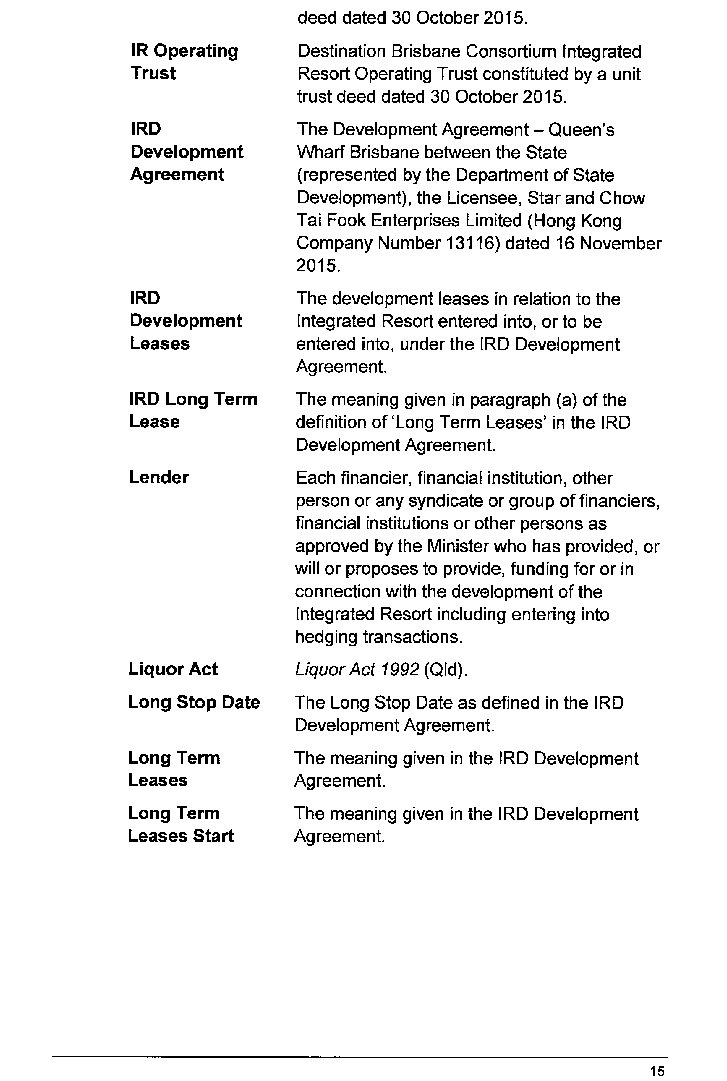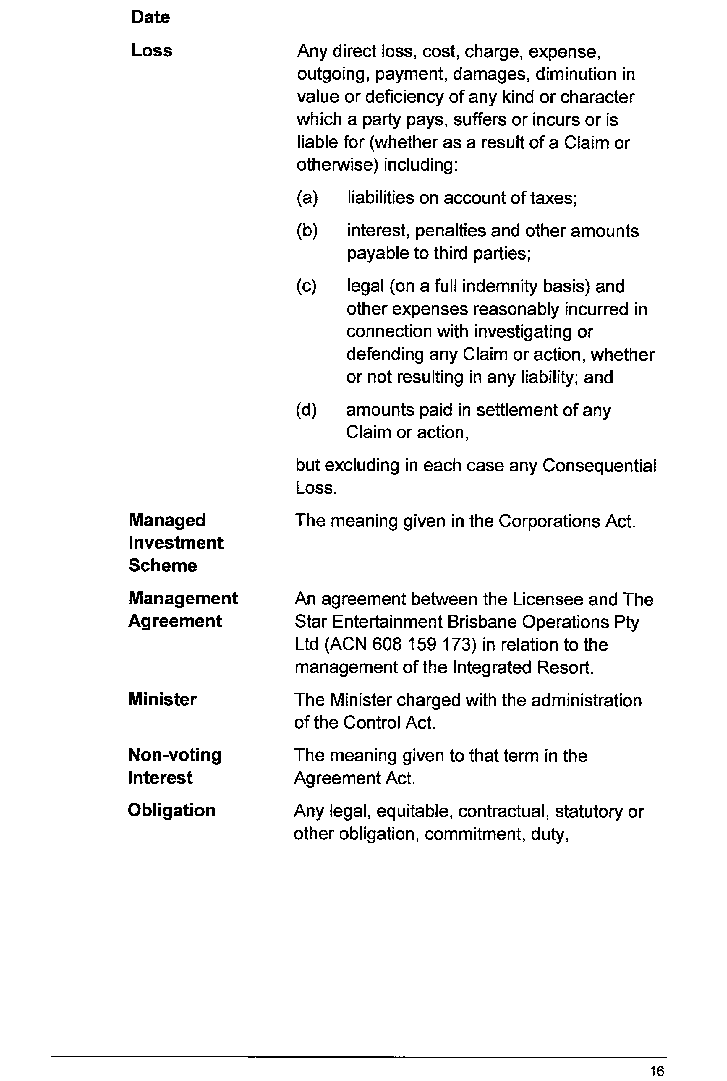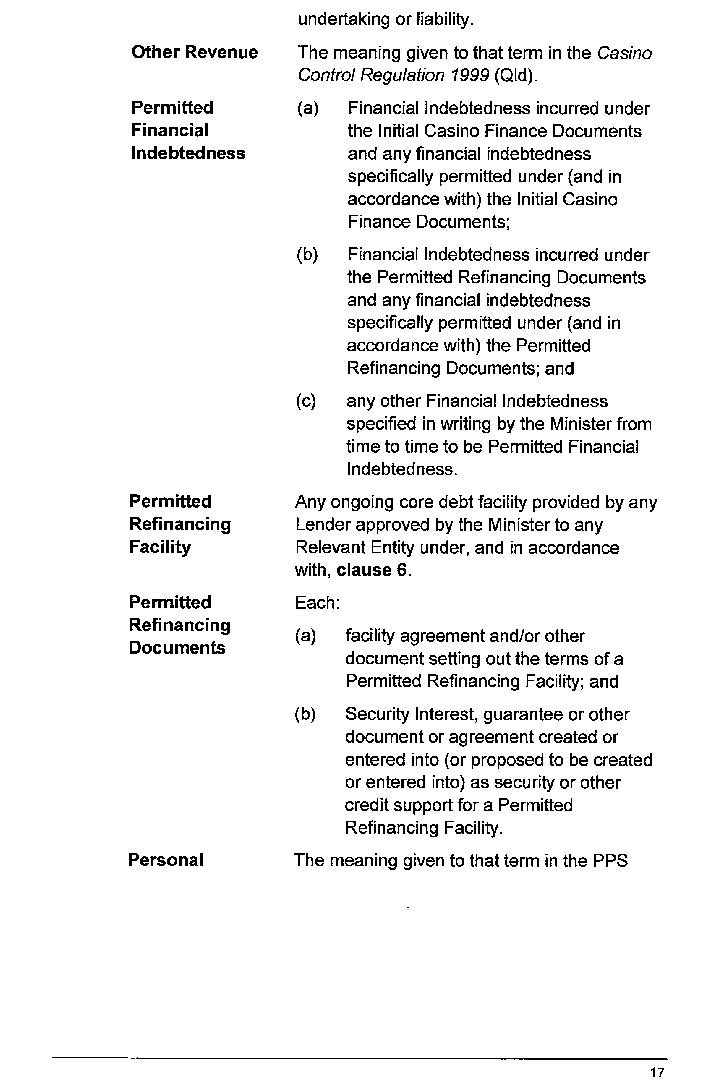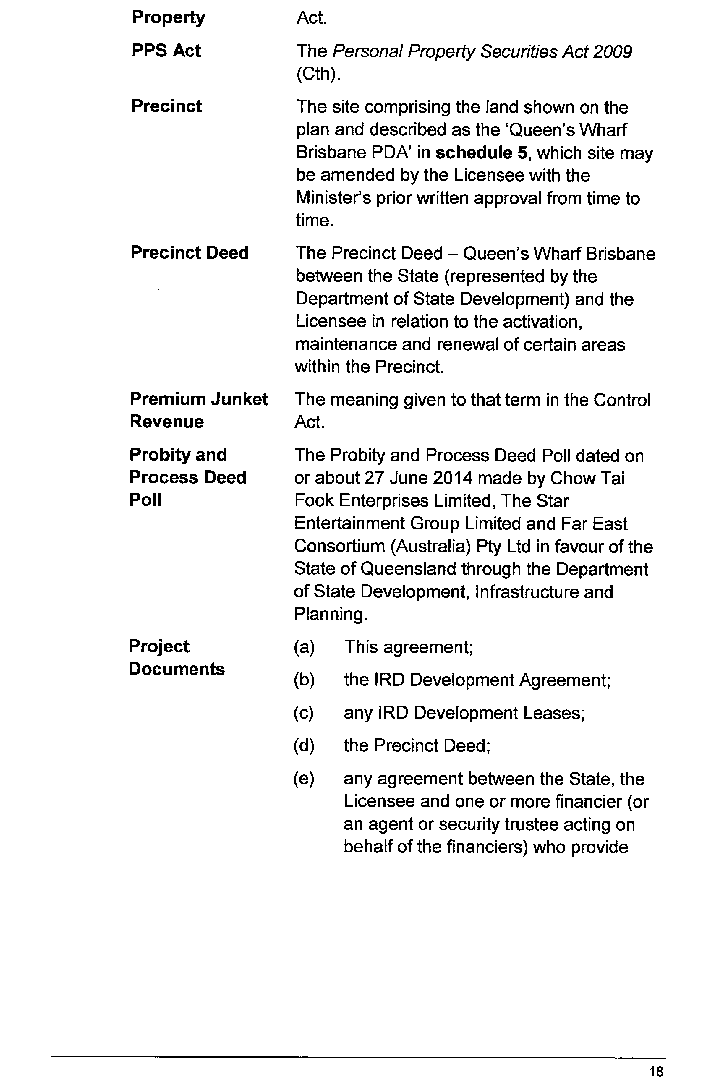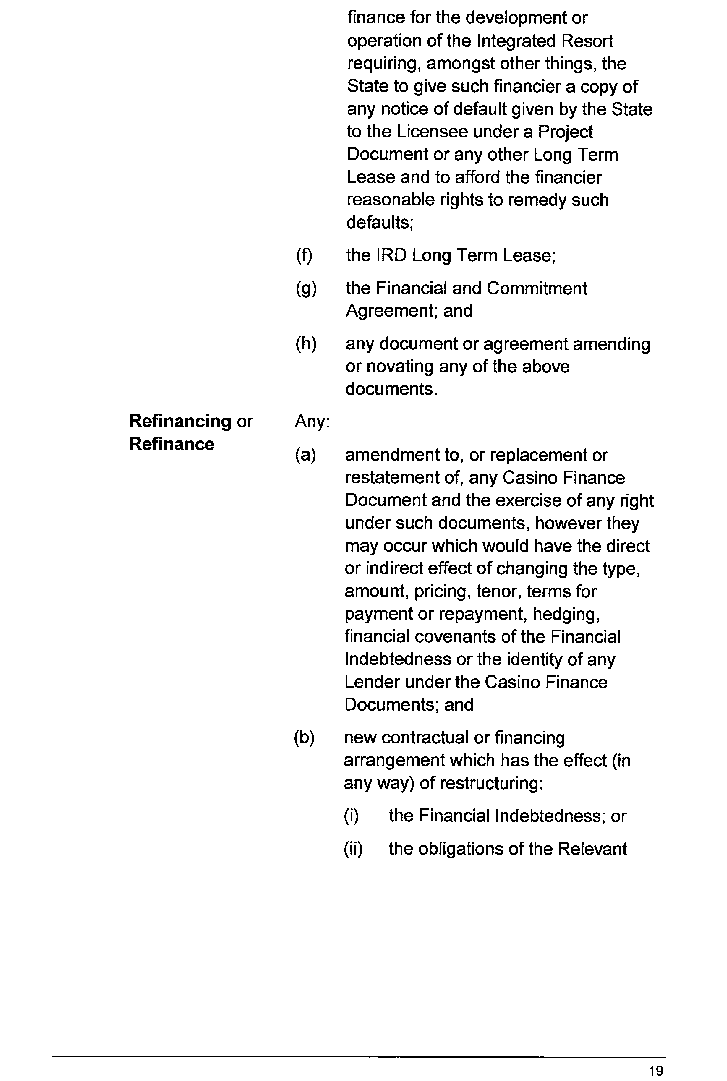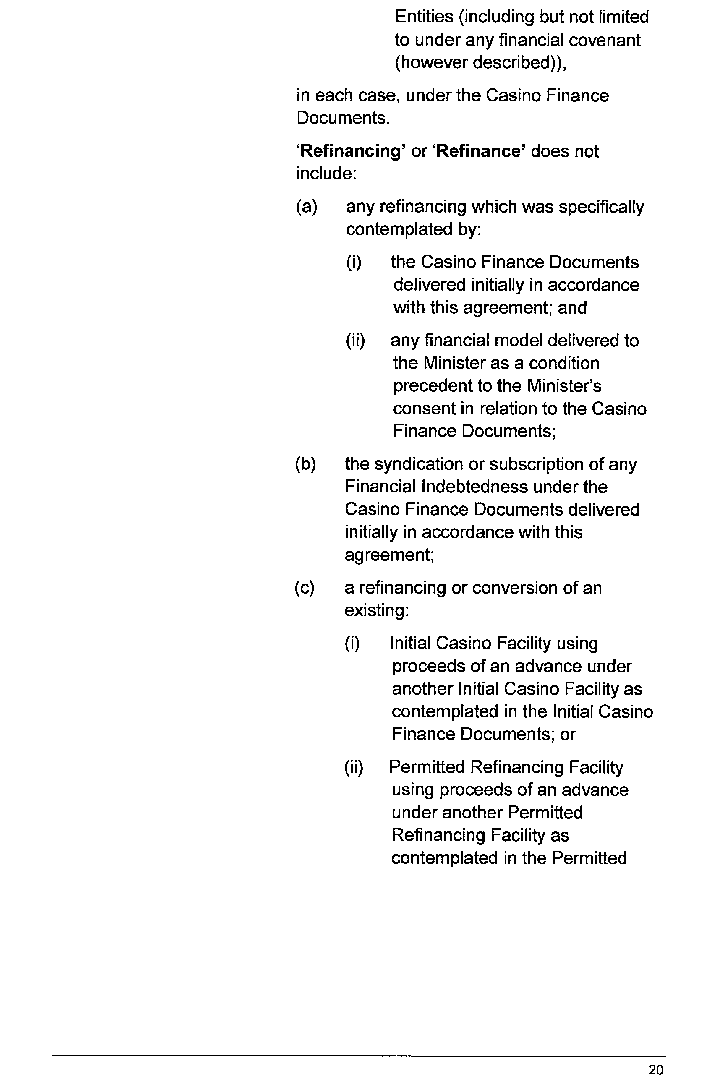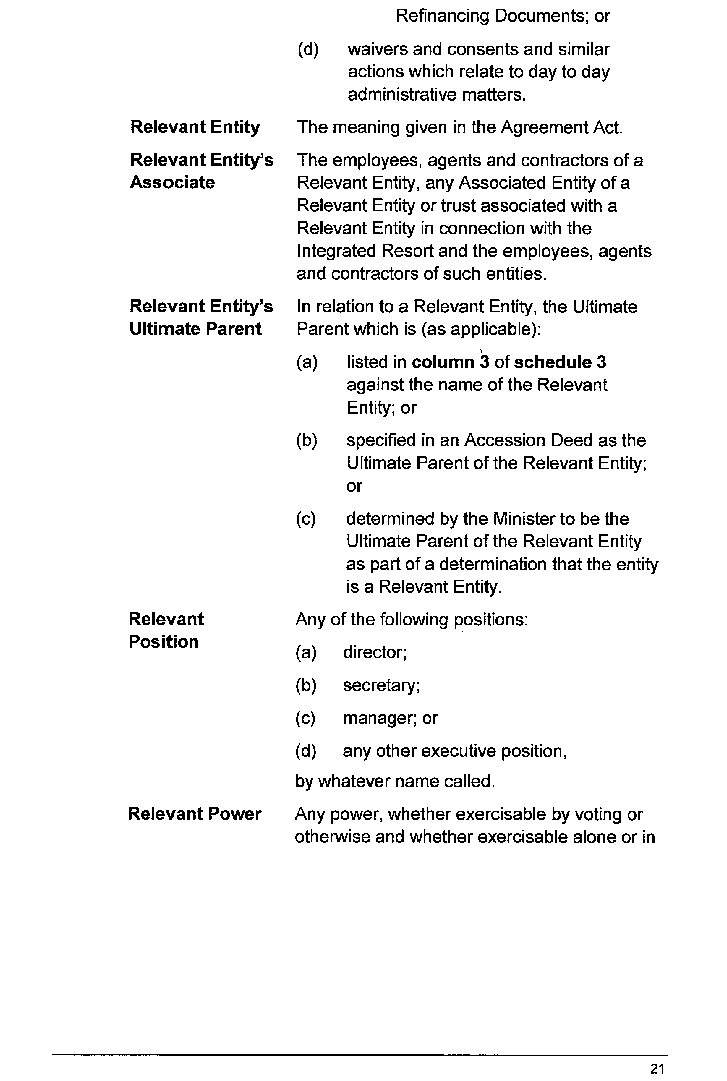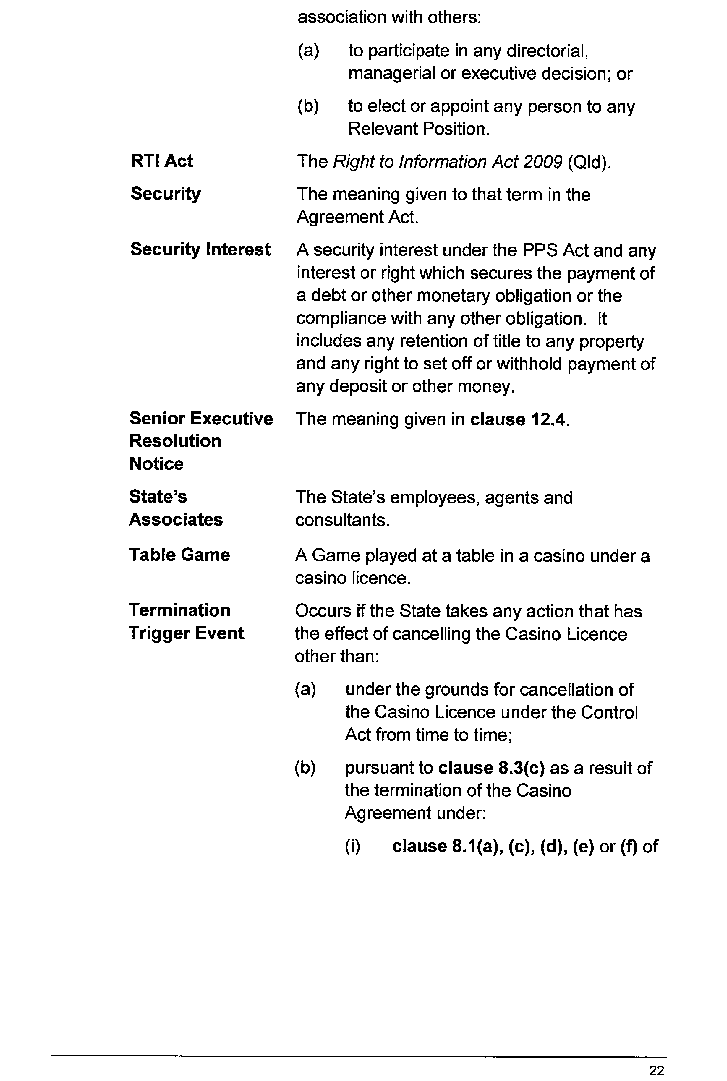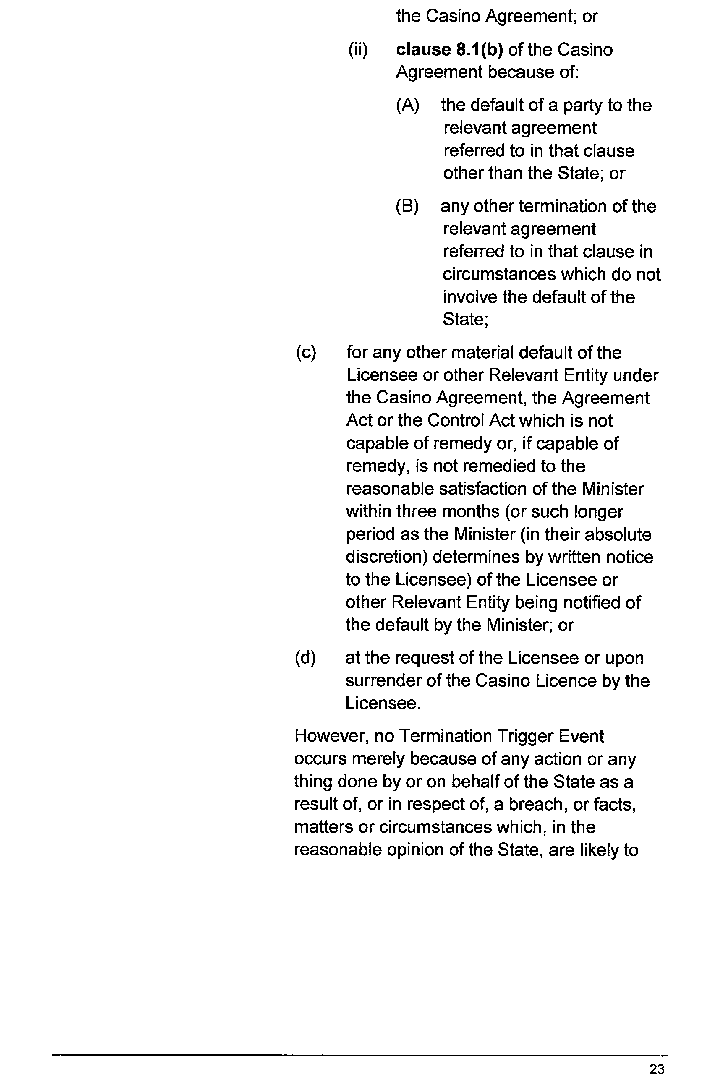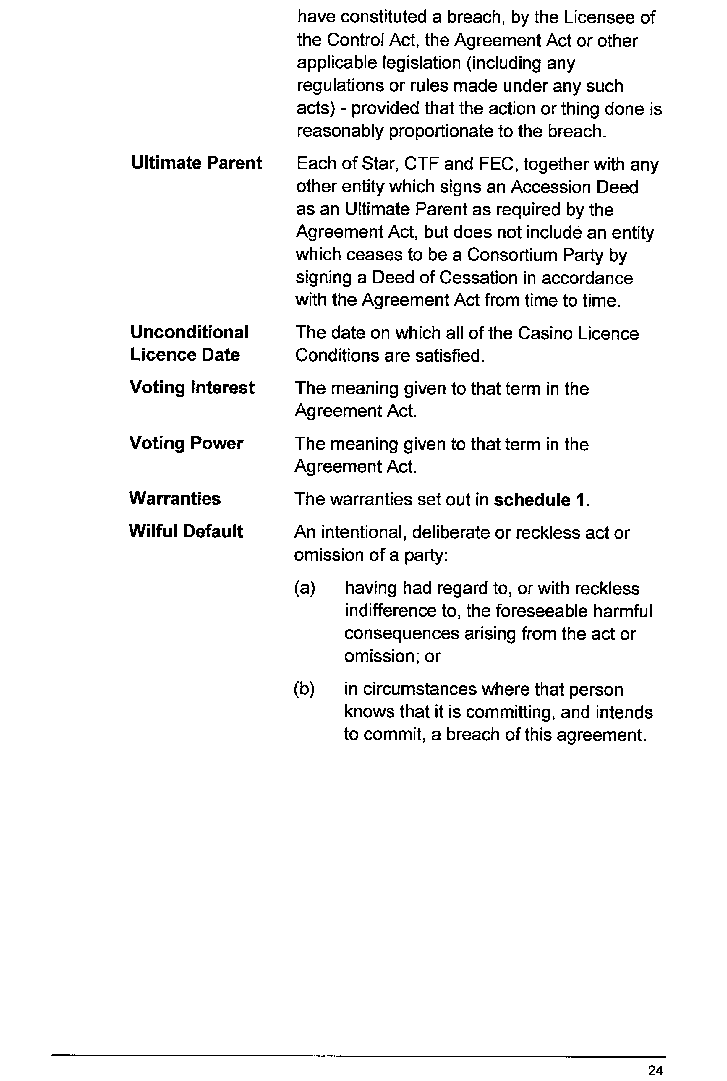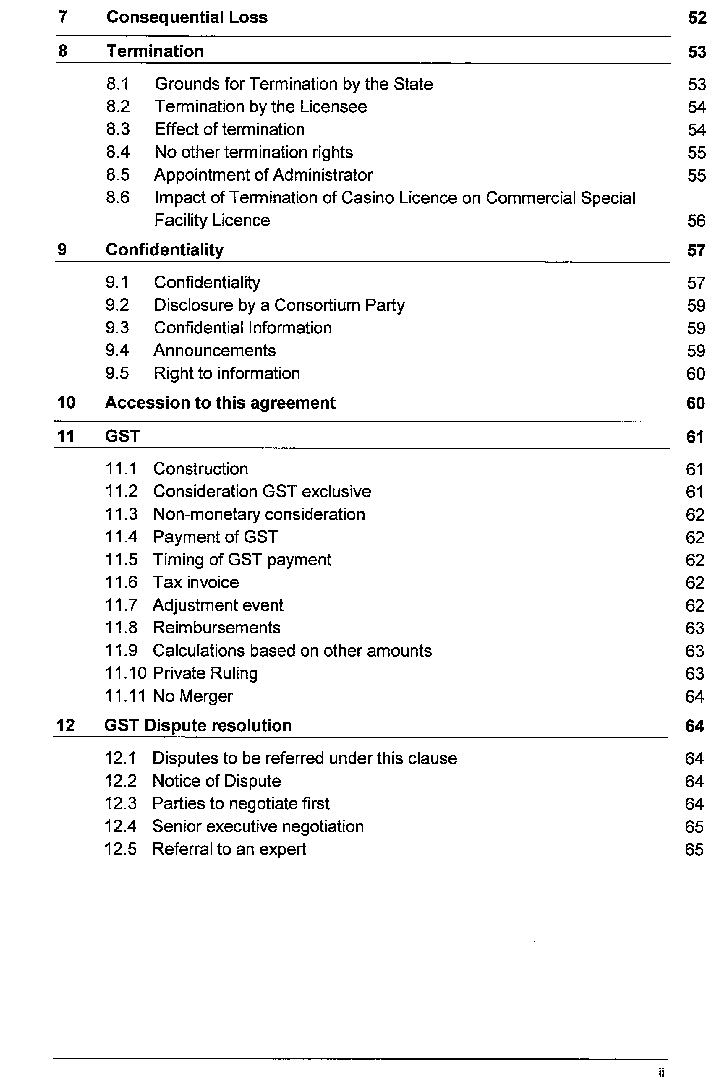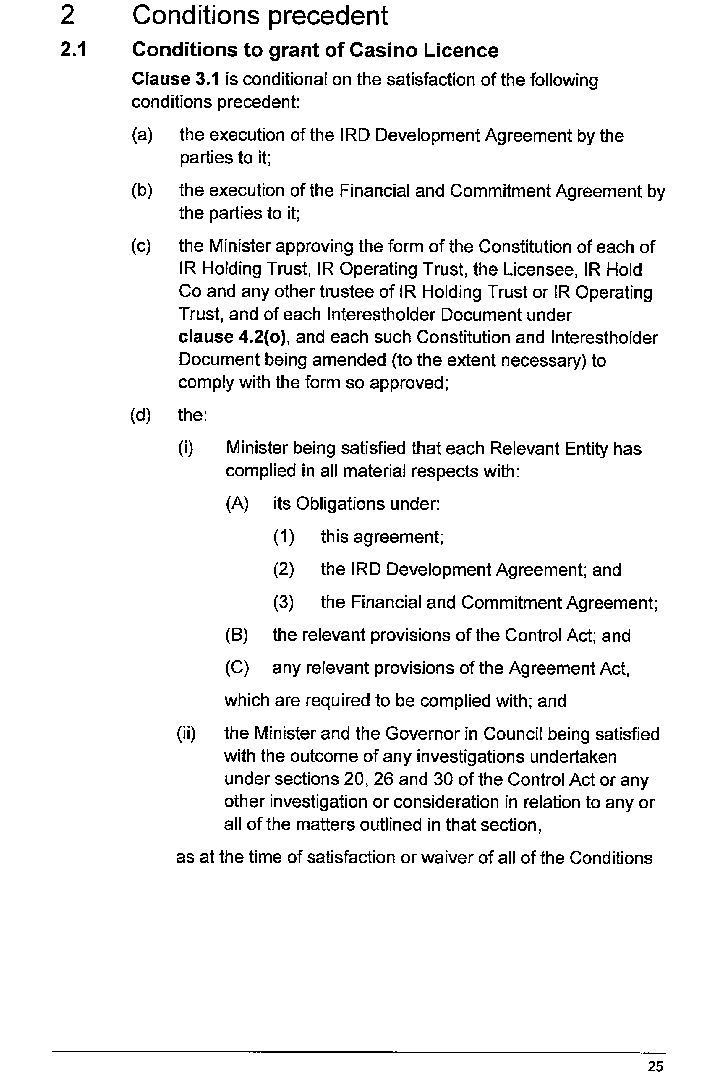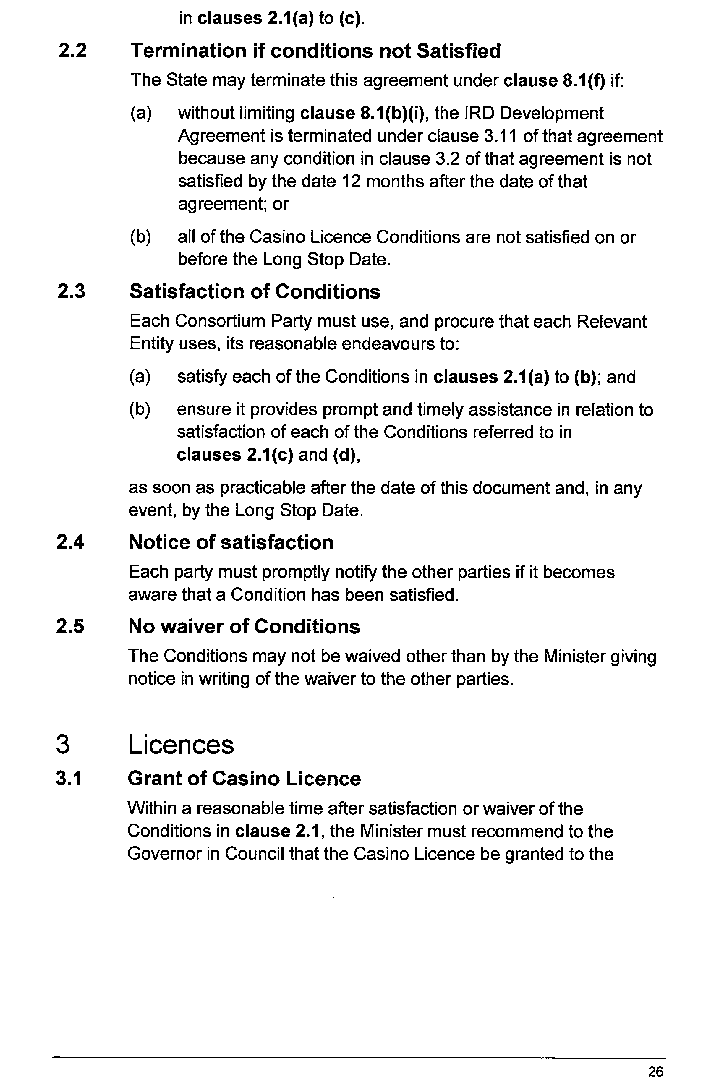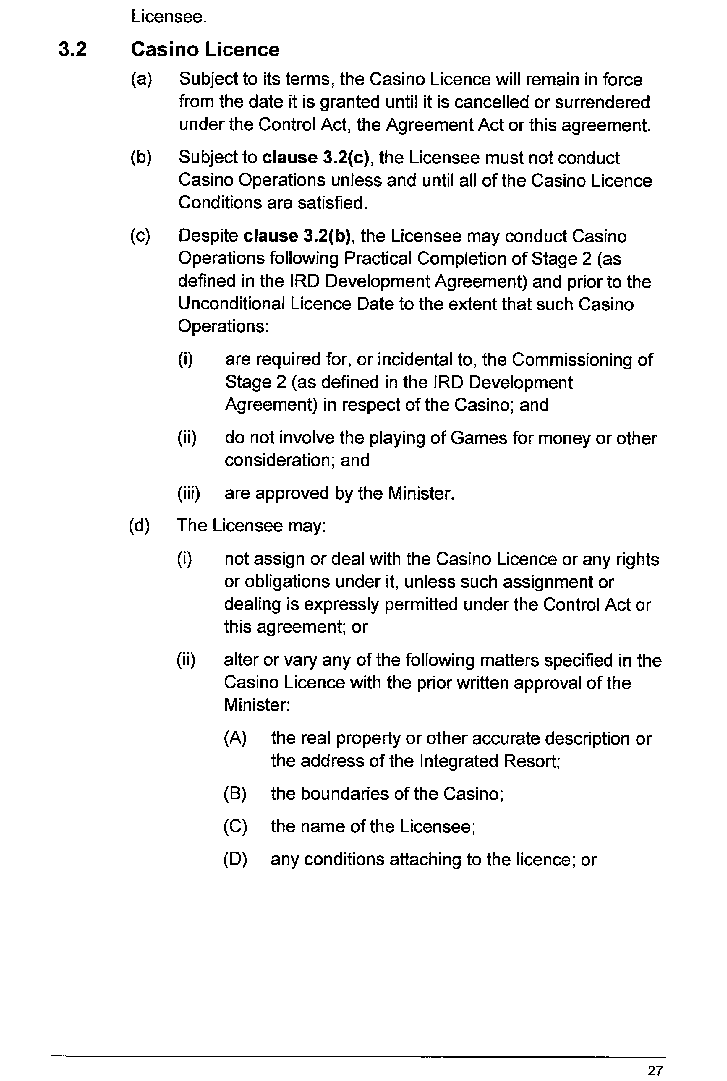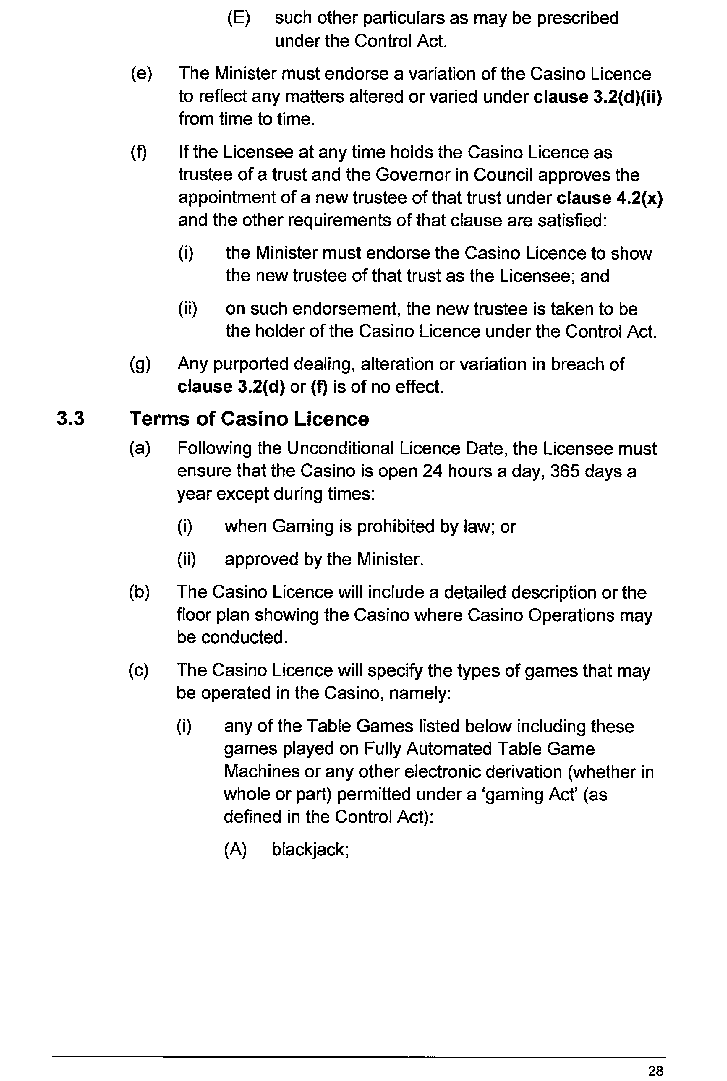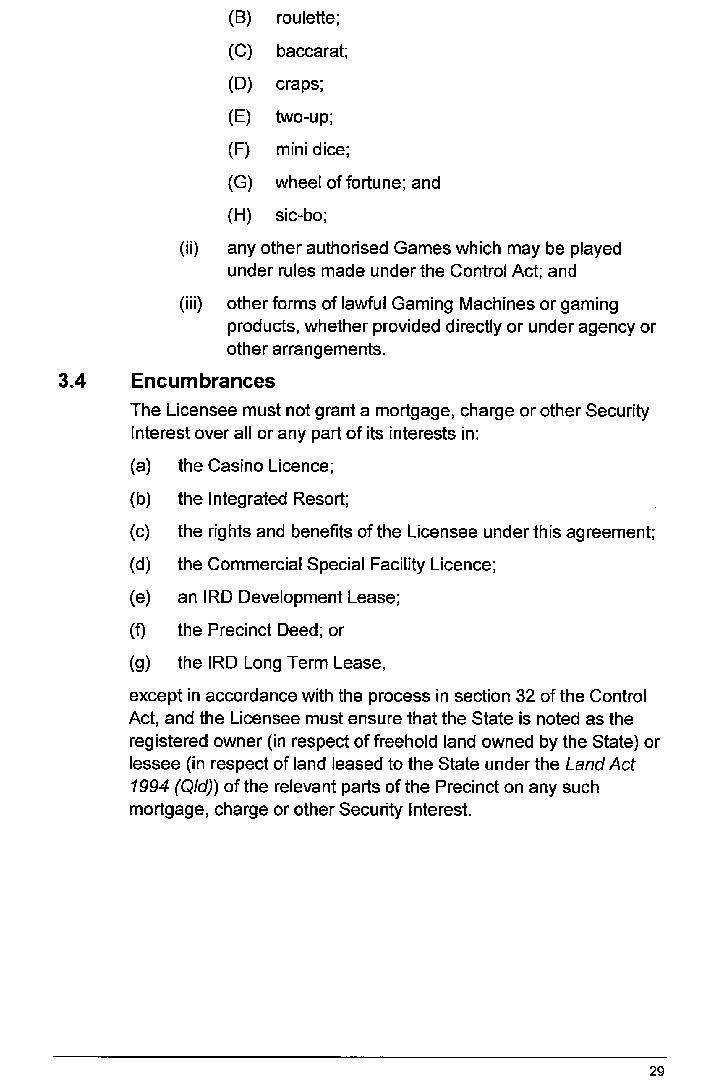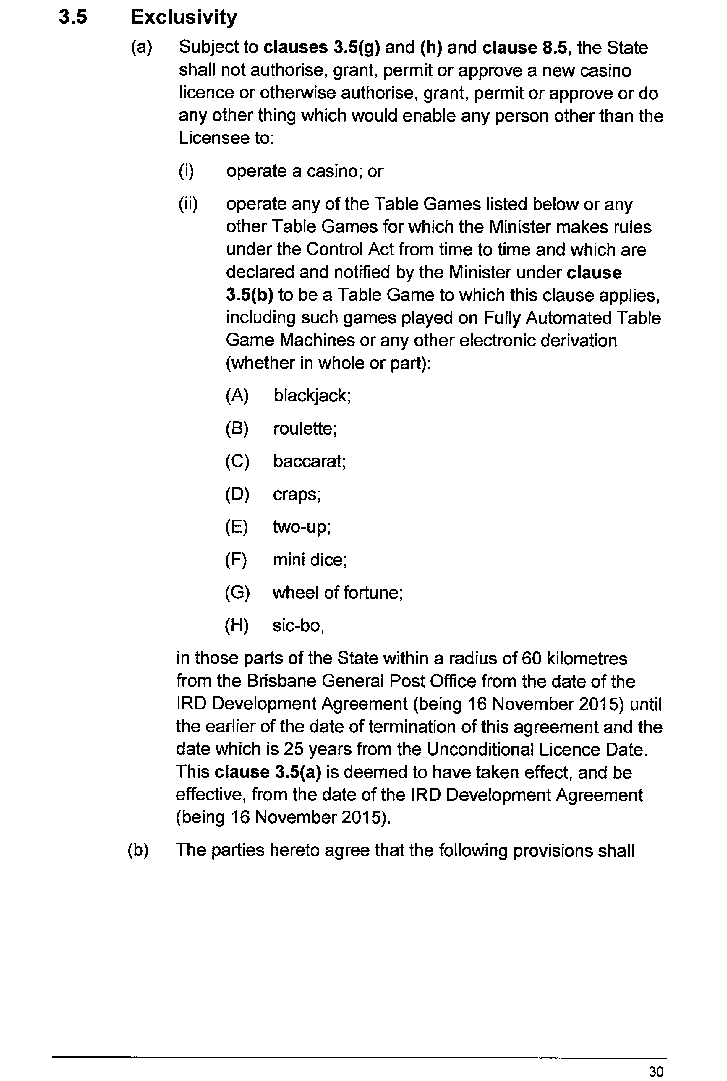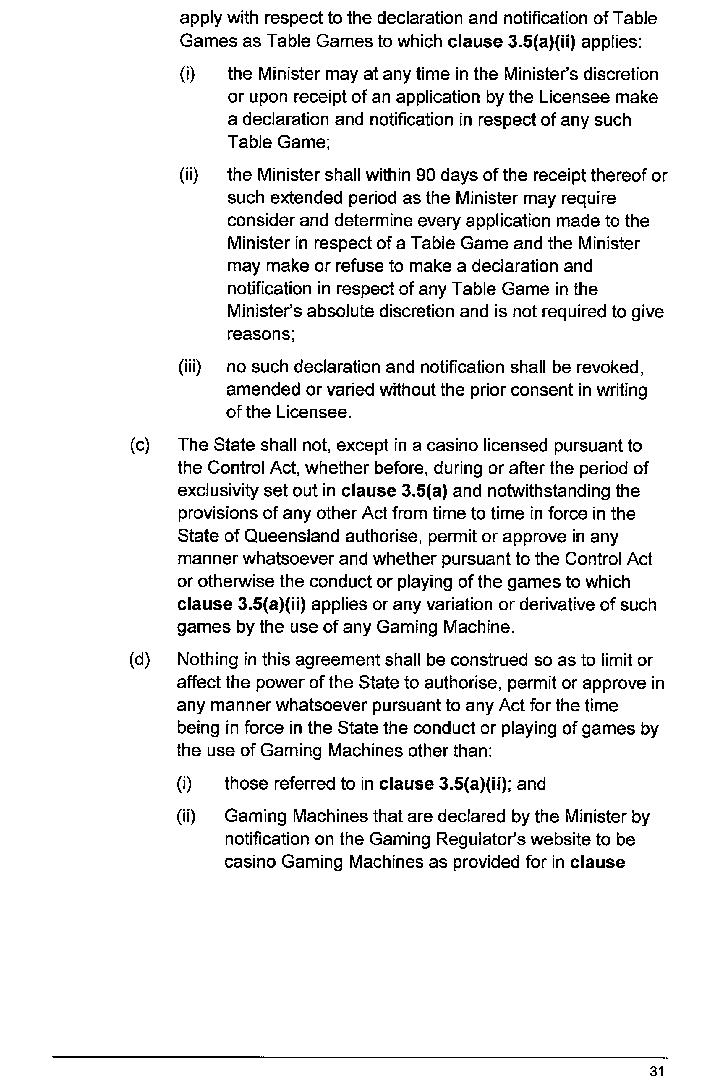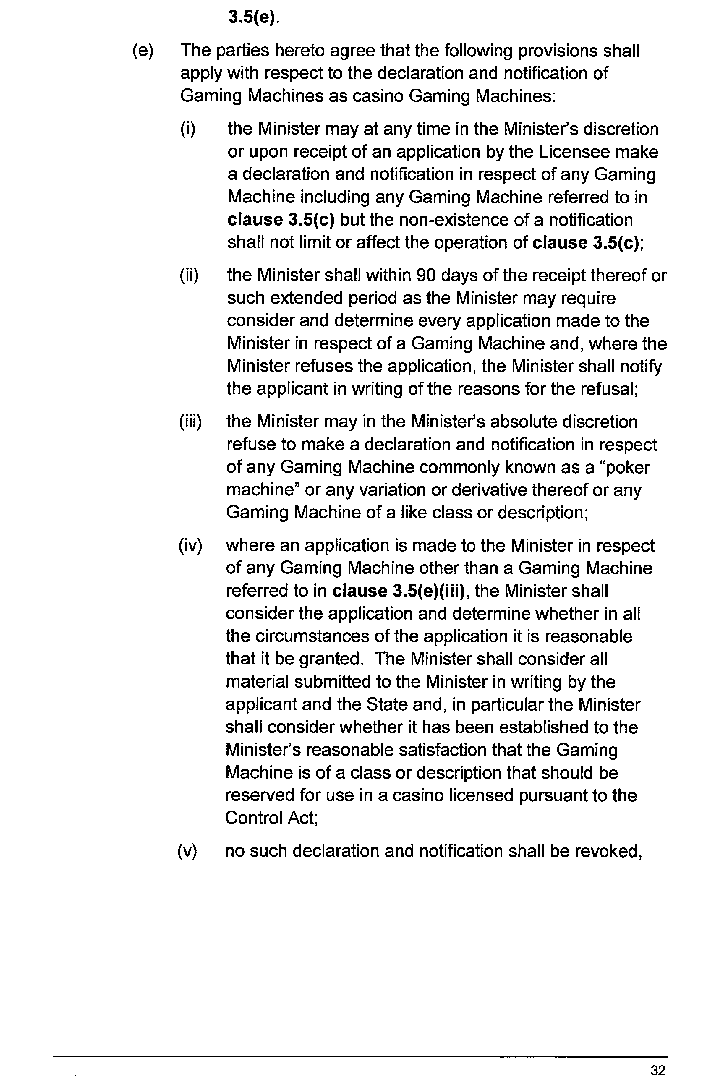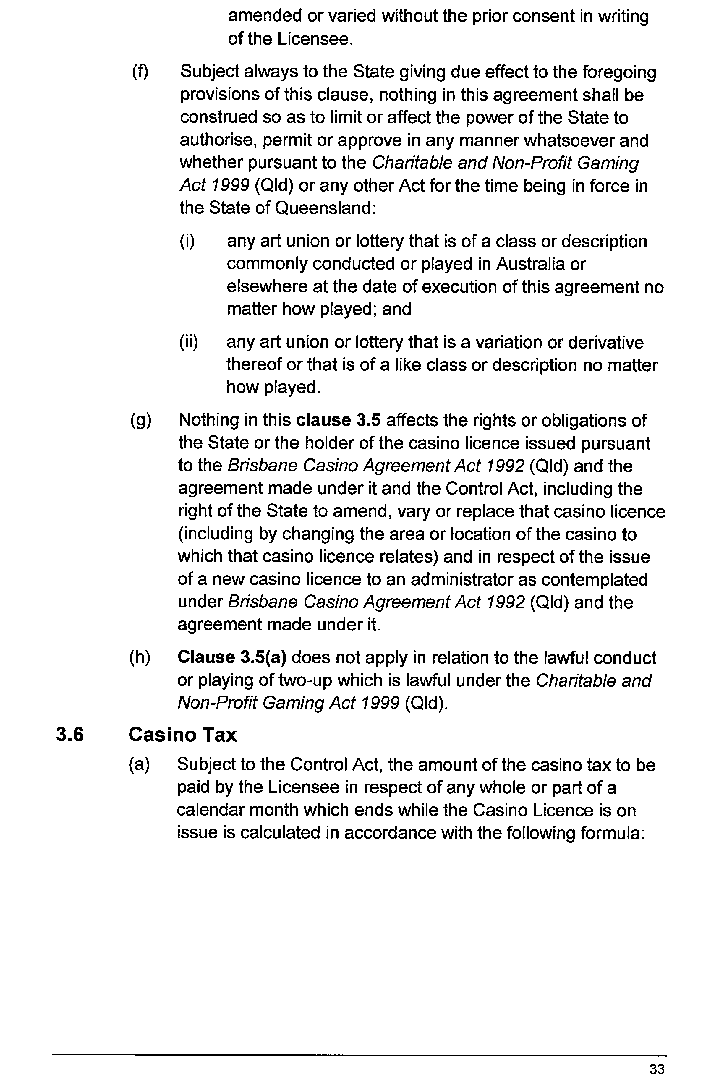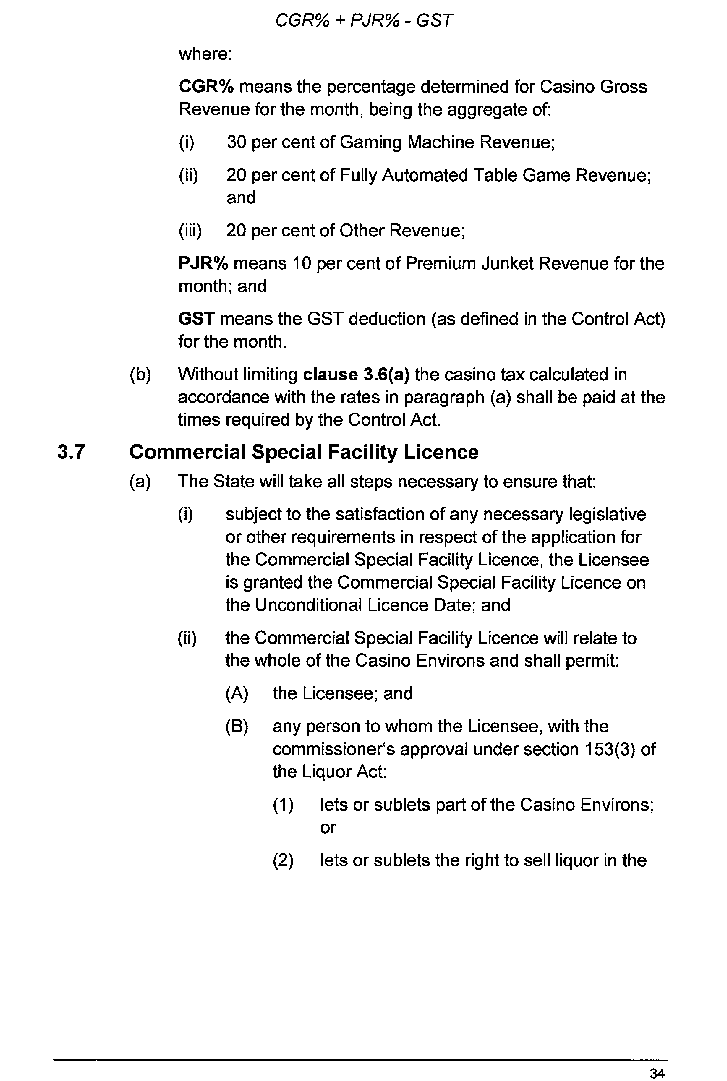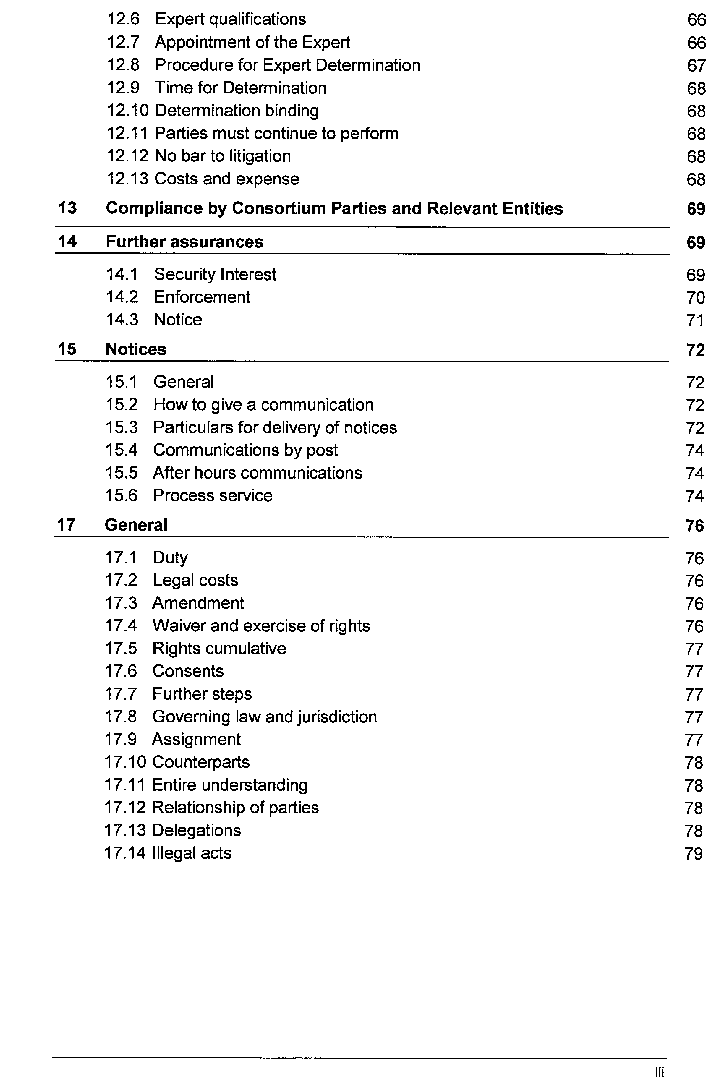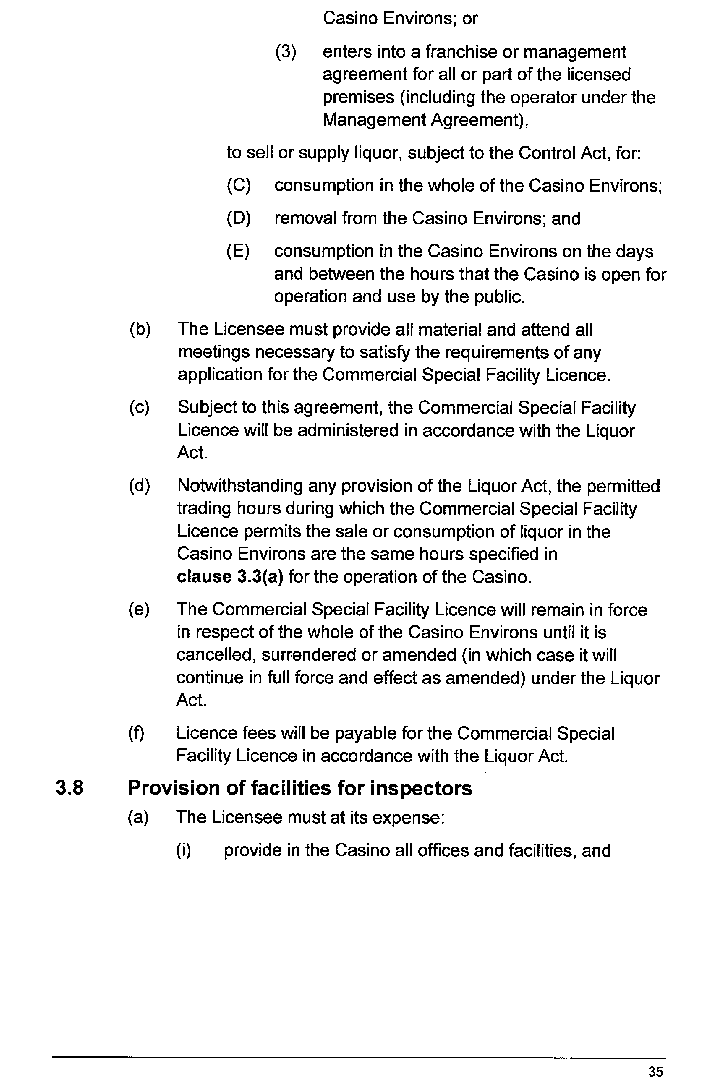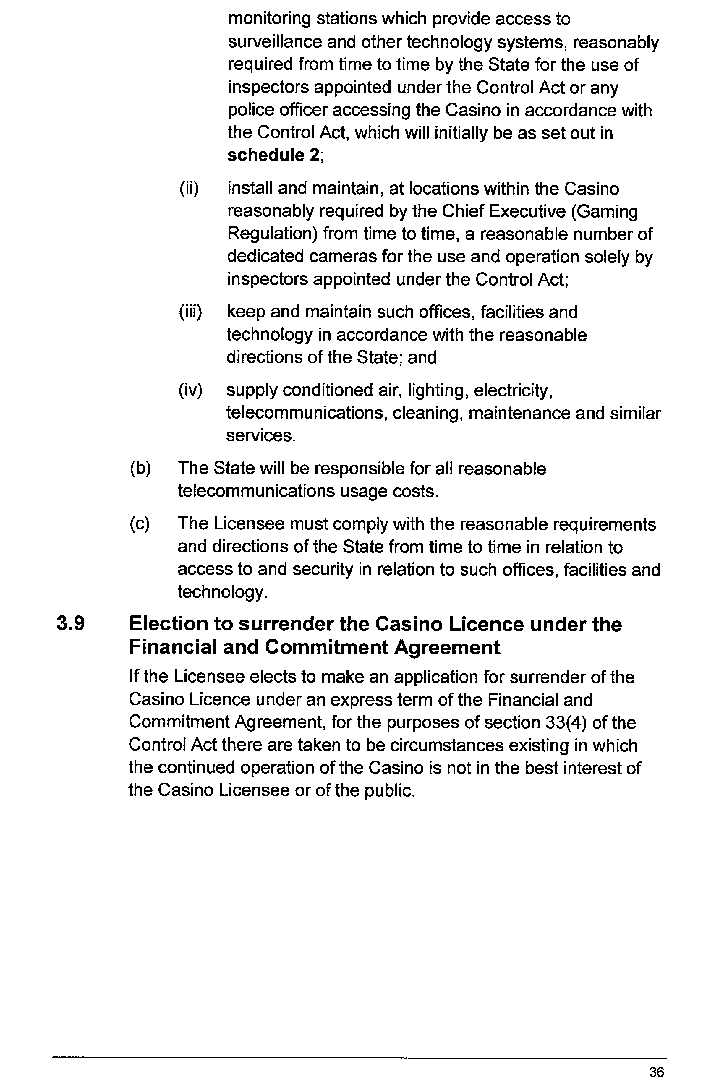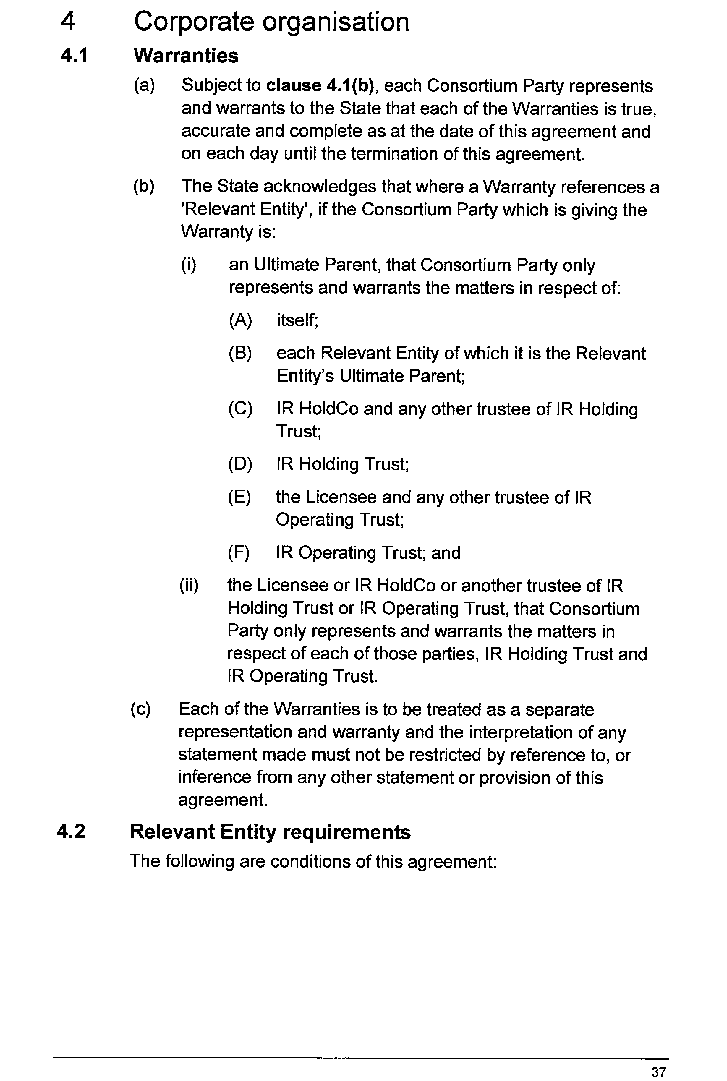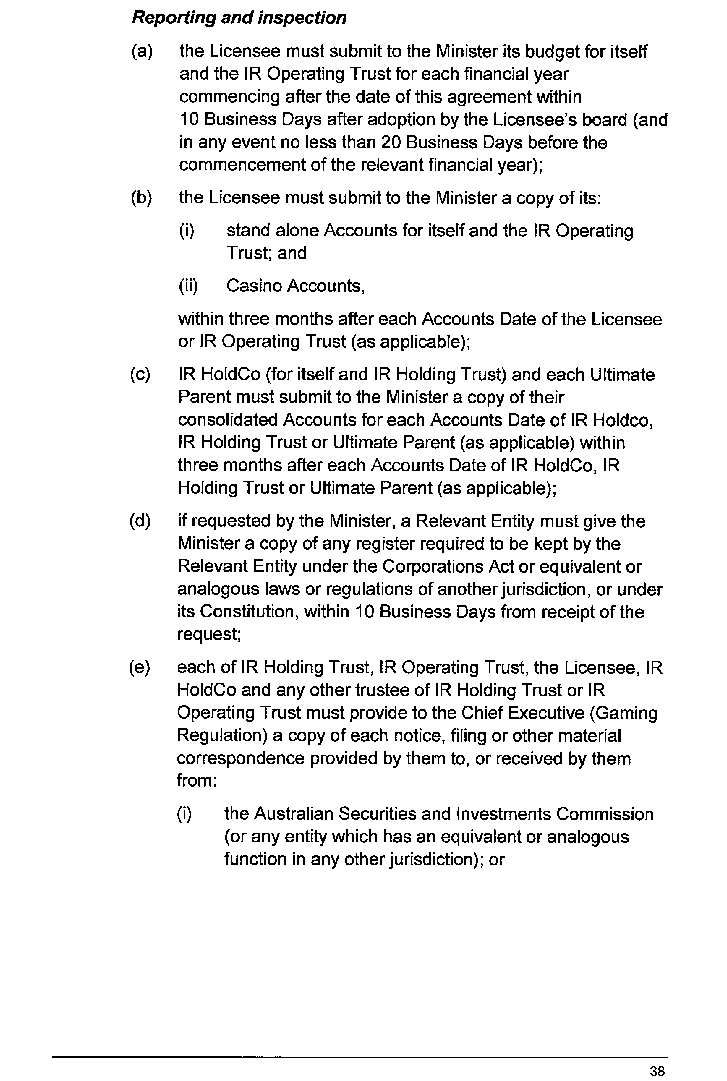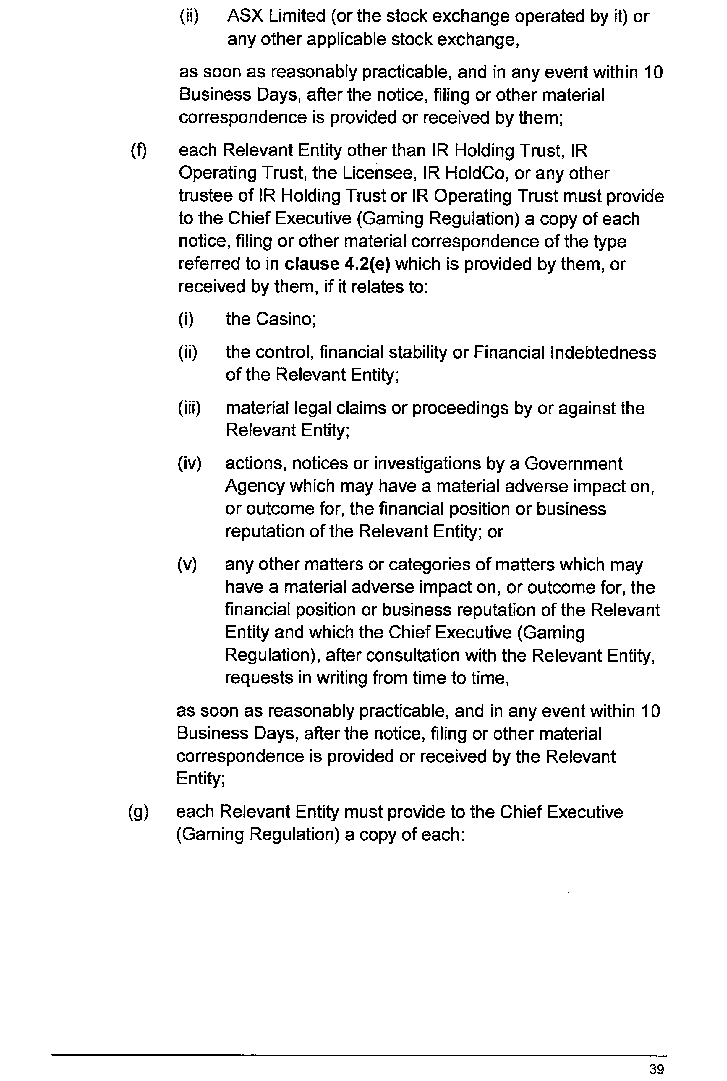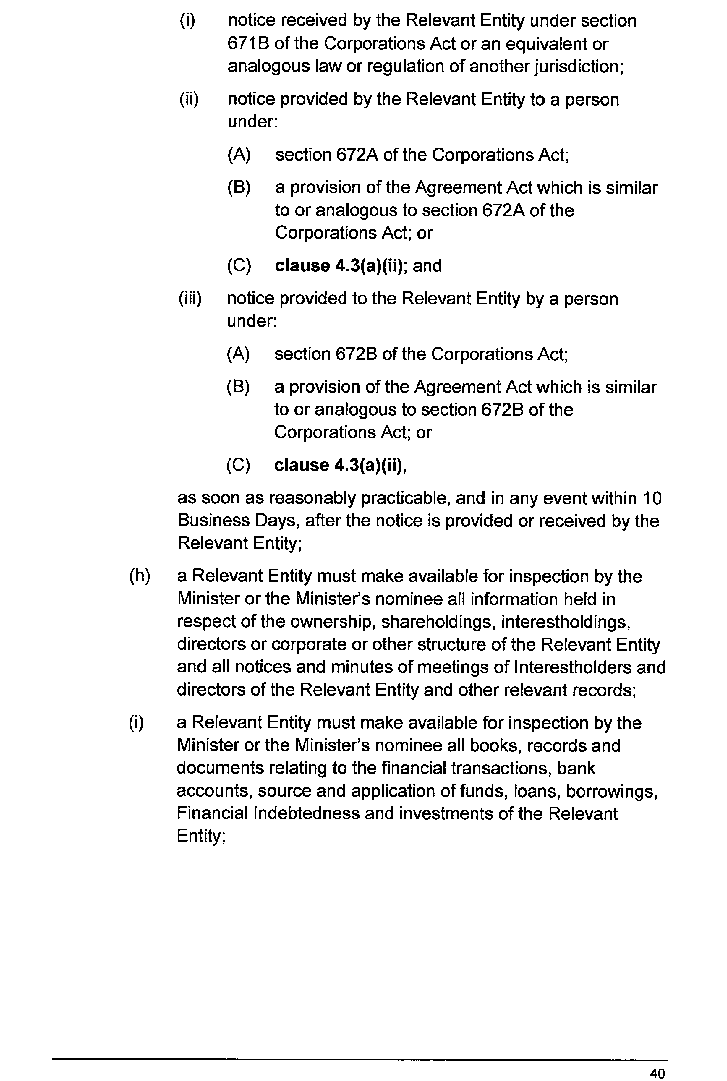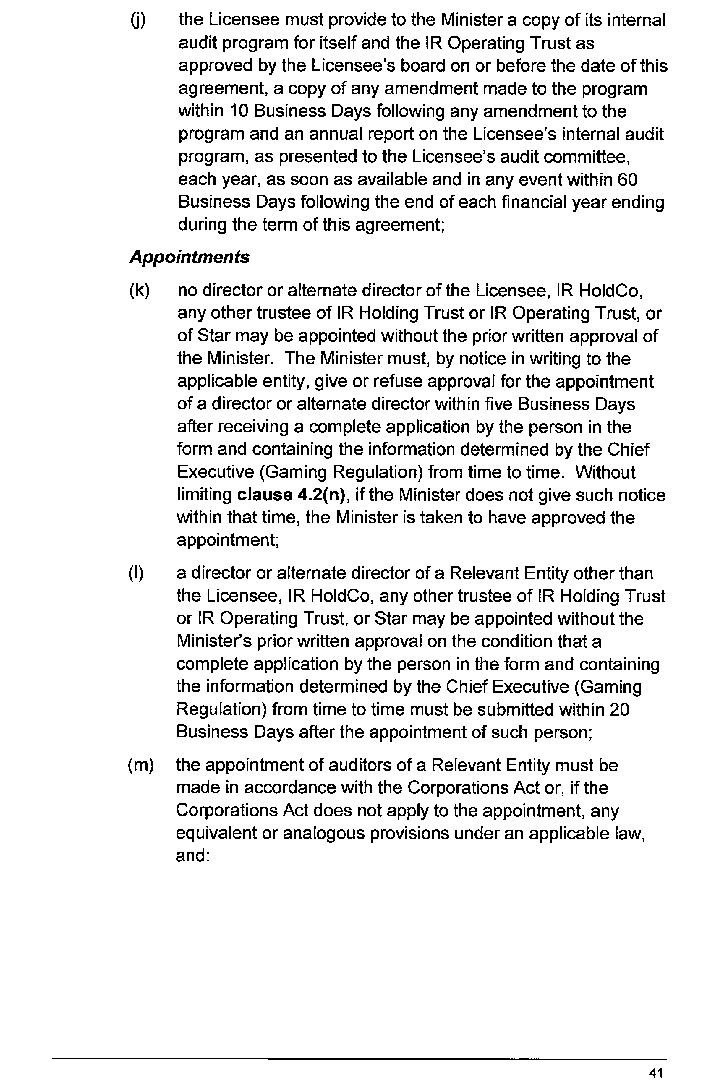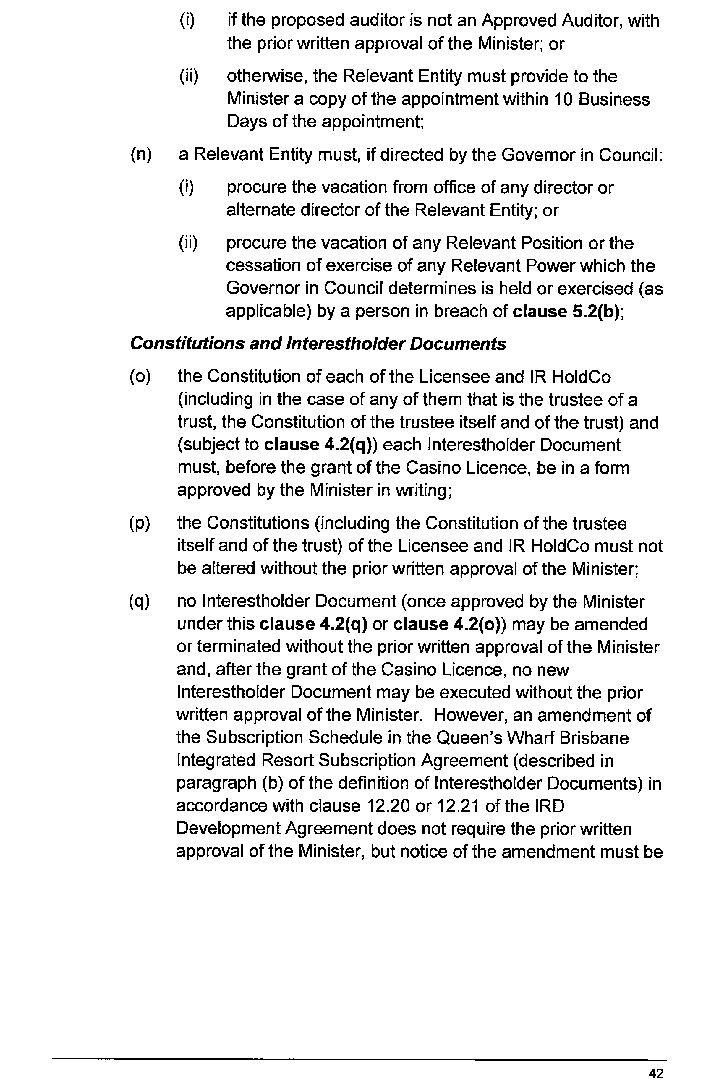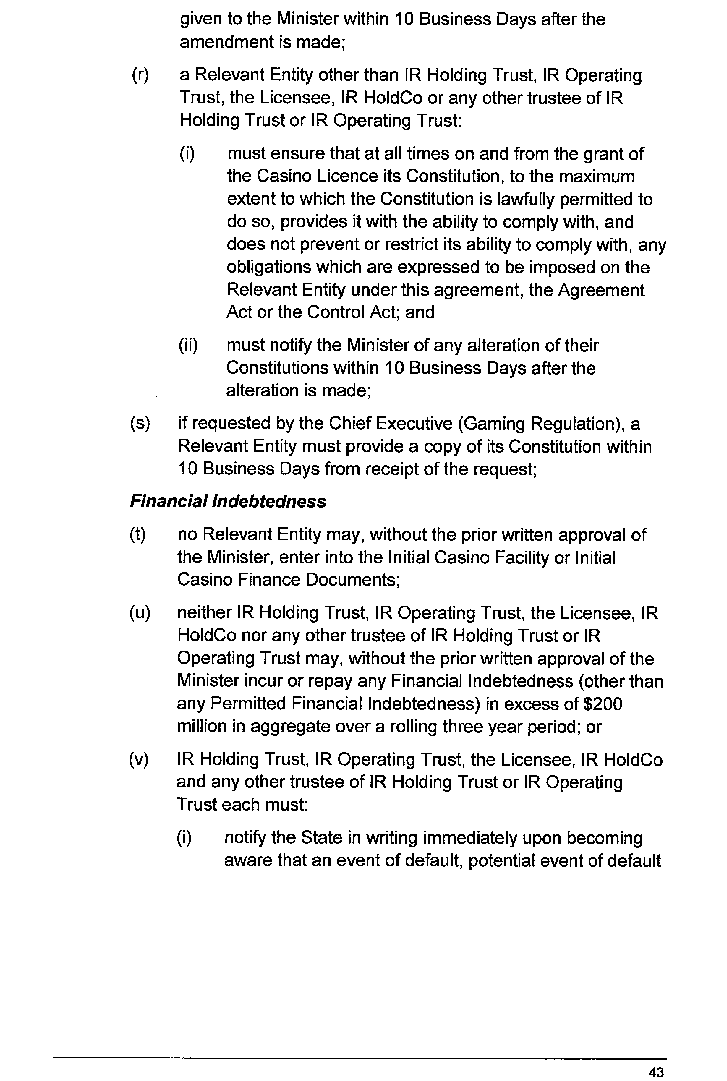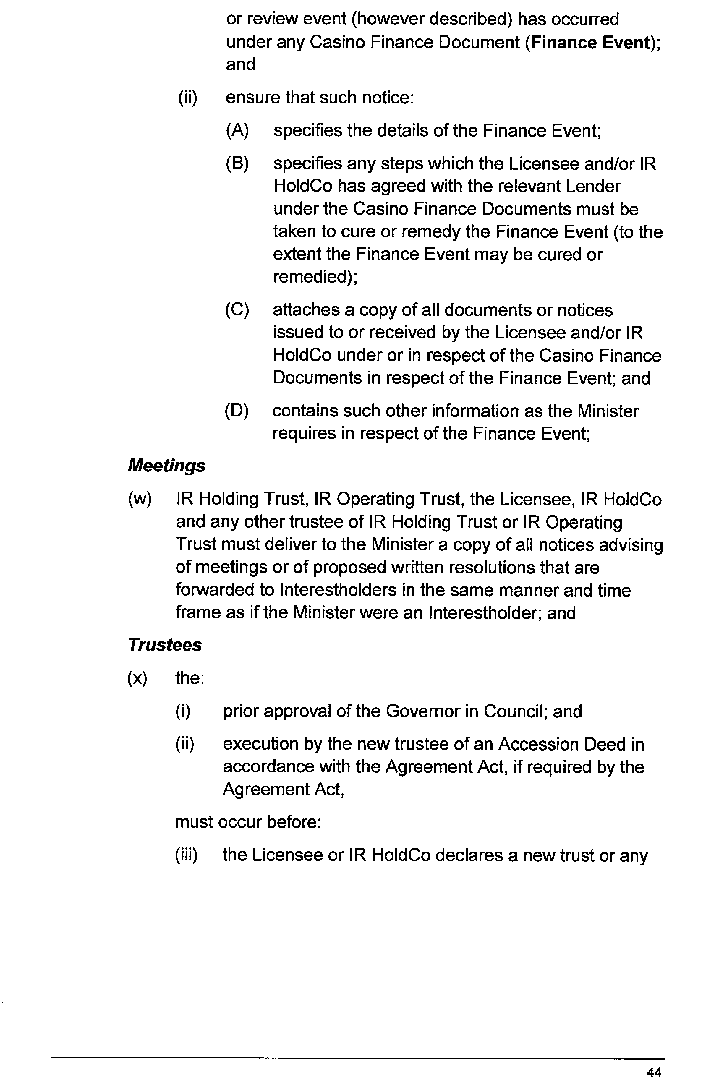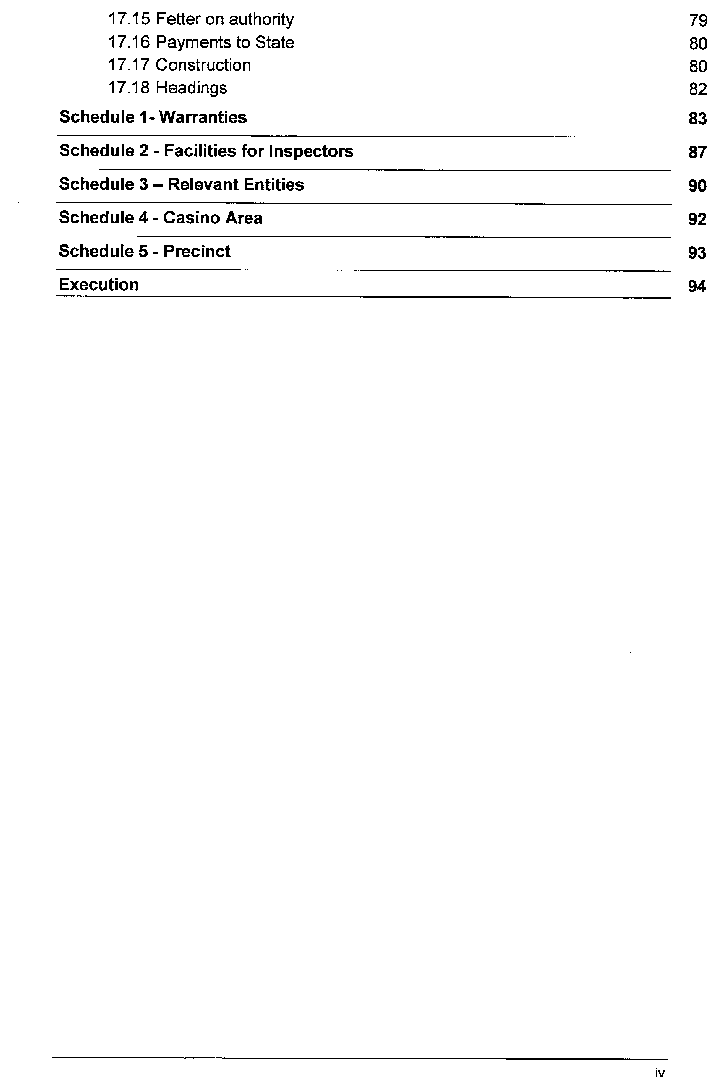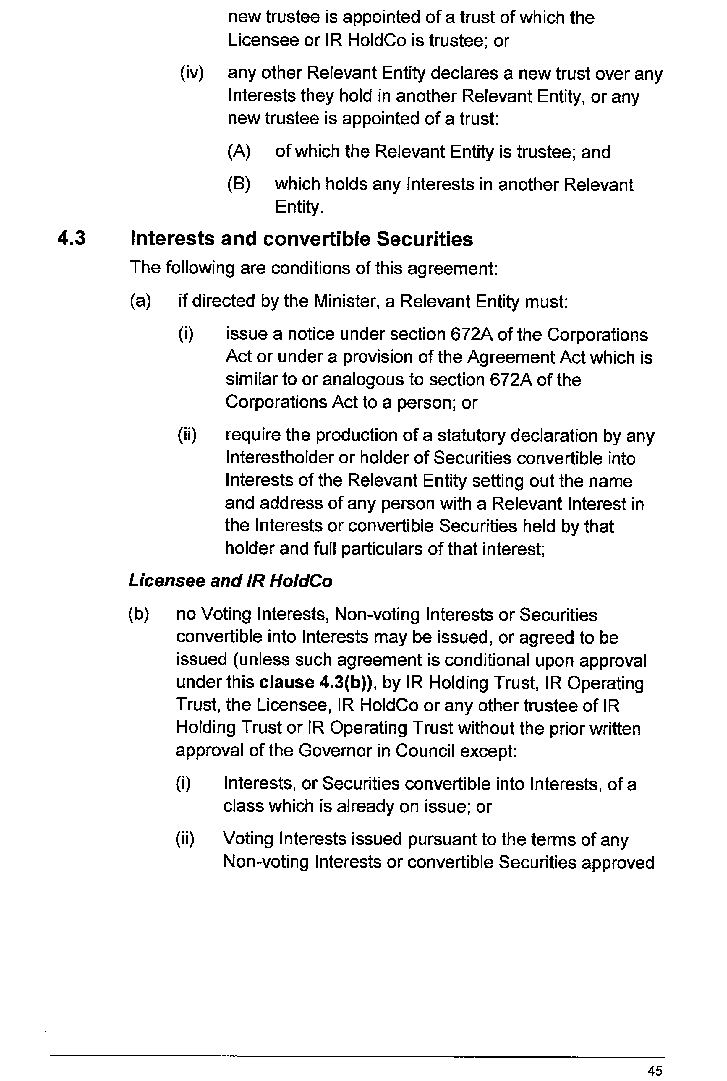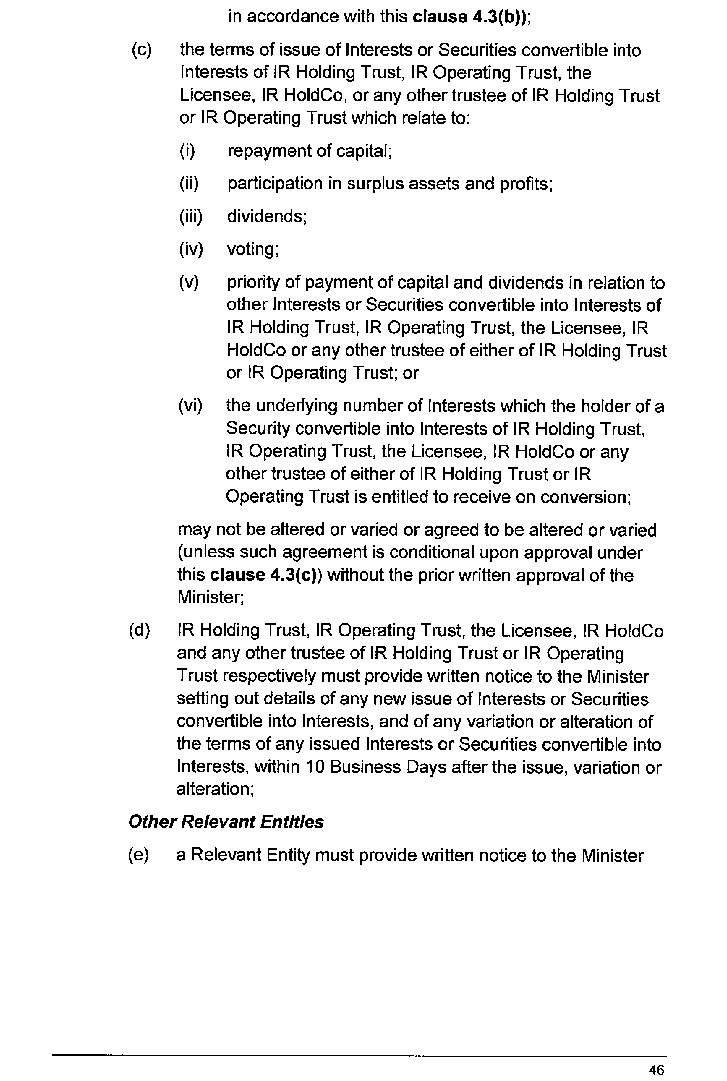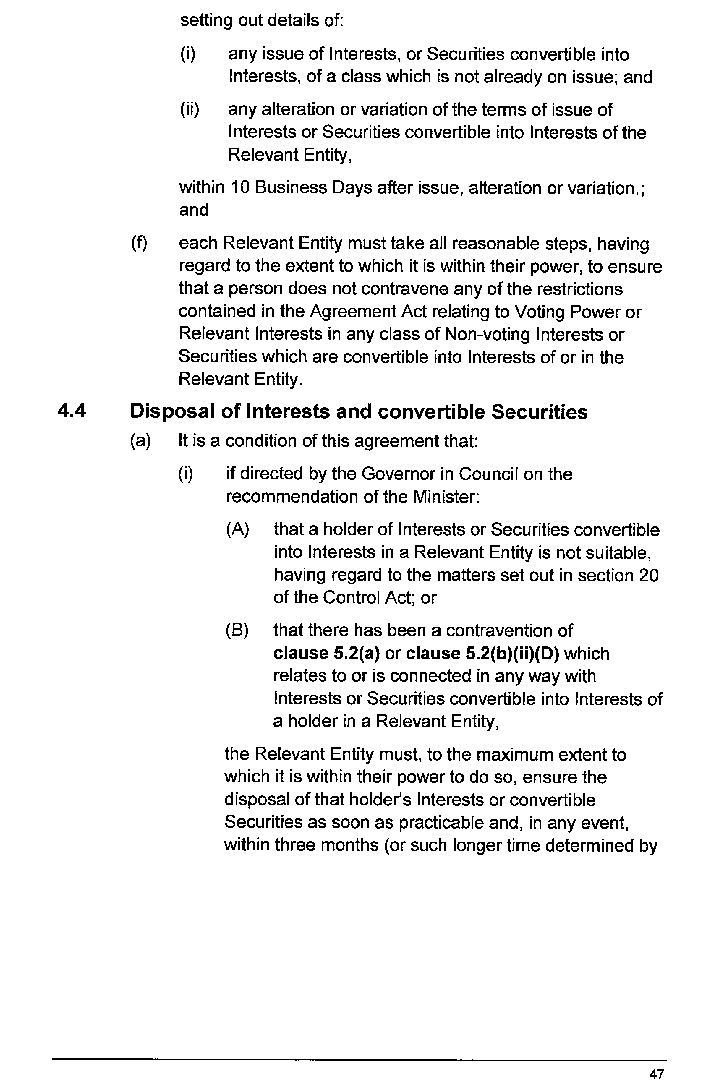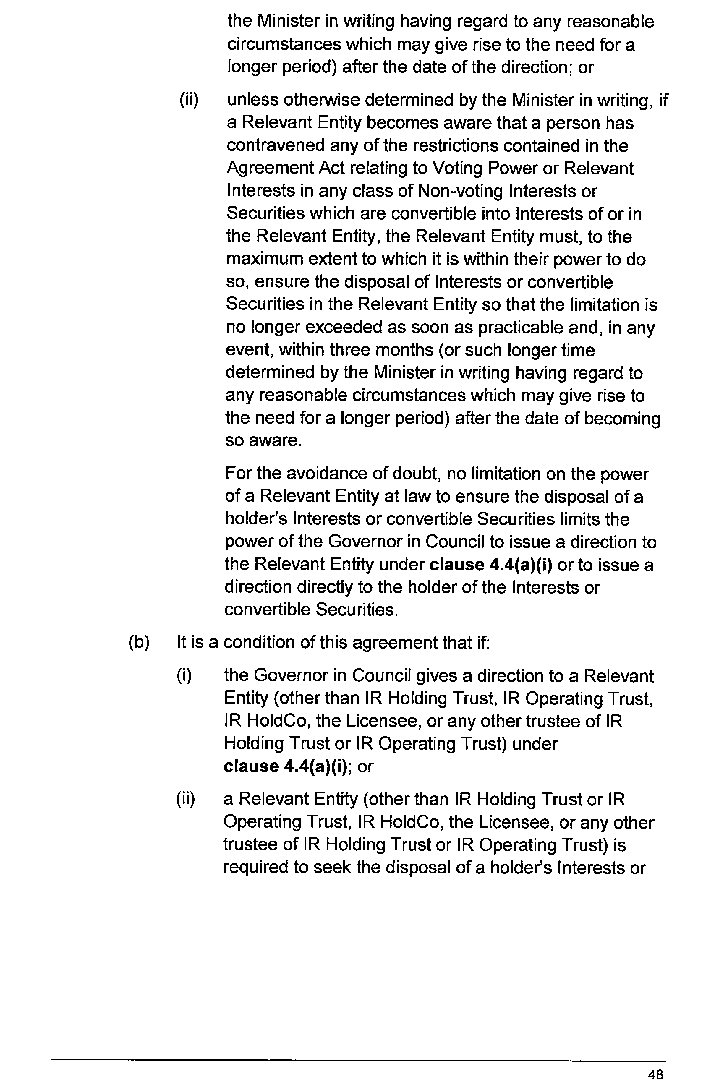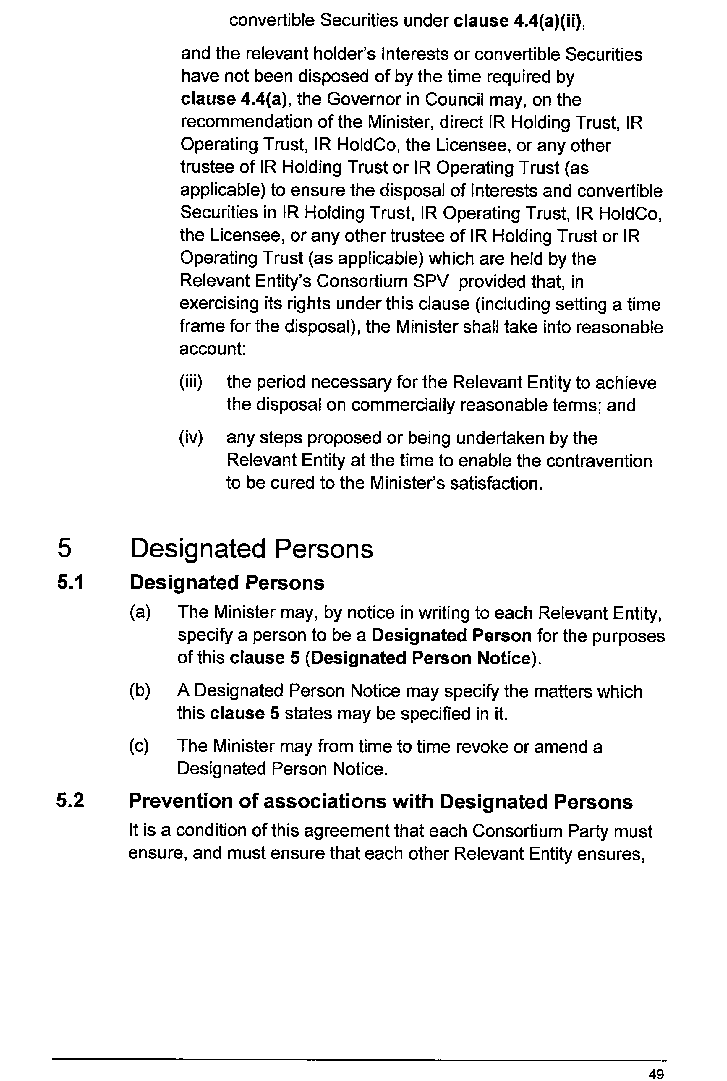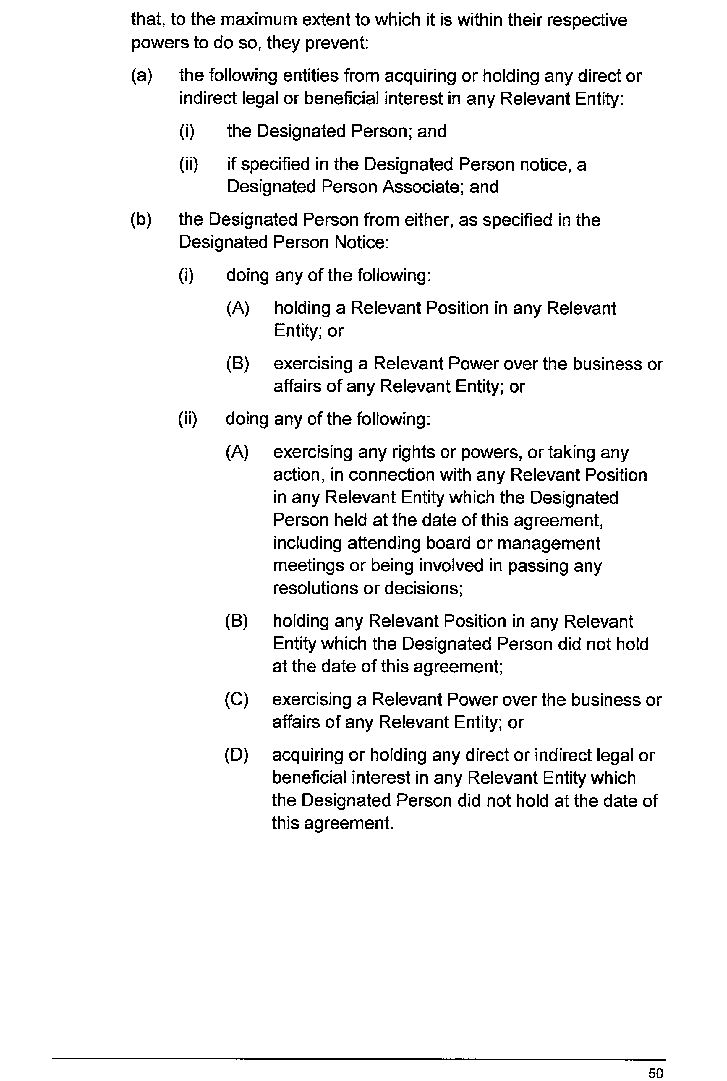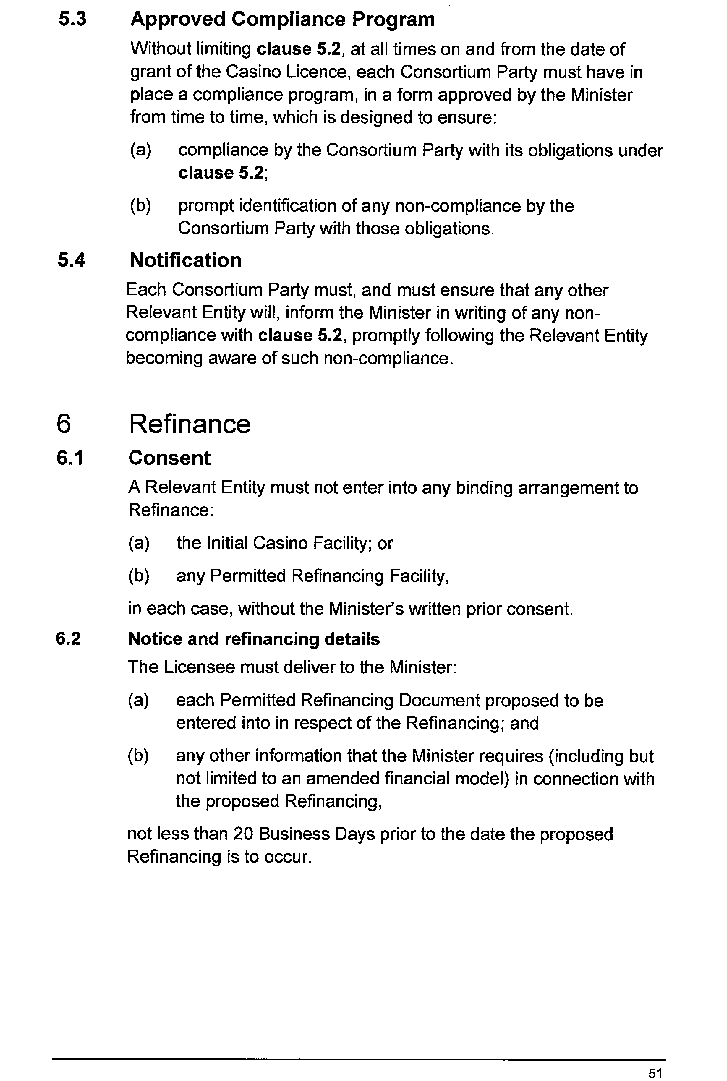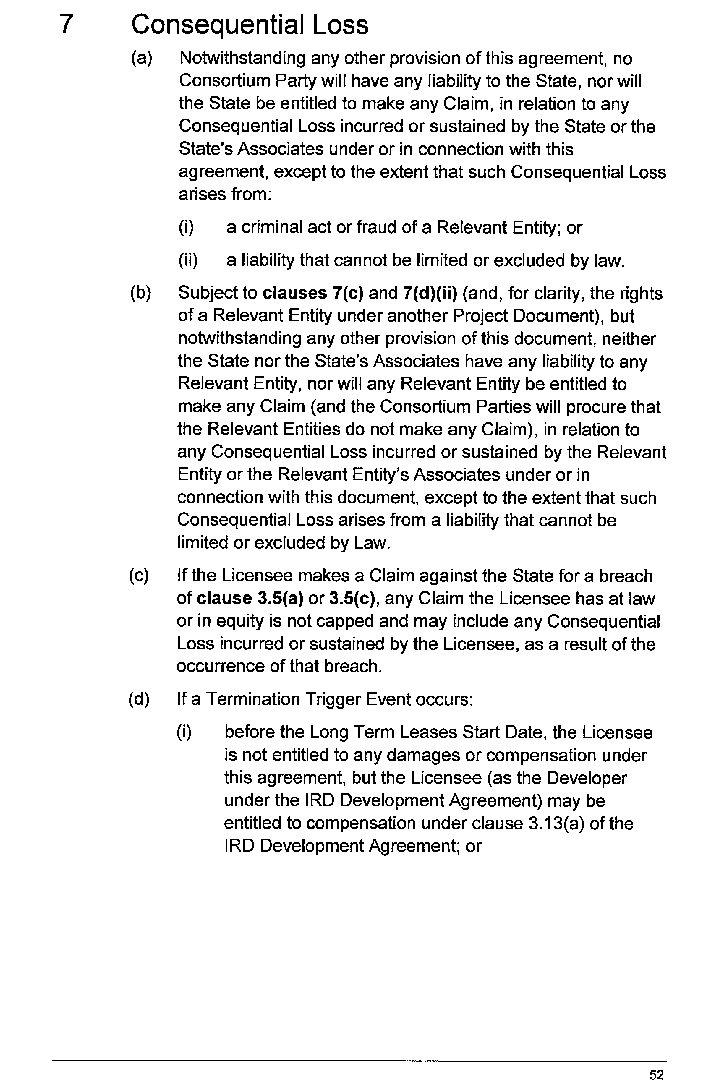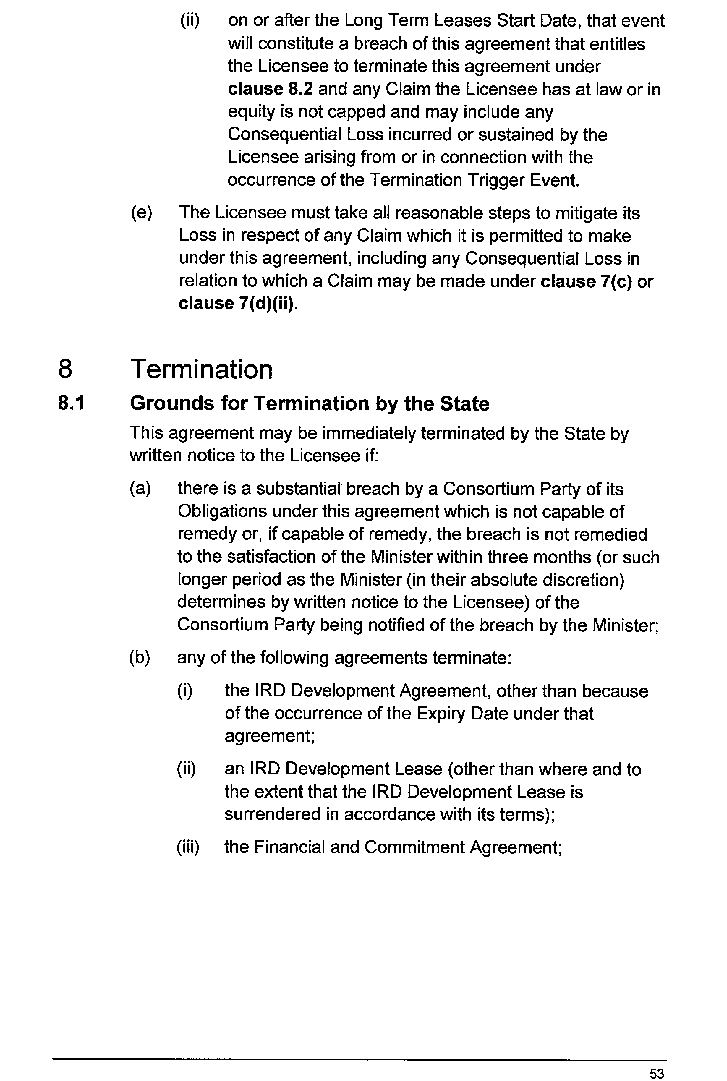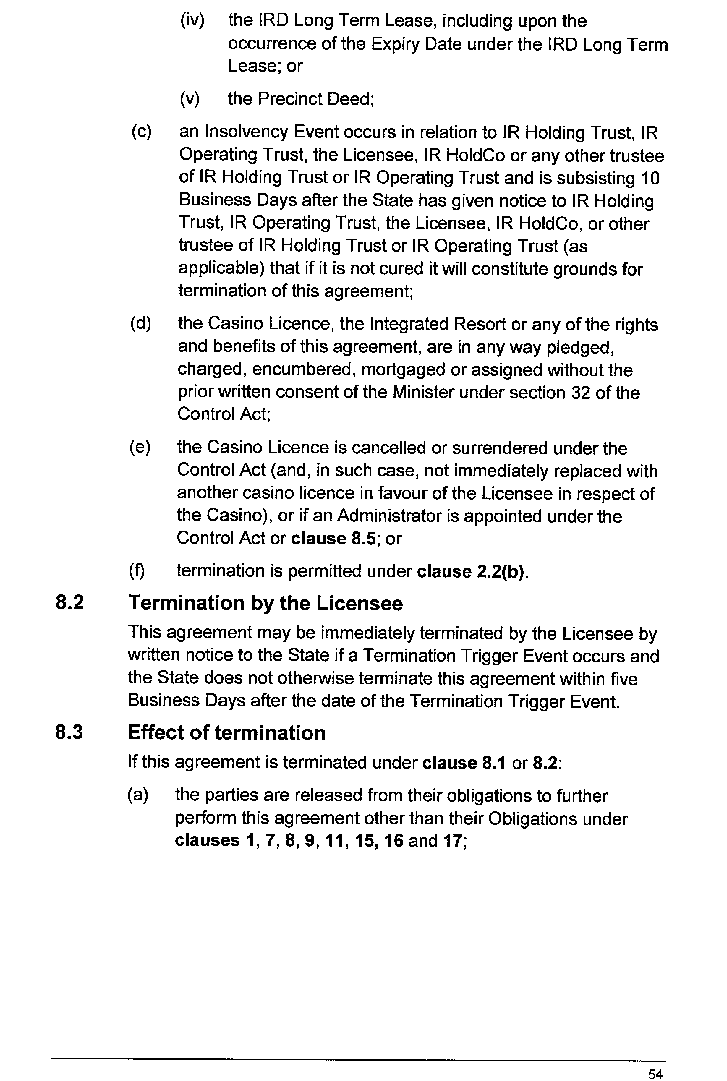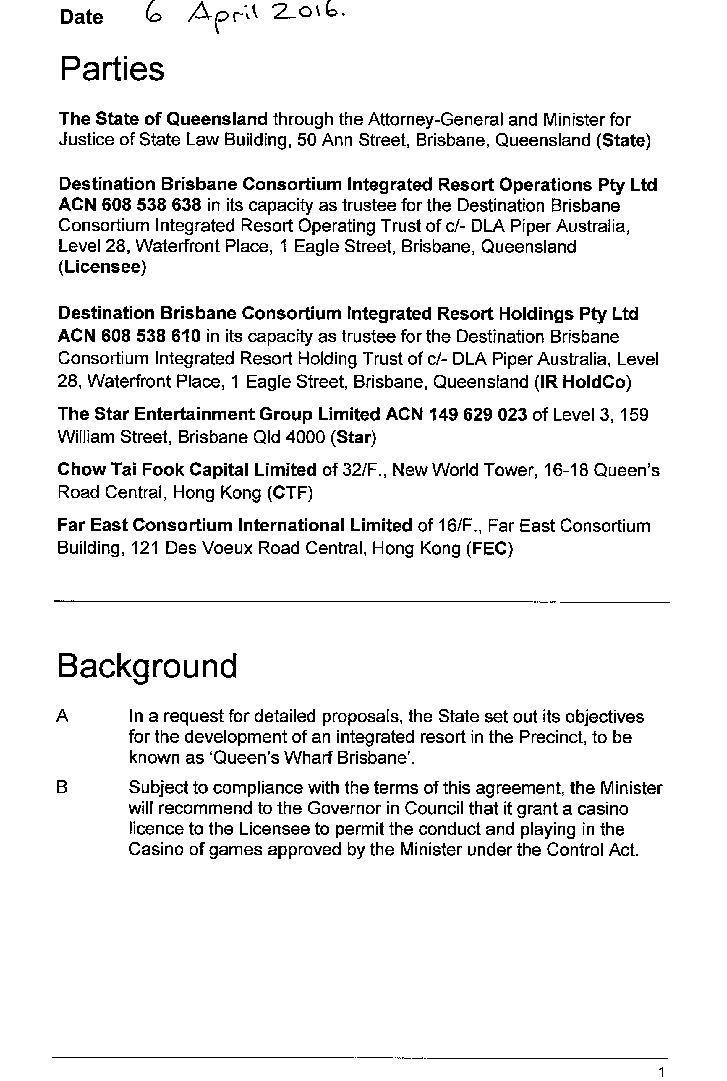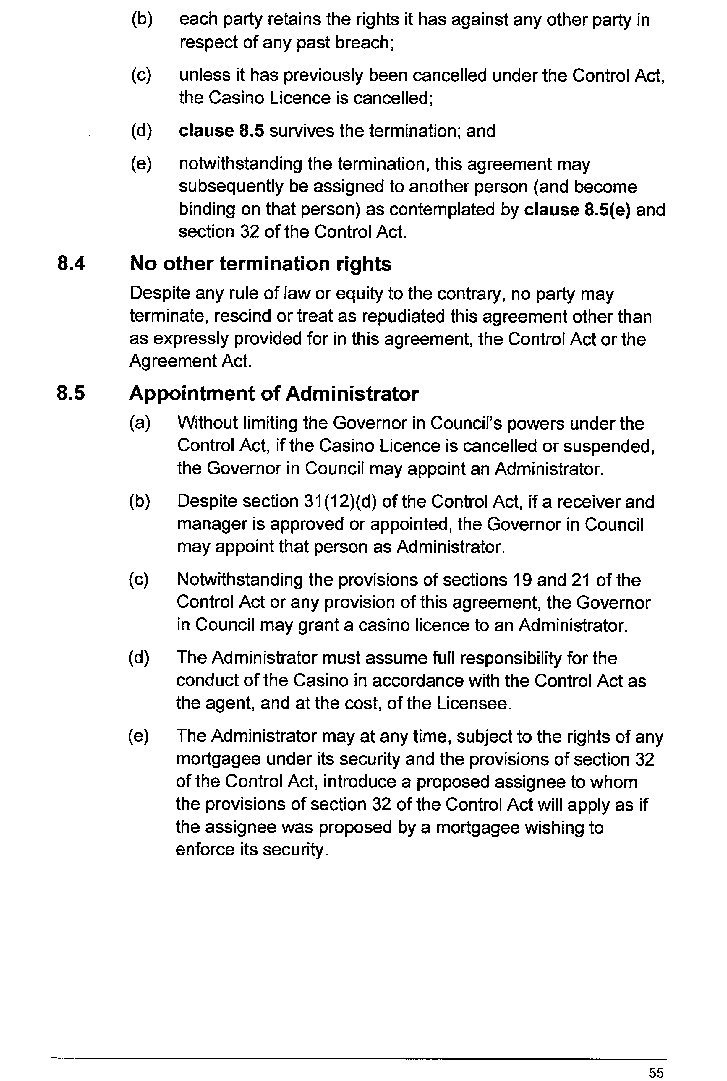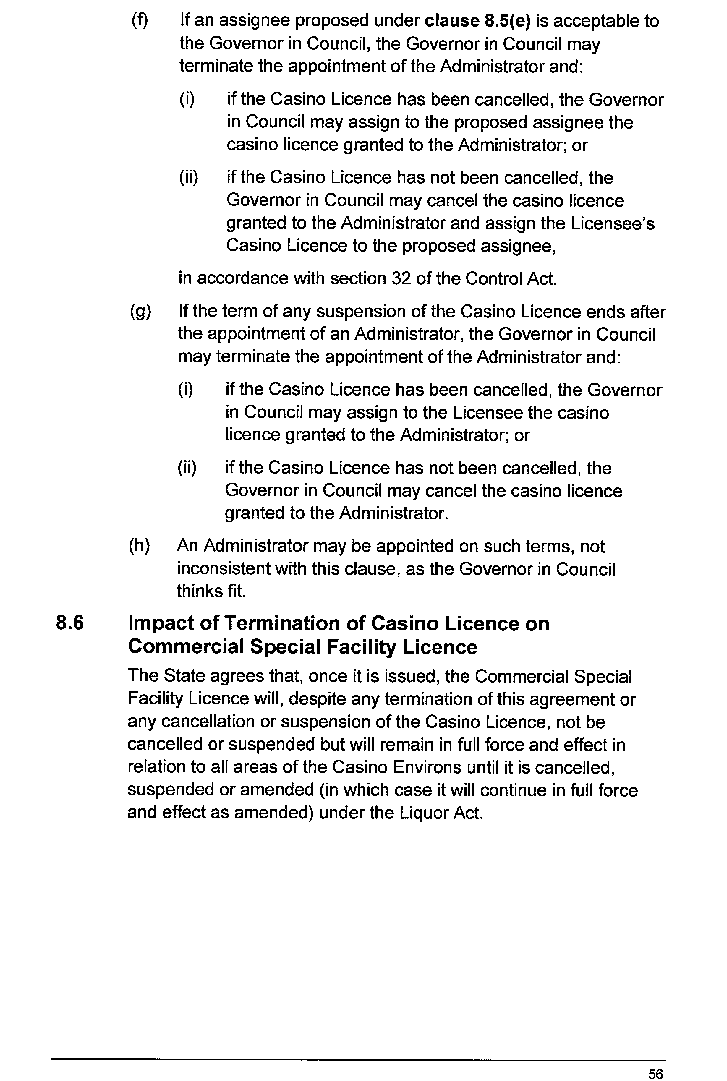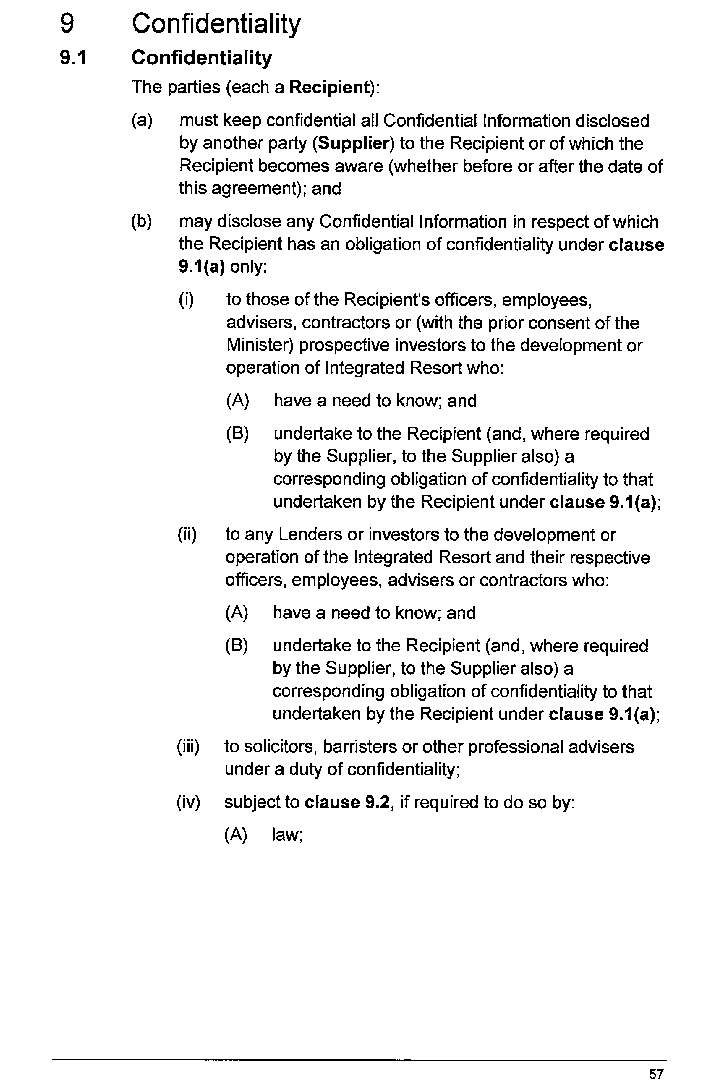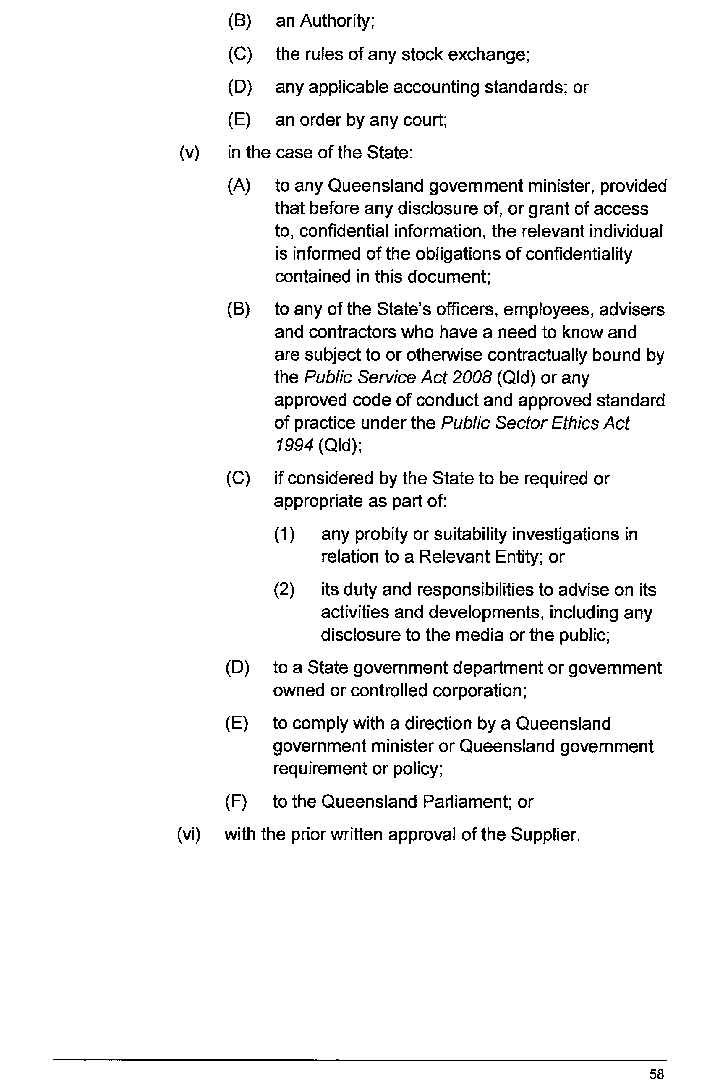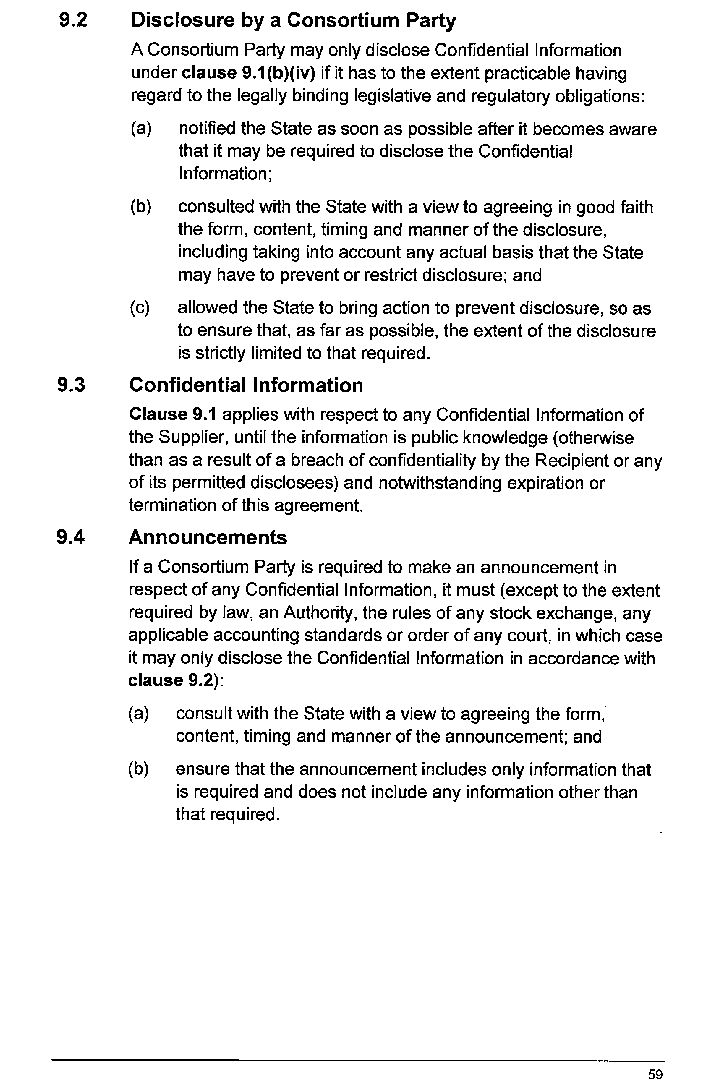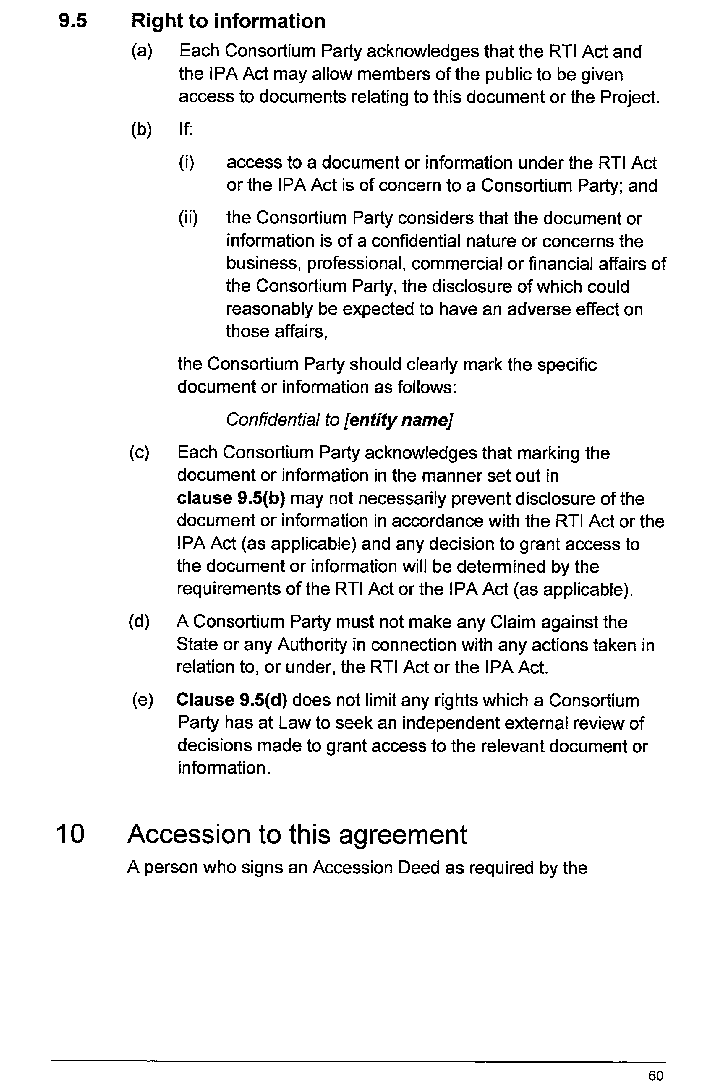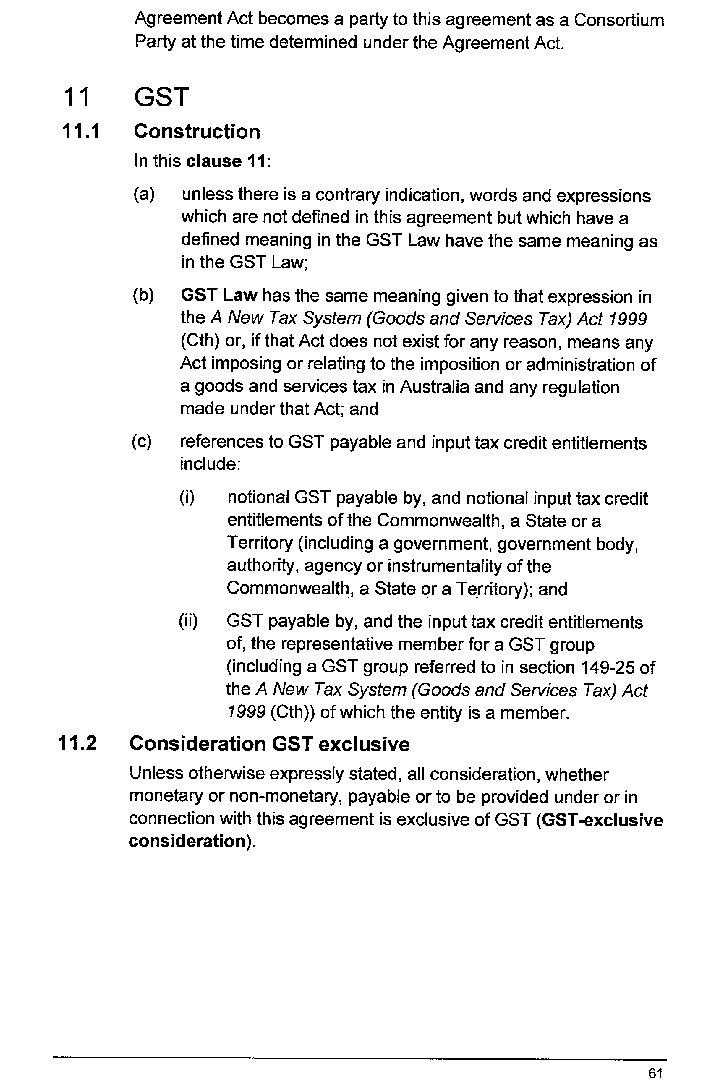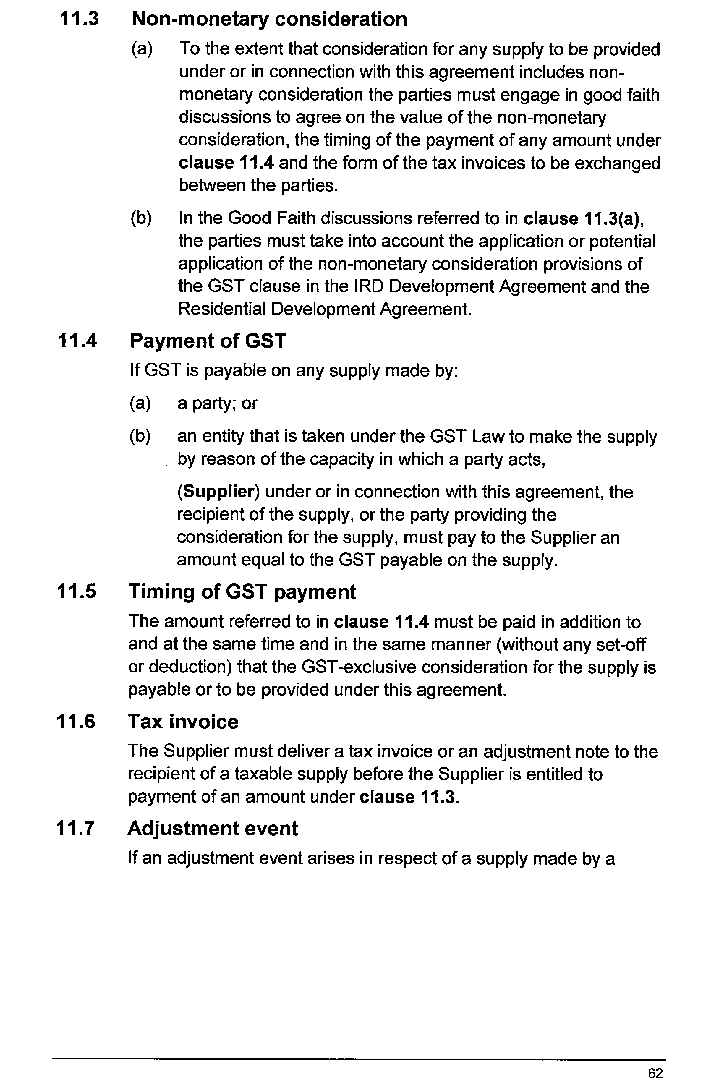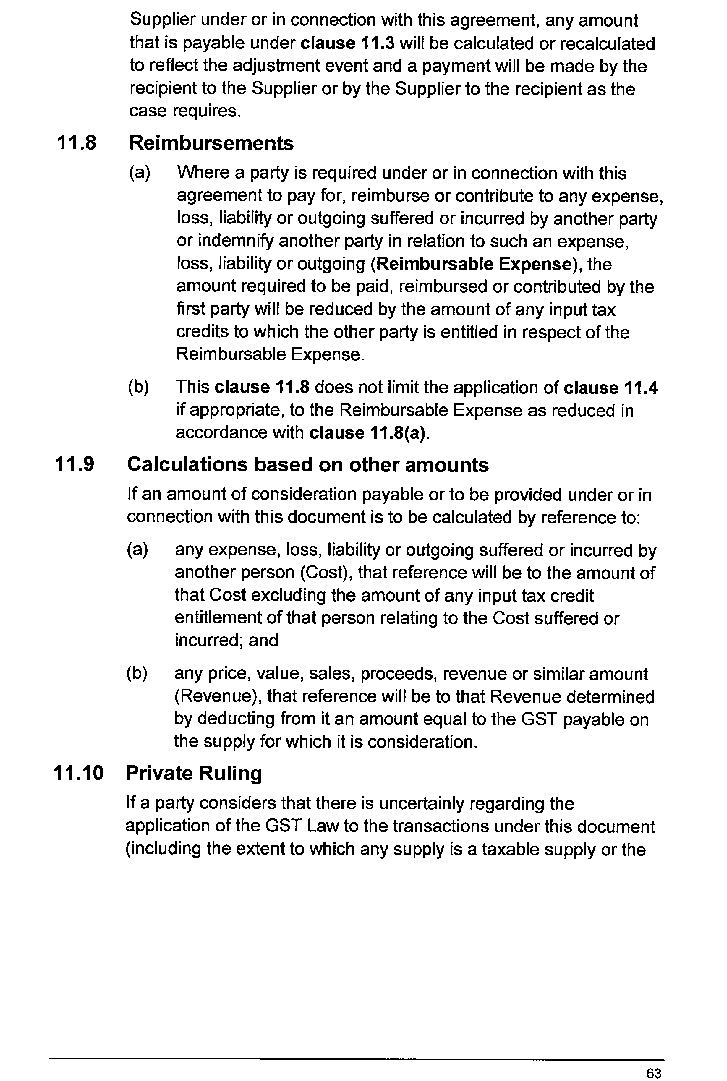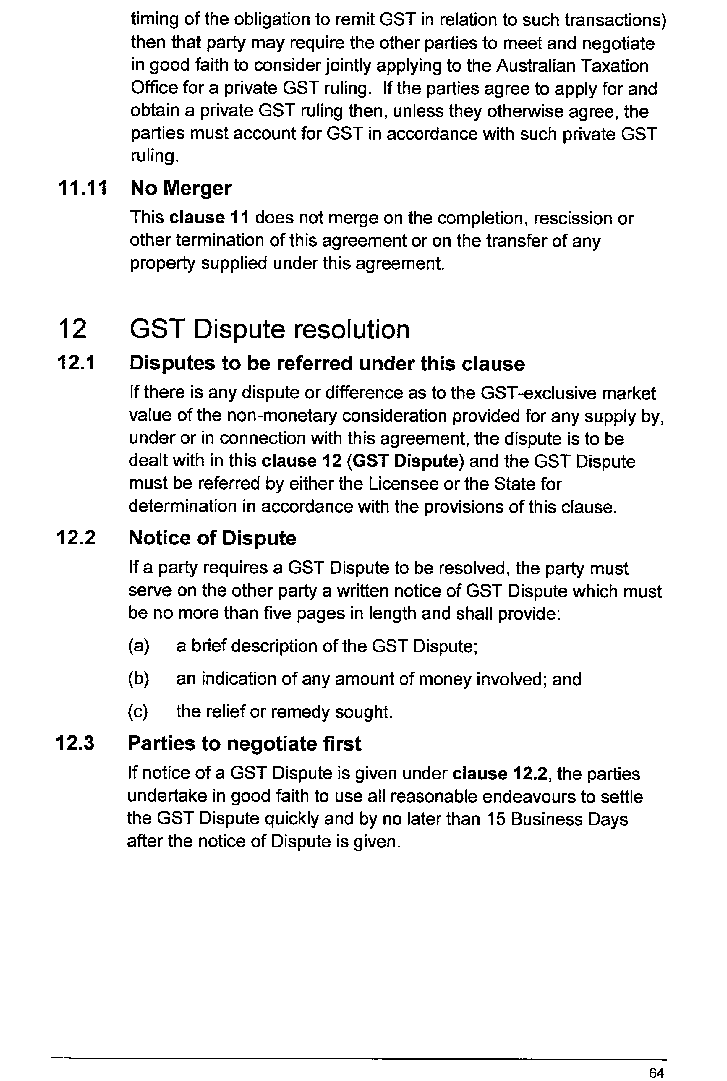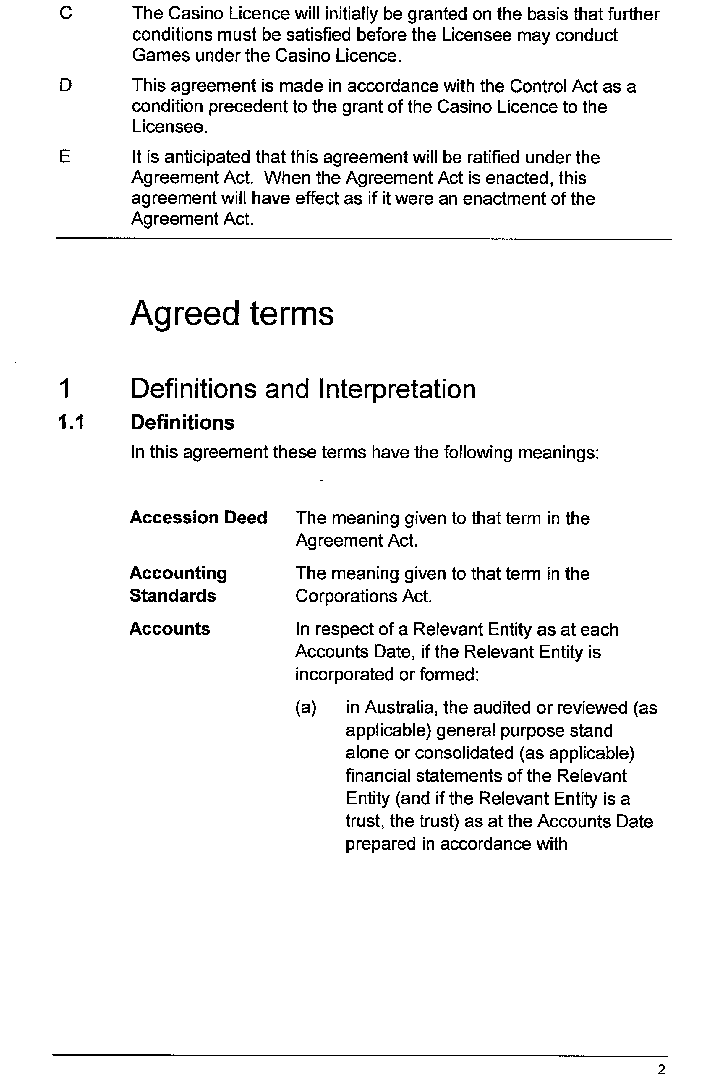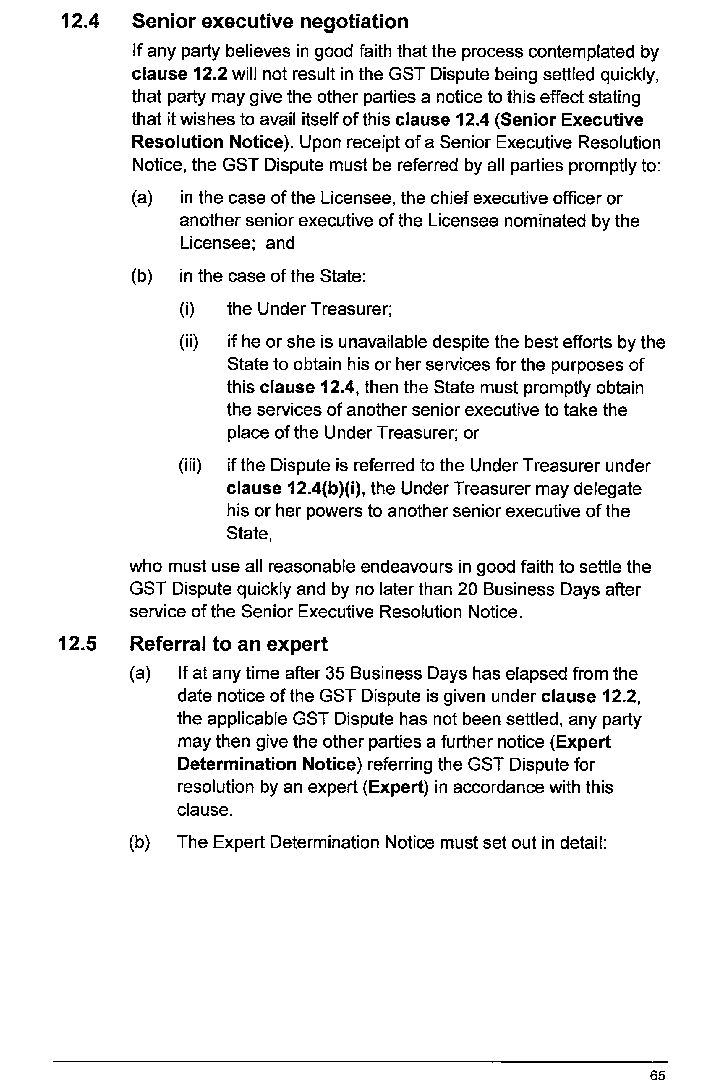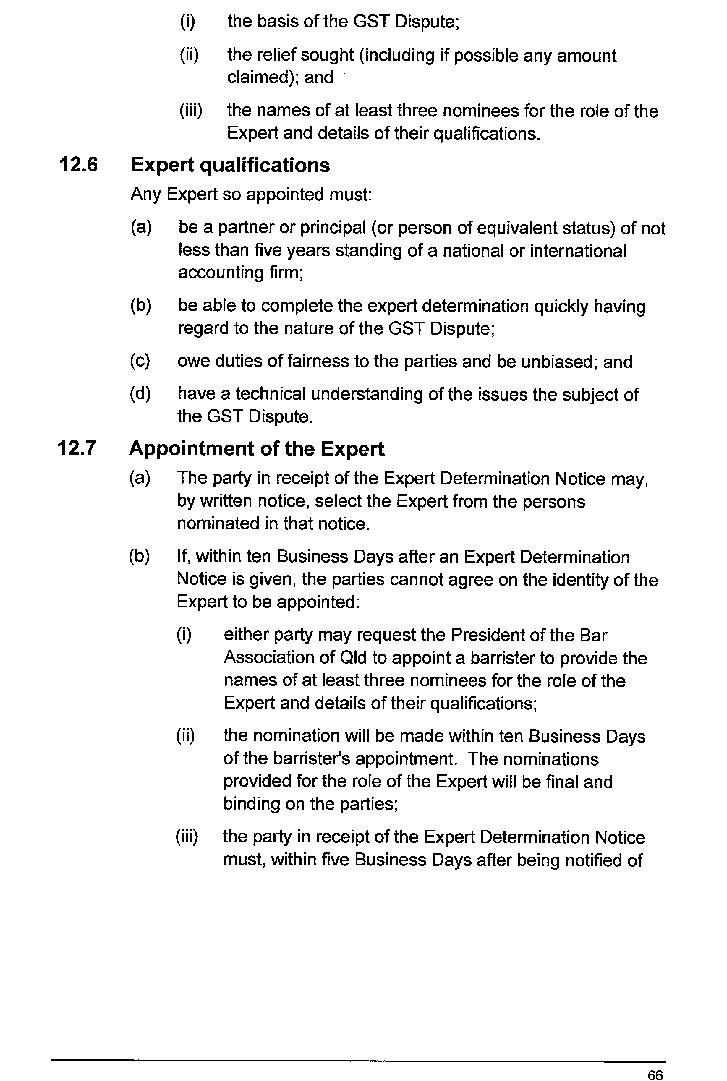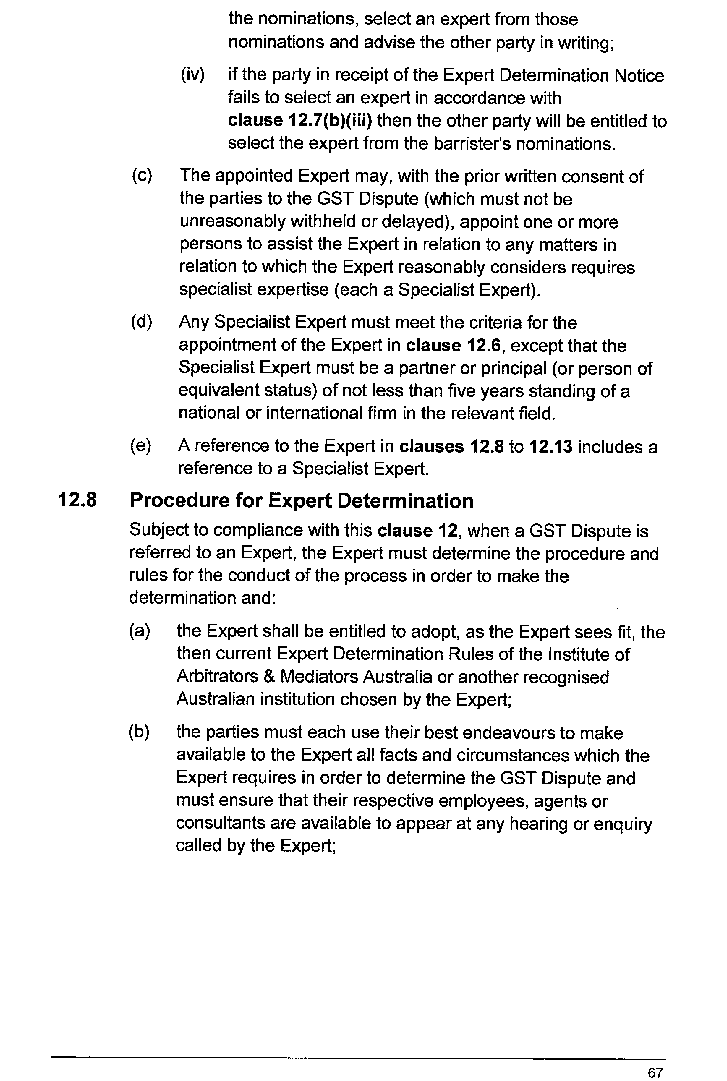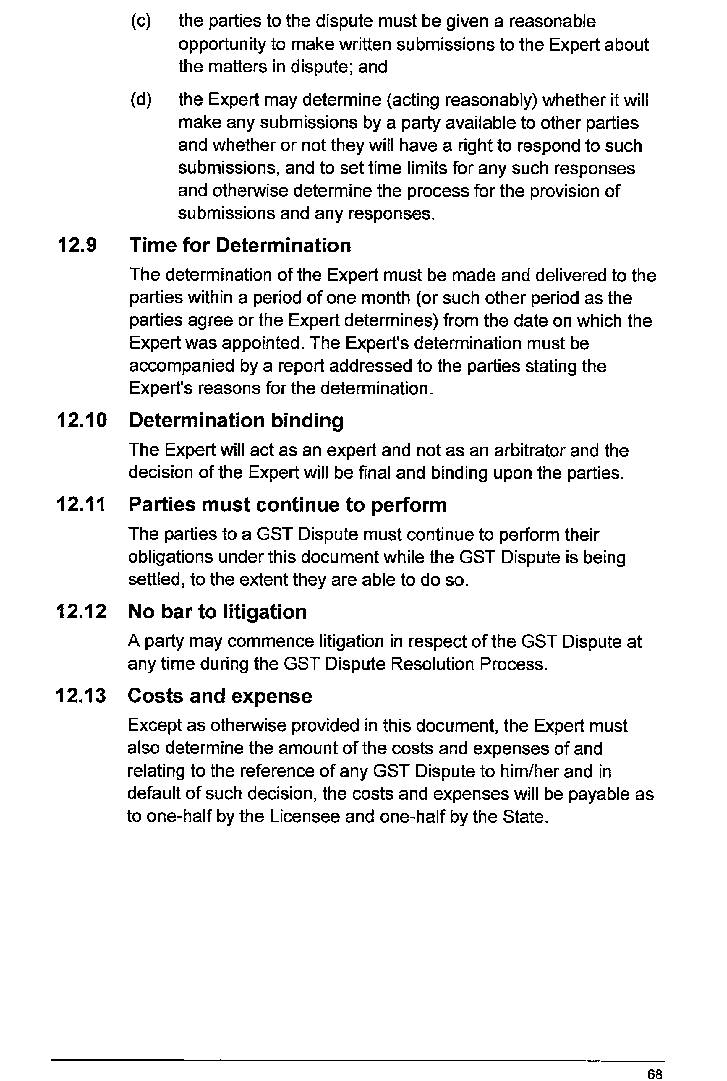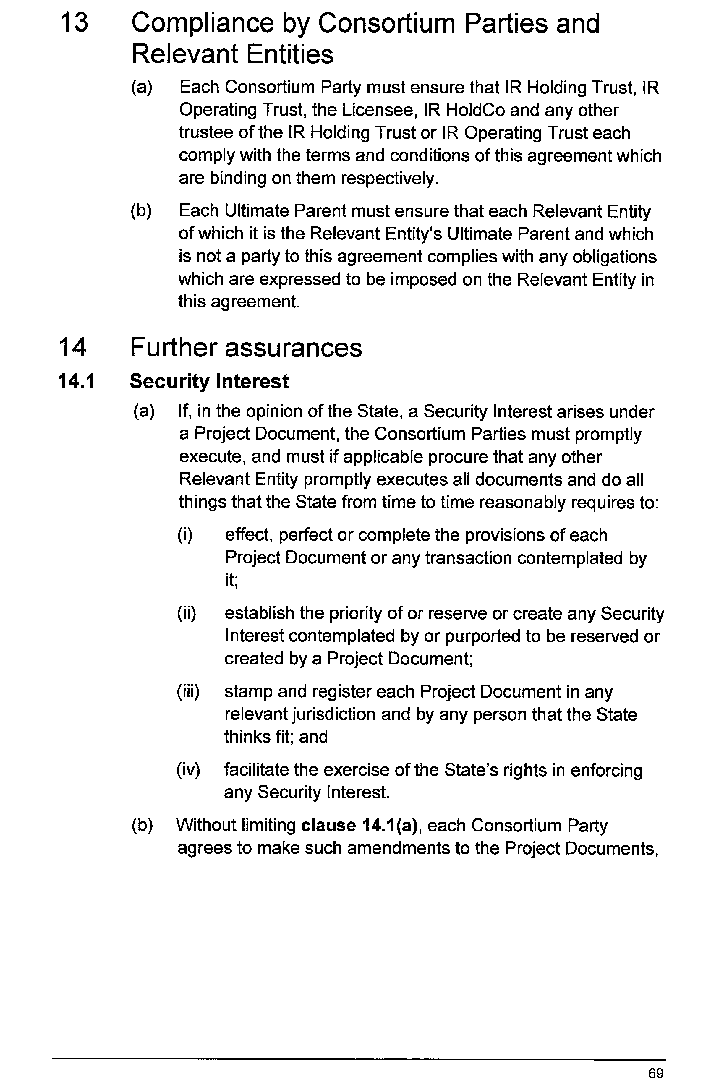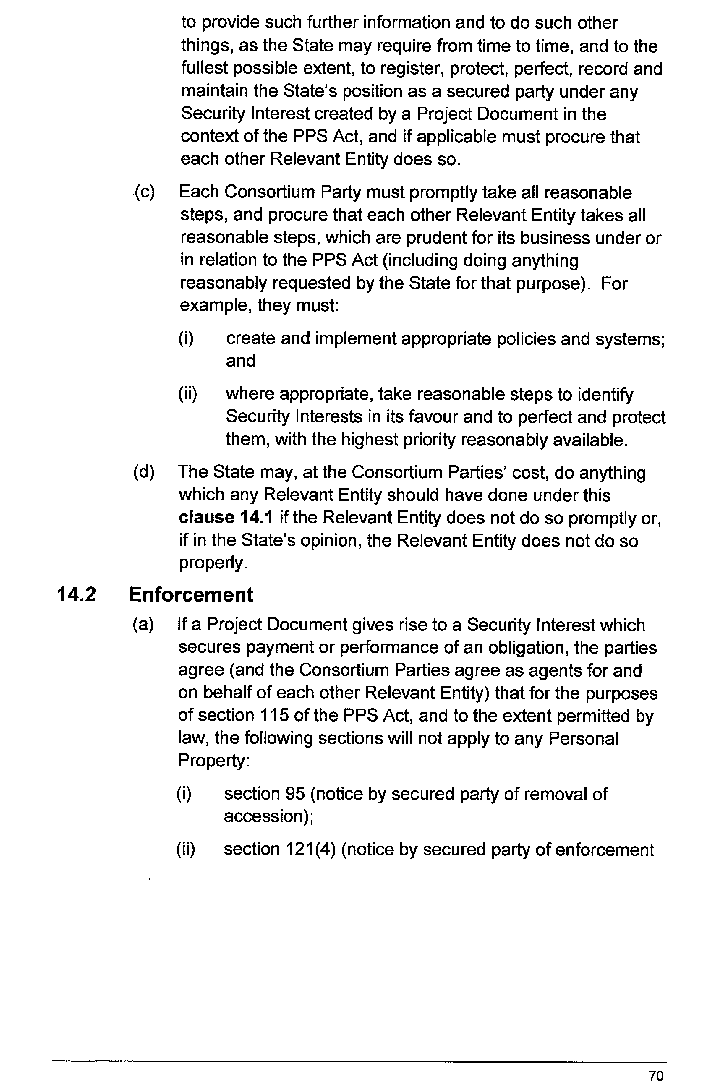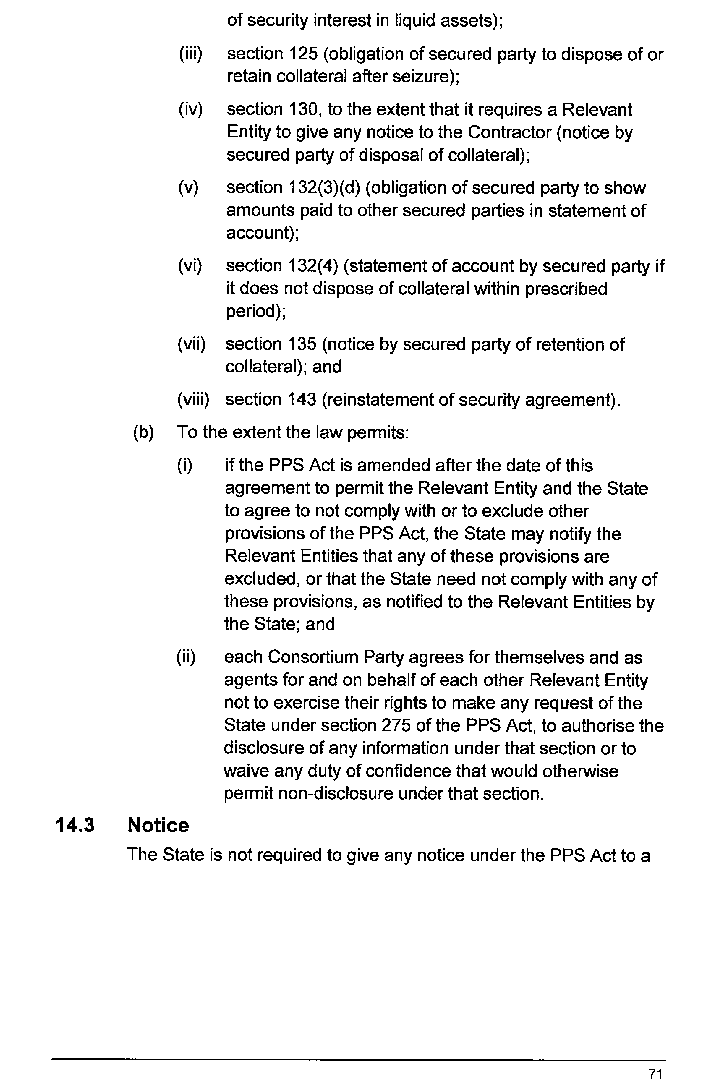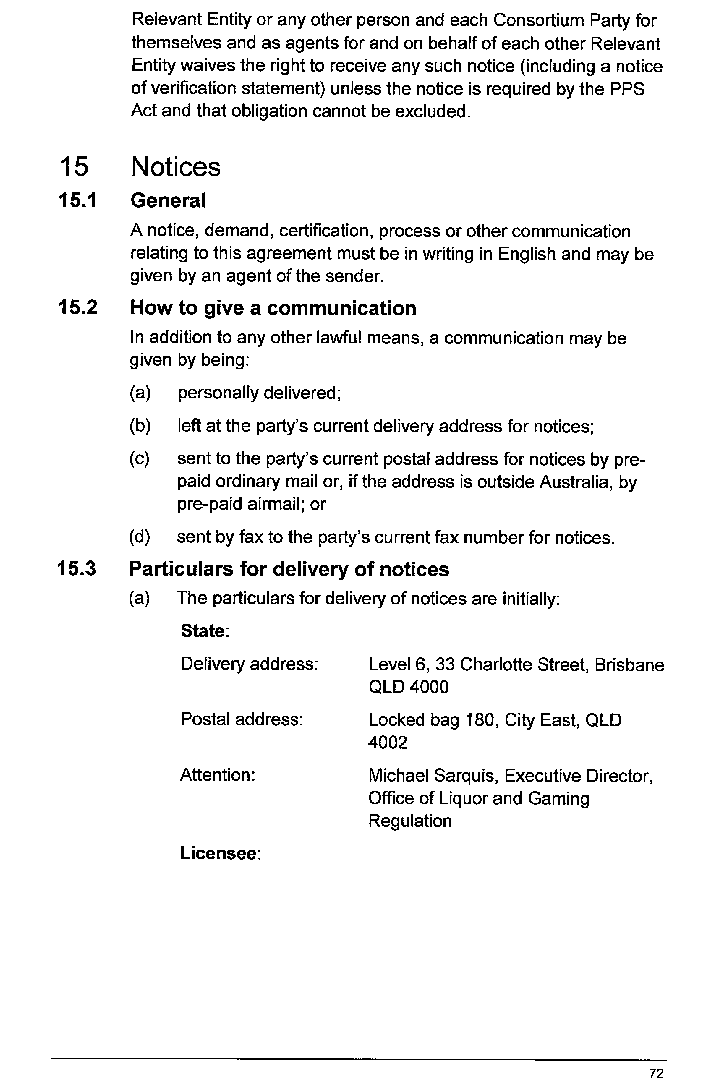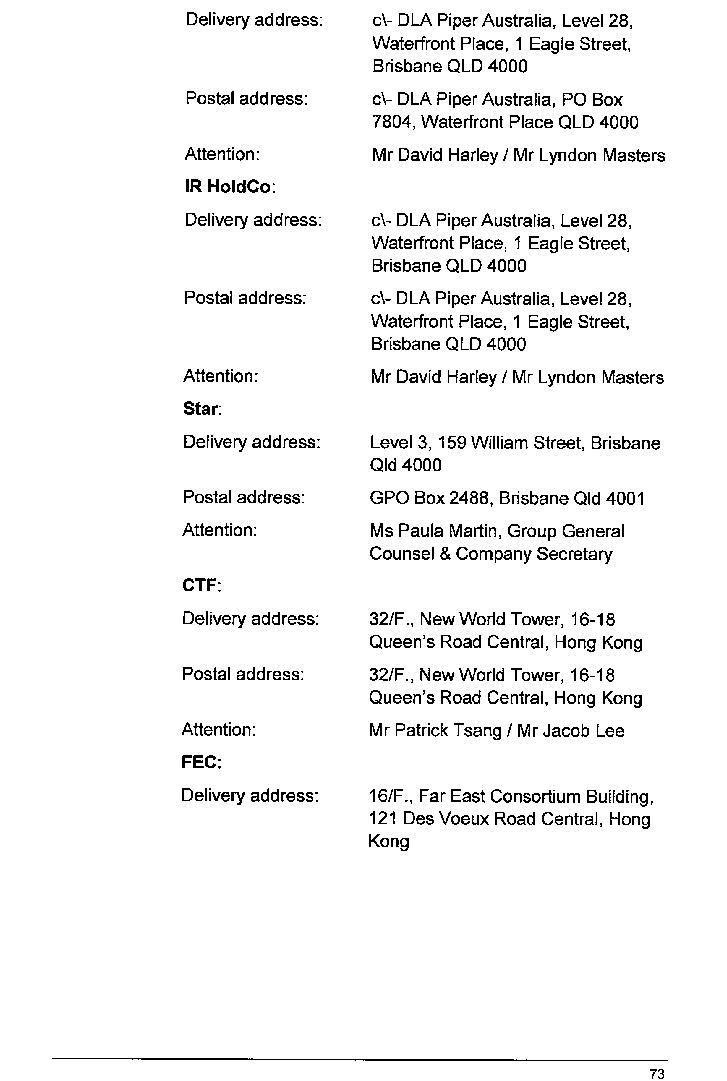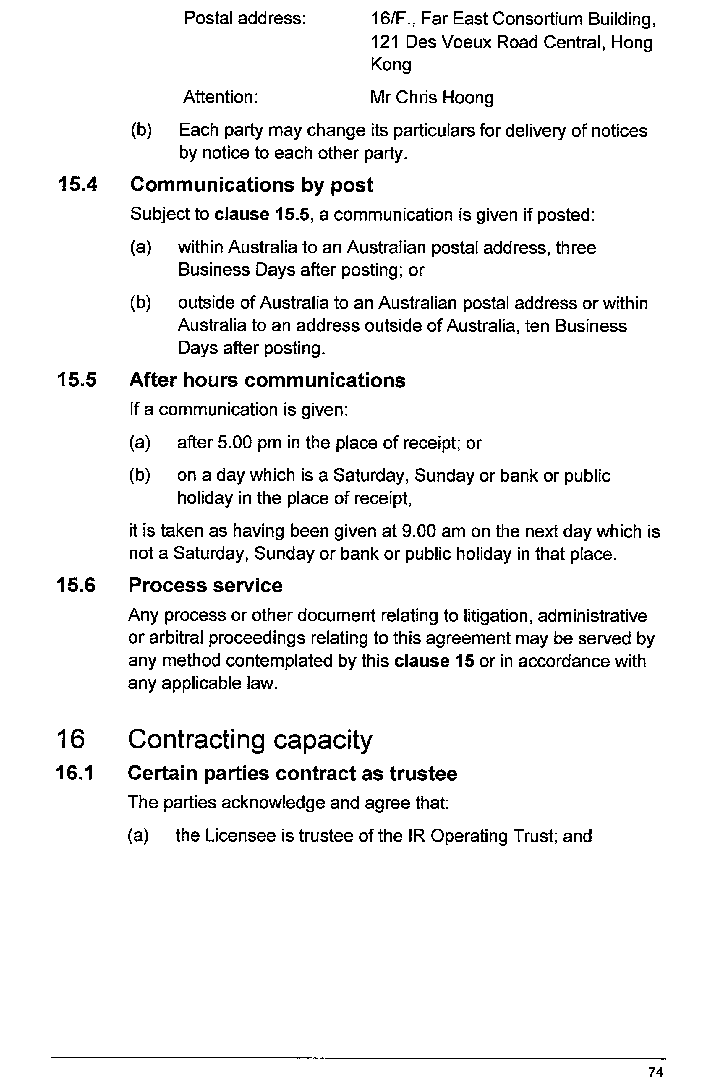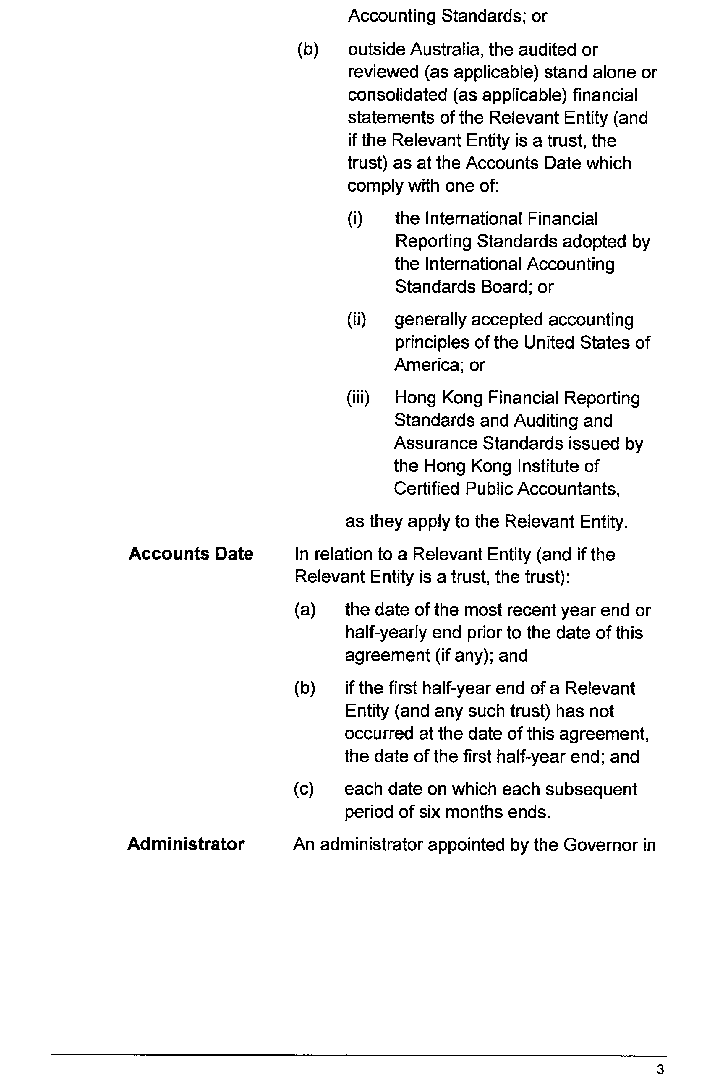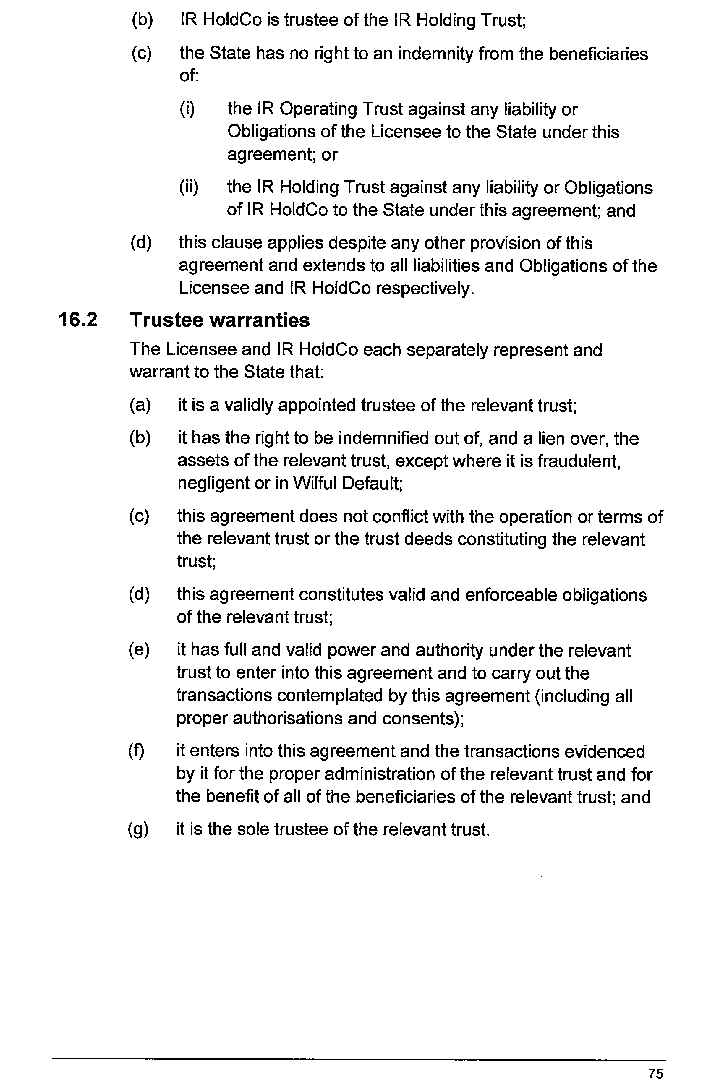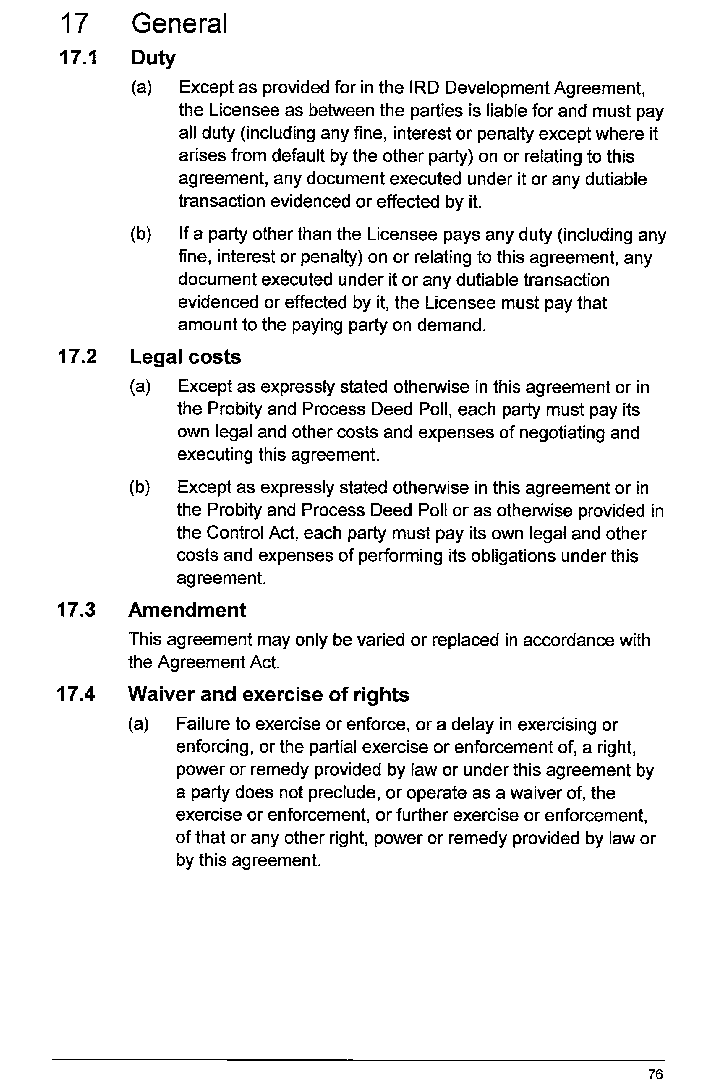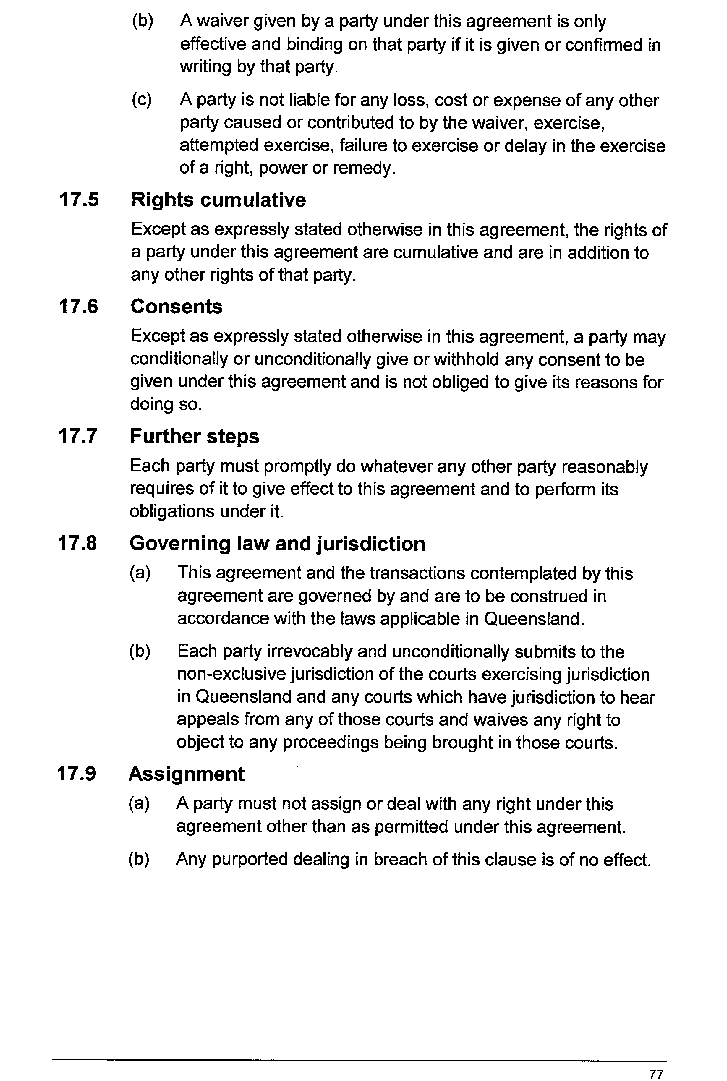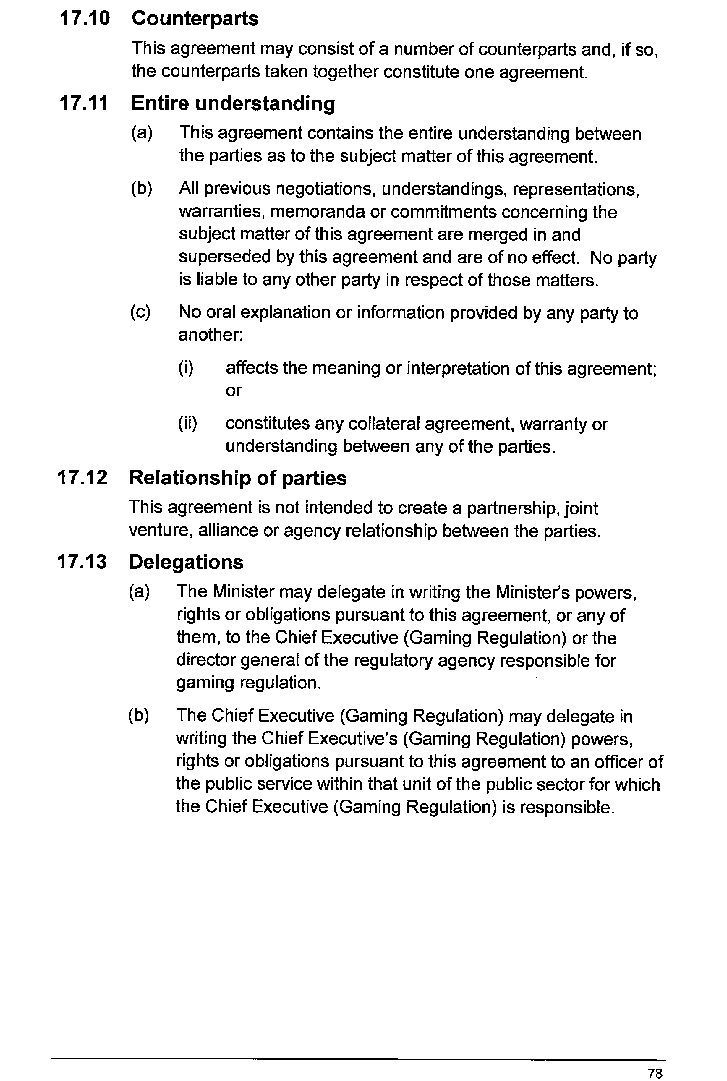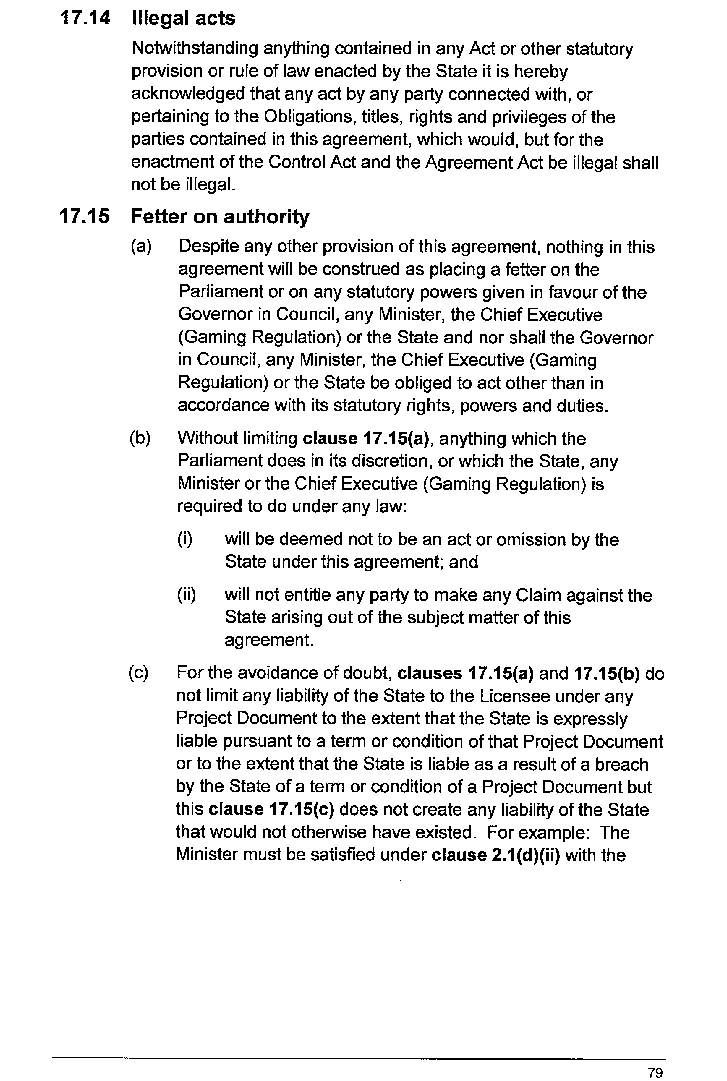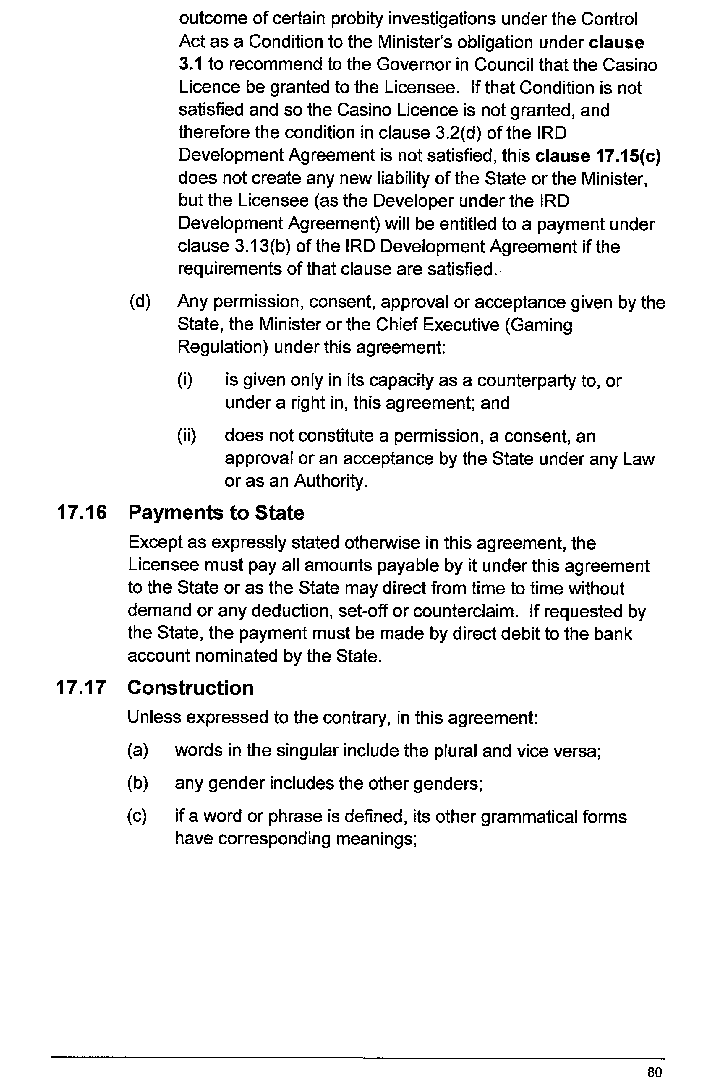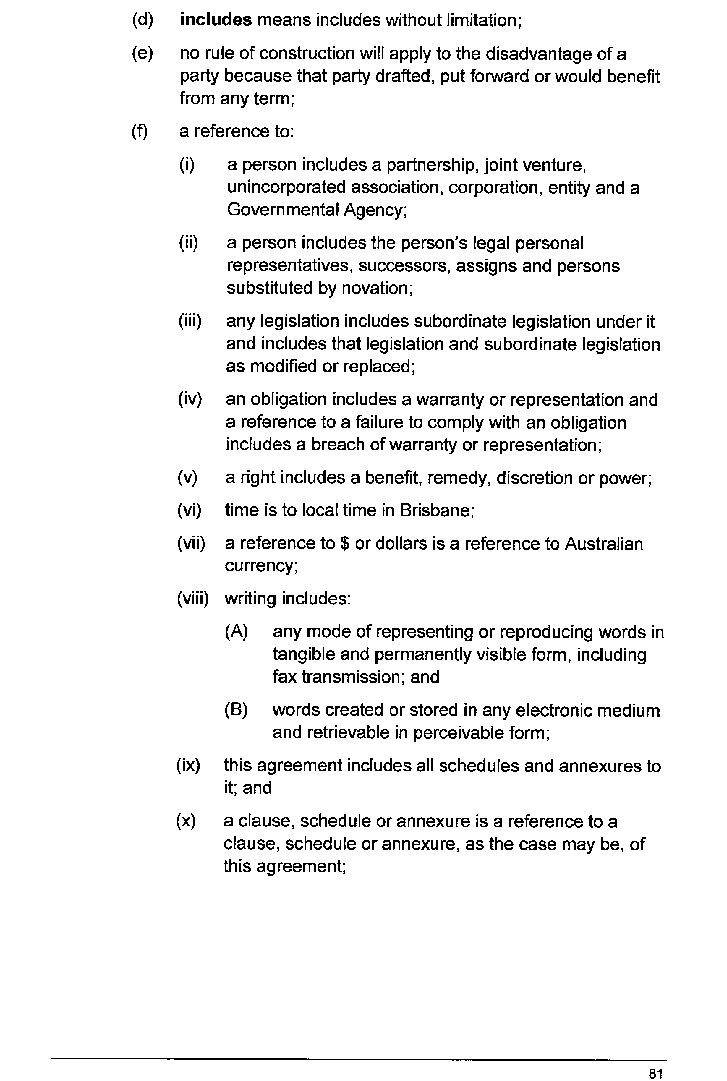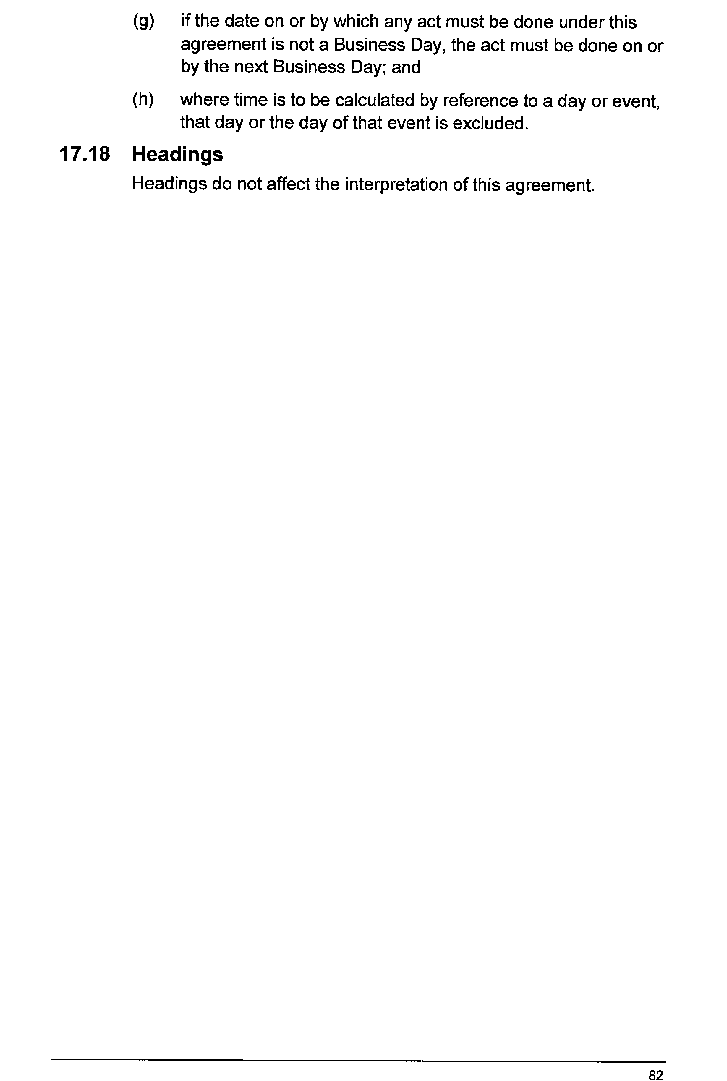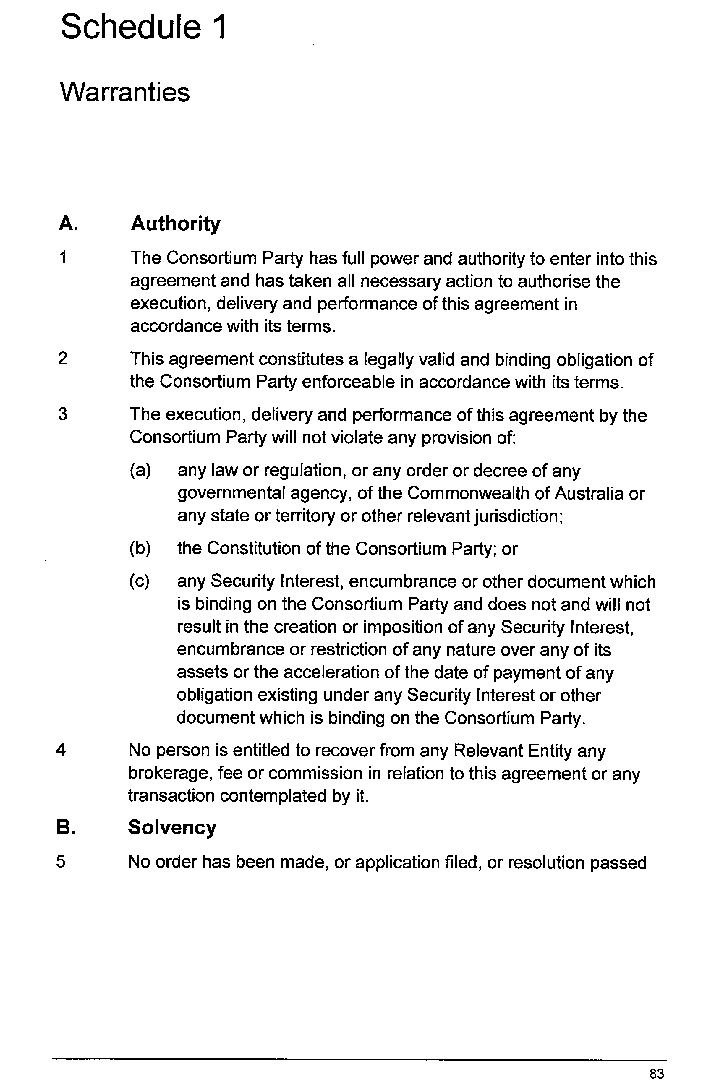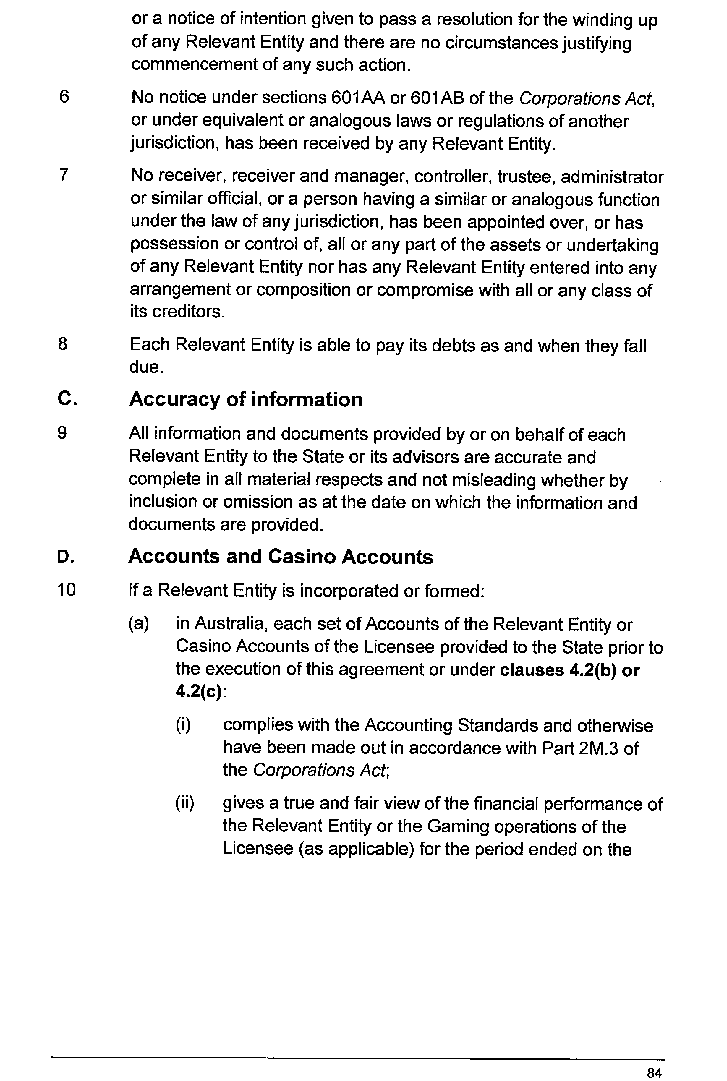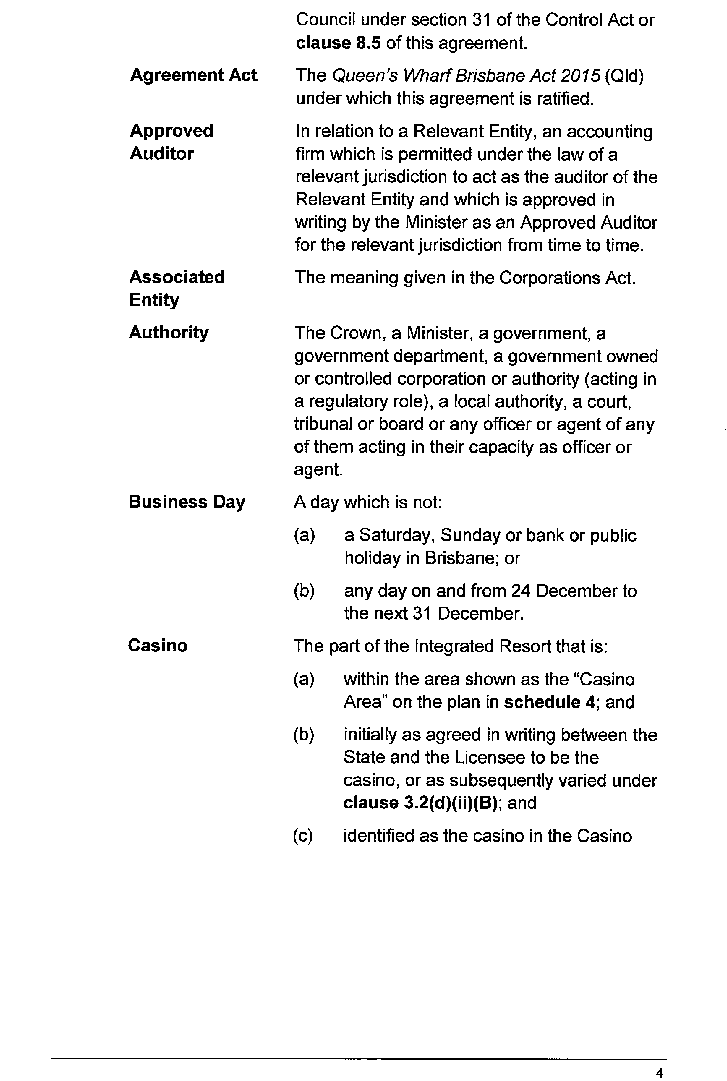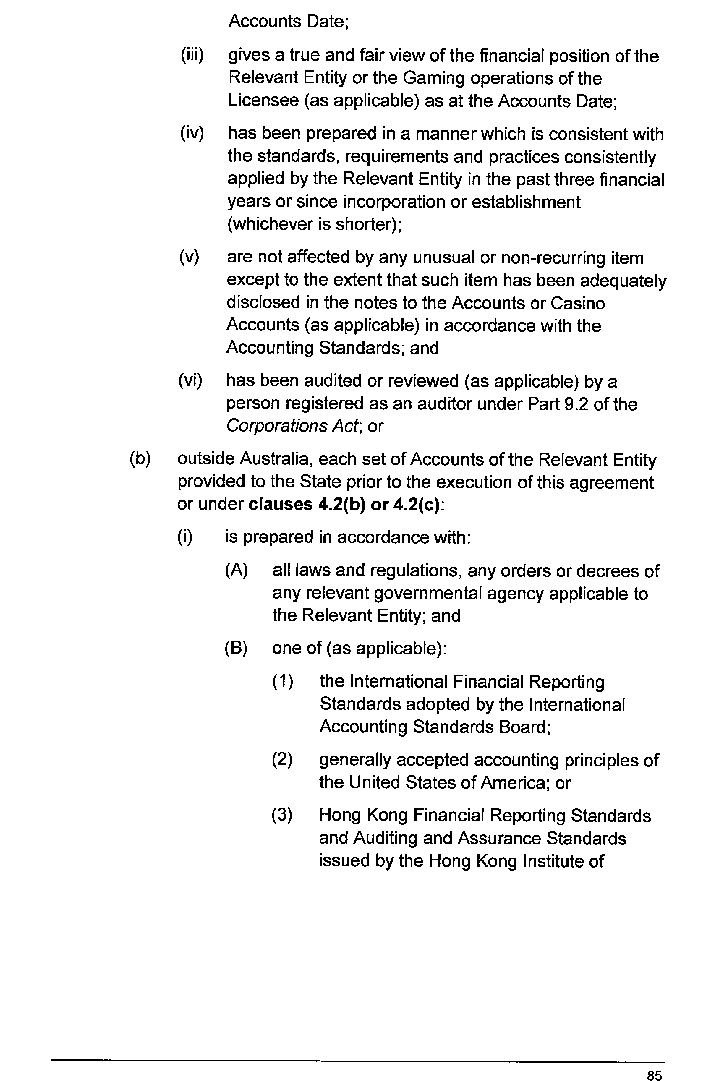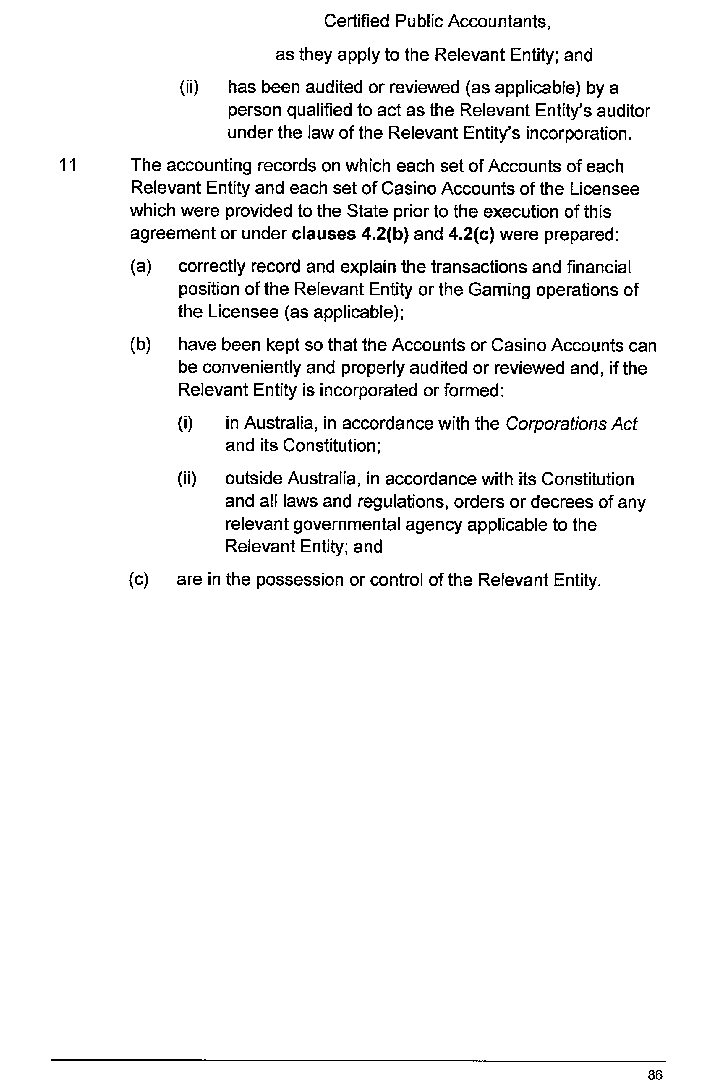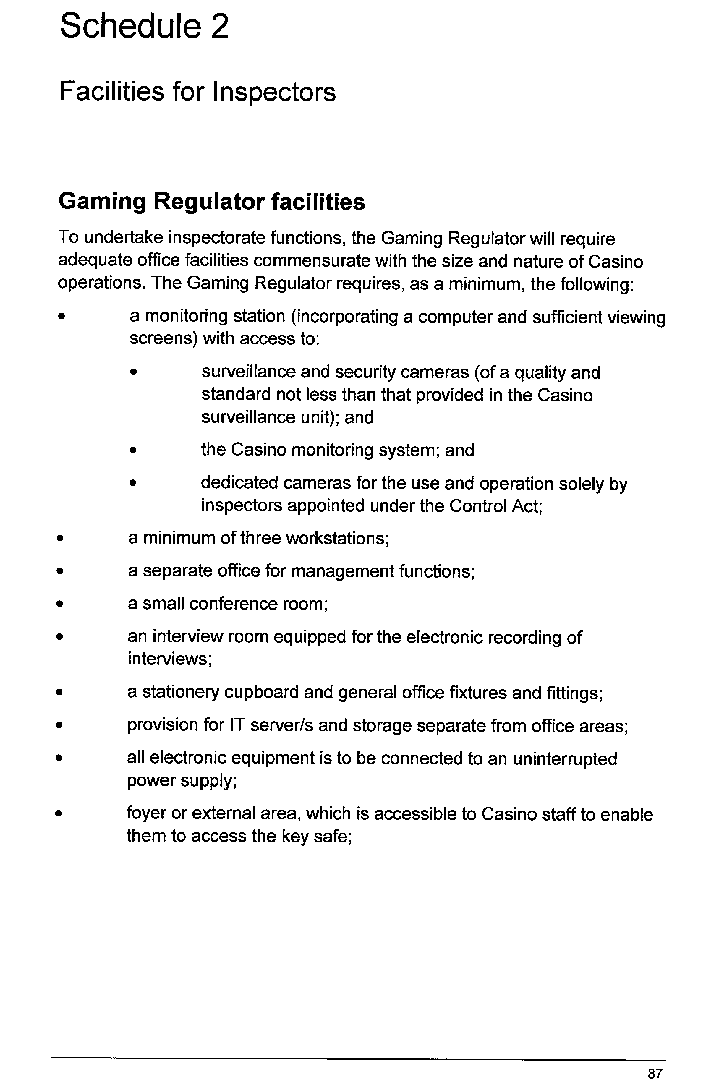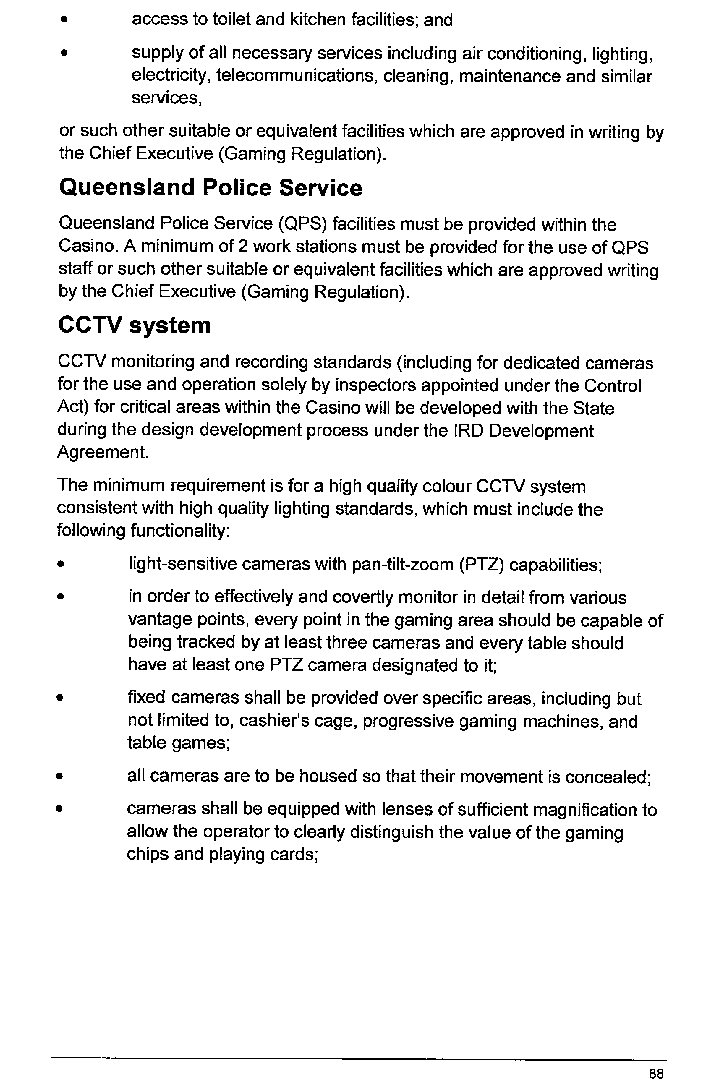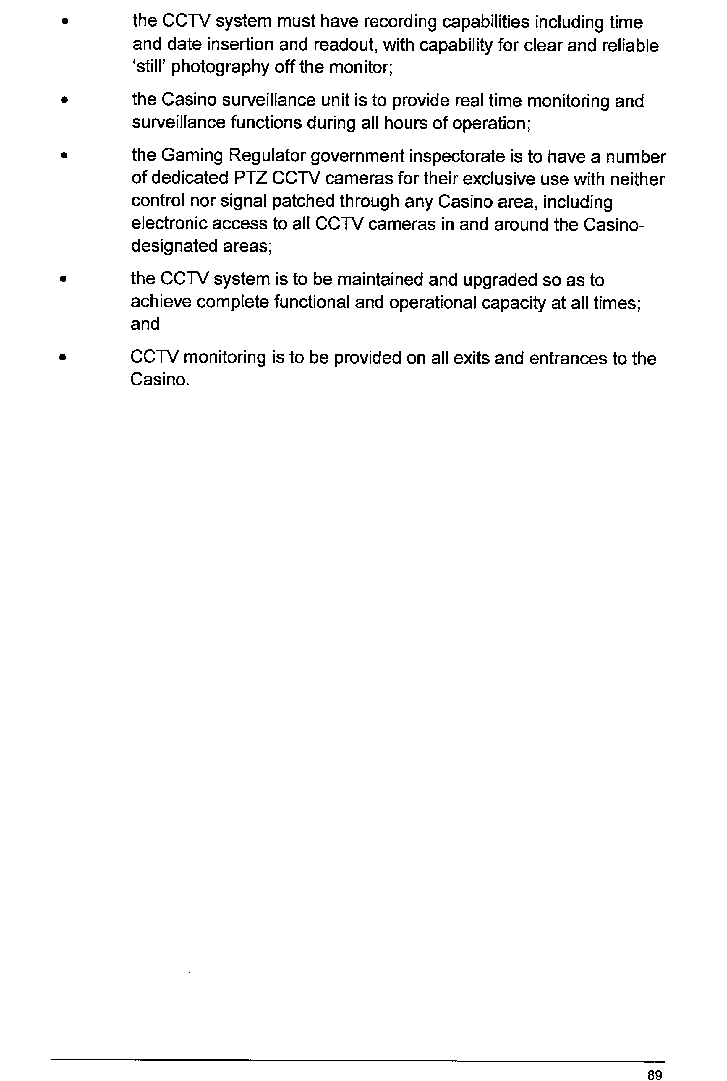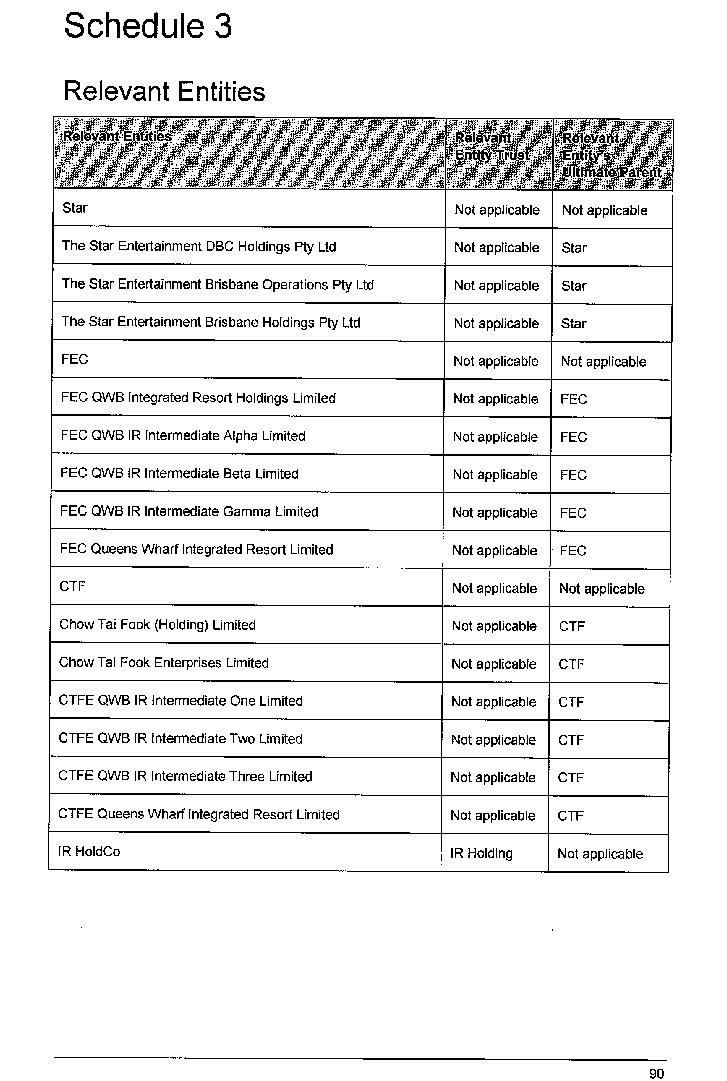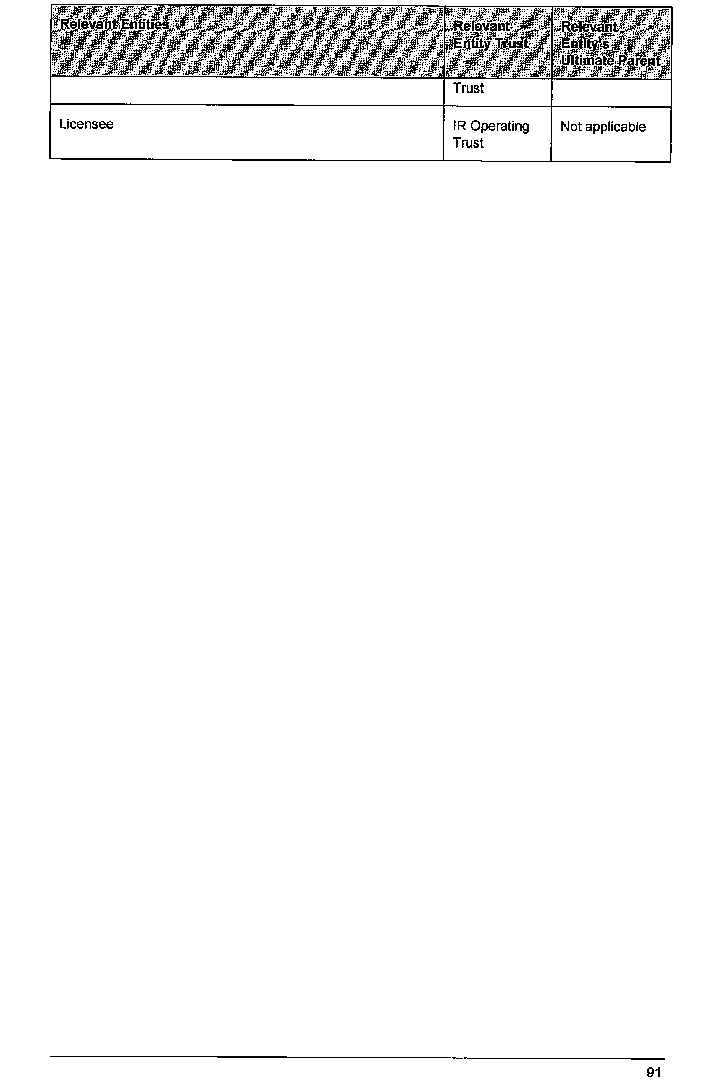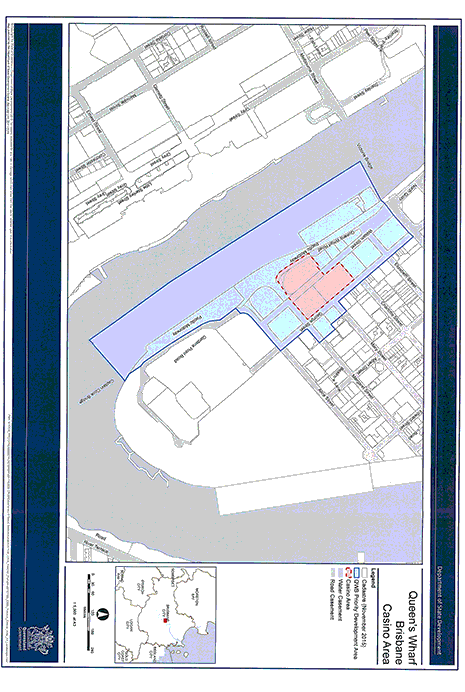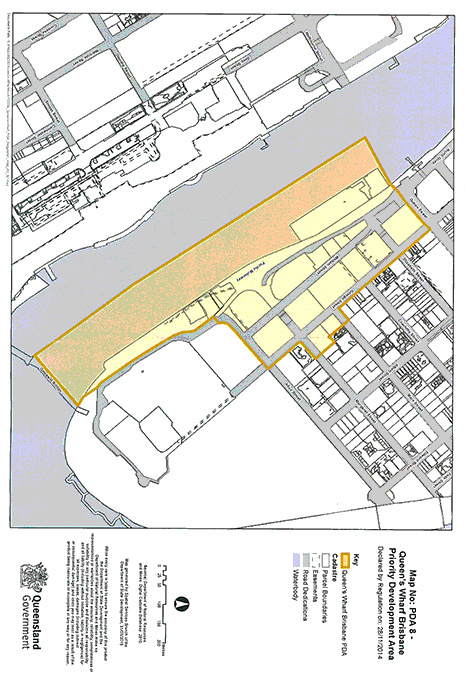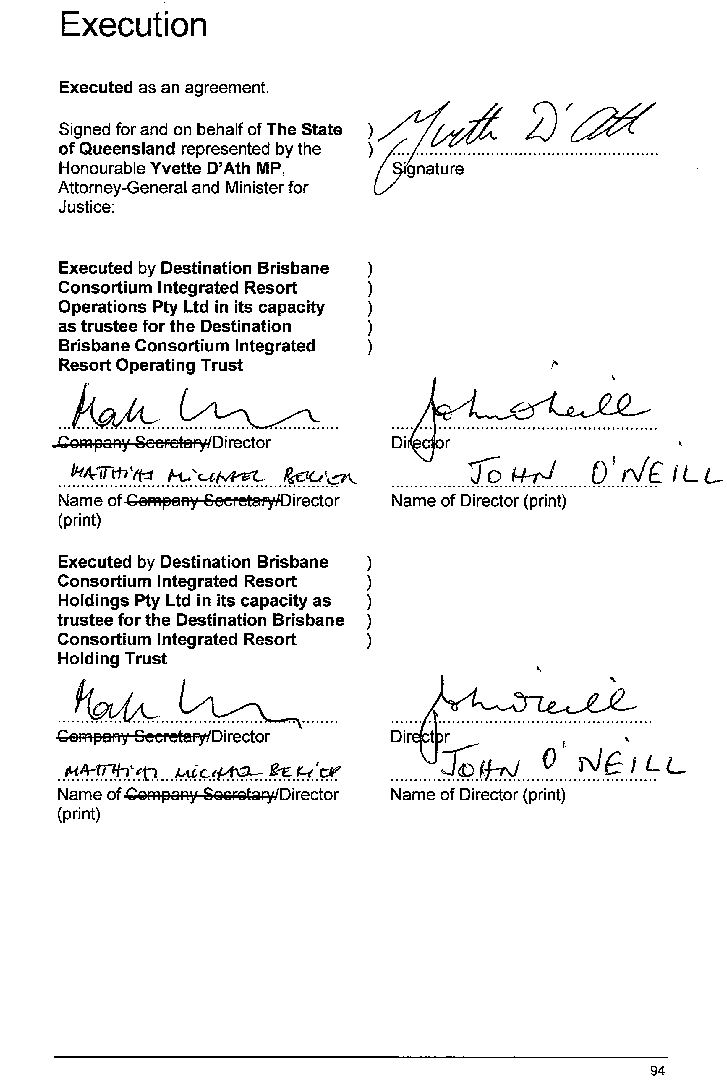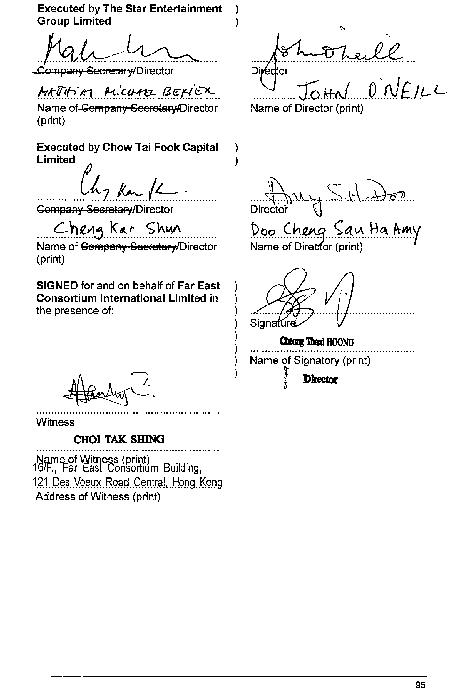This Act may be cited as the Queen’s Wharf Brisbane Act 2016 .
This Act commences on a day to be fixed by proclamation.
The main purposes of this Act are the following—(a)to provide for the ratification of an agreement for a casino to be located within the Queen’s Wharf priority development area;(b)to enact the agreement as a law;(c)to provide for the way in which an entity may become, or stop being, a party to the agreement;(d)to state the requirements for holding interests in relation to an entity that is a party to, or referred to in, the agreement;(e)to provide for the interaction between this Act and other laws.
4Relationship with other Acts generally
(1)If a provision of this Act is inconsistent with another Act, the provision prevails over the other Act to the extent of the inconsistency.(2)Subsection (1) does not affect a provision of this Act or another Act that expressly deals with the interaction between this Act and the other Act.
(1)This Act binds all persons, including the State.(2)Nothing in this Act makes the State liable to be prosecuted for an offence.
The dictionary in schedule 2 defines particular words used in this Act.
7References to this Act and provisions
Unless the context otherwise requires, a reference to this Act, or a provision of this Act, includes a reference to the casino agreement, or a provision of the agreement.Under section 10, the casino agreement has effect as if it were a law of the State.
8Different drafting practice not to affect meaning
(1)This section applies if—(a)a provision of the casino agreement expresses an idea in particular words; and(b)another provision of this Act appears to express the same idea in different words for the purpose of giving effect to the agreement.(2)The ideas are taken not to be different merely because different words are used.
The casino agreement is the agreement ratified under section 10, as amended from time to time under section 11.
The agreement set out in schedule 1, made by the Minister on behalf of the State—(a)is ratified by the Legislative Assembly for the purposes of the Control Act, section 19; and(b)has effect as if it were a law of the State.
(1)The agreement ratified under section 10 (the original agreement) may be amended by a further agreement between the parties to the agreement.(2)If the further agreement is ratified by the Legislative Assembly, the further agreement—(a)takes effect to amend the original agreement; and(b)has effect as if it were a law of the State.
12Publication of consolidated agreement
The chief executive must, from time to time, publish a document on the department’s website consolidating the agreement ratified under section 10 and any further agreements made and ratified under section 11.
(1)An entity (the second entity) is the holding entity of another entity (the first entity ) if the first entity is a subsidiary of the second entity.(2)For deciding whether the first entity is a subsidiary of the second entity, if the first entity is a trustee of a trust and the second entity holds interests in the trust, the definition subsidiary applies with any necessary changes as if—(a)the trust were a body corporate; and(b)interests in the trust were shares in the body corporate; and(c)a meeting of members of the trust were a general meeting of the body corporate; and(d)the appointment of a trustee for the trust were the election of the directors of the body corporate; and(e)if the second entity holds the interests in the first entity as a trustee of a trust—that trust were a body corporate.
14Becoming a party to casino agreement
(1)This section applies to a person if—(a)the person proposes to become a holding entity of a relevant entity; or(b)the person proposes to become a trustee of a trust to which each of the following applies—(i)a consortium party is a trustee of the trust;(ii)the trust is a relevant entity;(iii)the trust holds interests in another relevant entity; or(c)the Governor in Council decides, on the Minister’s recommendation, to require the person to become a party to the casino agreement, including, for example, as a condition of granting an approval under chapter 4, part 2, division 1; or(d)the person and the Minister agree in writing that the person will become a party to the casino agreement.(2)Despite subsection (1), the Minister may decide this section does not apply to a person mentioned in subsection (1)(a) or (b).(3)The person must, on or before the compliance day, sign a deed in the approved form (an accession deed) under which the person becomes, subject to the terms and conditions stated in the deed, each of the following—(a)a party to the casino agreement;(b)a consortium party;(c)a relevant entity;(d)if applicable, an ultimate parent under the casino agreement.Maximum penalty—40 penalty units.
A direction may also be given under chapter 4, part 3 enforcing compliance with this requirement.(4)For subsection (3), the compliance day is—(a)for a person mentioned in subsection (1)(a) or (b)—(i)the day that is 2 weeks before the day on which the person becomes a holding entity or trustee mentioned in the subsection; or(ii)if the Minister gives the person a written notice stating a later day for the purposes of this subsection—the later day; or(b)for a person mentioned in subsection (1)(c)—the day stated in the Governor in Council’s decision for the purposes of this subsection; or(c)for a person mentioned in subsection (1)(d)—the day agreed by the person and the Minister for the purposes of this subsection.(5)For subsection (4)(b), the day stated in the Governor in Council’s decision must be at least a reasonable period after notice of the decision is given to the person.(6)The accession deed takes effect when—(a)the signed accession deed has been published in the gazette; and(b)it has become unconditional.(7)This section does not limit the operation of chapter 4, part 2.
15Ceasing to be a party to casino agreement
(1)This section applies if—(a)a consortium party (the ceasing party) stops being, or proposes to stop being—(i)a holding entity of a relevant entity; or(ii)a trustee of a trust that is a relevant entity; and(b)the Minister and each other consortium party consents in writing to the ceasing party no longer being a party to the casino agreement.(2)Also, this section applies in relation to a consortium party (also the ceasing party) in any other circumstances decided by the Minister, if each other consortium party consents in writing to the ceasing party no longer being a party to the casino agreement.(3)The ceasing party may sign a deed in the approved form (a deed of cessation) under which the ceasing party stops being, subject to the terms and conditions stated in the deed, each of the following—(a)a party to the casino agreement;(b)a consortium party;(c)a relevant entity;(d)if applicable, an ultimate parent under the casino agreement.(4)Despite subsection (3)(c), the ceasing party does not stop being a relevant entity if, on or after the signing of the deed of cessation, the party is declared to be a relevant entity by the Minister under section 17(1)(c).(5)The deed of cessation is of no effect unless—(a)the ceasing party gives a copy of the signed deed to the Minister and each other consortium party; and(b)the signed deed has been published in the gazette.(6)If the requirements mentioned in subsection (5)(a) and (b) are satisfied, the deed of cessation takes effect when it becomes unconditional.(7)This section does not limit the operation of chapter 4, part 2.
In this chapter—associate, of a person in relation to a relevant entity, has the meaning given under the Corporations Act, sections 12 and 16(1).convertible securities, in a relevant entity, means securities in any class that are convertible into interests in the entity.interest, in a relevant entity, means a voting interest or non-voting interest in the entity.managed investment scheme see the Corporations Act, section 9.non-voting interest, in a relevant entity, means—(a)if the entity is a trust—an interest in the trust, other than a voting interest, within the meaning of the Corporations Act as if the trust were a managed investment scheme; orIn relation to trusts, see also section 19.(b)otherwise—a non-voting share within the meaning of the Corporations Act.relevant entity see section 17.relevant interest, in interests or convertible securities in a relevant entity, see section 18.required approval means prior written approval given under the provision in which the reference appears.security means—(a)a security mentioned in the Corporations Act, section 92(3); or(b)an interest in a managed investment scheme, other than a registered scheme within the meaning of the Corporations Act; orAn interest in a registered scheme is a security mentioned in paragraph (a).(c)an interest in a trust that, but for the operation of section 19, would not be a managed investment scheme because of paragraph (e) of the definition managed investment scheme under the Corporations Act, section 9.voting interest, in a relevant entity, means—(a)if the entity is a trust—a voting interest within the meaning of the Corporations Act as if the trust were a managed investment scheme; orIn relation to trusts, see also section 19.(b)otherwise—a voting share within the meaning of the Corporations Act.voting power, of a person in a relevant entity, has the meaning given under the Corporations Act, section 610.1A person’s voting power in a relevant entity that is a body corporate does not include voting power in a relevant entity that is a trust of which the body corporate is a trustee.2See also section 19 in relation to trusts.3Under part 2, division 1, a person must comply with the approval requirements separately in relation to—(a)voting power in a relevant entity that is a body corporate; and(b)voting power in a relevant entity that is a trust of which the body corporate is a trustee.
(1)Each of the following entities is a relevant entity—(a)an entity listed in the casino agreement, schedule 3, column 1 or 2;(b)an entity that becomes a party to the casino agreement under chapter 3;(c)an entity declared by the Minister, by notice, to be a relevant entity.A trust, and a trustee of the trust, may be separate relevant entities. See also section 19 in relation to trusts.(2)However, relevant entity does not include—(a)an entity that stops being a party to the casino agreement under chapter 3; or(b)an entity declared by the Minister, by notice, not to be a relevant entity.(3)The Minister may declare an entity to be a relevant entity under subsection (1)(c) only if, in the Minister’s opinion—(a)the entity can influence the ownership, management or operations of another relevant entity in relation to the Queen’s Wharf complex or the Queen’s Wharf casino; or(b)the entity is a subsidiary of, or is otherwise controlled or significantly influenced by—(i)the licensee or IR Holdco; or(ii)another relevant entity that is a trustee of the IR Holding Trust or IR Operating Trust.(4)The Minister may declare an entity not to be a relevant entity under subsection (2)(b) only if, in the Minister’s opinion—(a)the entity can not influence the ownership, management or operations of another relevant entity in relation to the Queen’s Wharf complex or the Queen’s Wharf casino; and(b)the entity is not a subsidiary of, or otherwise controlled or significantly influenced by—(i)the licensee or IR Holdco; or(ii)another relevant entity that is a trustee of the IR Holding Trust or IR Operating Trust.(5)A notice under subsection (1)(c) or (2)(b) is subordinate legislation.(6)The Minister must give a copy of a notice under subsection (1)(c) or (2)(b) to the entity to which the declaration relates.
18Meaning of relevant interest
(1)A person’s relevant interest, in interests or convertible securities in a relevant entity, has the meaning given under the Corporations Act.1If a relevant entity is a body corporate, a person’s relevant interest in interests or convertible securities in the entity does not include a relevant interest in interests or convertible securities in a trust of which the entity is a trustee.2Under part 2, division 1, a person must comply with the approval requirements separately in relation to—(a)interests or convertible securities in a relevant entity that is a body corporate; and(b)interests or convertible securities in a relevant entity that is a trust of which the body corporate is a trustee.(2)For subsection (1), interests in a relevant entity that is a trust are taken to be securities.
(1)For this chapter, a trust is taken to be—(a)an entity; and(b)a managed investment scheme and a designated body under the Corporations Act.(2)For applying a provision of this Act in relation to a trust—(a)if the provision imposes an obligation in relation to the trust, the obligation is taken to be imposed in relation to each trustee of the trust acting in that capacity; and(b)if the provision refers to consent given by the trust, the consent must be given by each trustee of the trust acting in that capacity; and(c)if the provision requires a document to be given to or by the trust, the document must be given to or by a trustee of the trust.
1See subdivision 3 for general provisions about the giving of approvals under subdivision 1 or 2.2A direction may be given under part 3 enforcing compliance with a requirement under this division.
(1)This section applies to a person’s voting power in any of the following relevant entities—(a)the licensee or IR Holdco;(b)any other relevant entity that is a trustee of the IR Holding Trust or IR Operating Trust;(c)the IR Holding Trust or IR Operating Trust.(2)The person’s voting power in the relevant entity must not, without the required approval, be—(a)more than 5% but not more than 10%; or(b)more than 10% but not more than 20%; or(c)more than 20%.(3)The required approval must be given by—(a)for subsection (2)(a)—the Minister; or(b)for subsection (2)(b) or (c)—the Governor in Council.(4)If a person has voting power in more than 1 relevant entity mentioned in subsection (1), the person must comply with subsection (2) in relation to each of the entities.
(1)This section applies to non-voting interests in—(a)the licensee or IR Holdco; or(b)any other relevant entity that is a trustee of the IR Holding Trust or IR Operating Trust; or(c)the IR Holding Trust or IR Operating Trust.(2)The total number of non-voting interests in which a person has a relevant interest must not, without the required approval, be—(a)more than 10% but not more than 20% of the total number of interests of the same class on issue; or(b)more than 20% of the total number of interests of the same class on issue.(3)For subsection (2)(a) or (b), the required approval must be given by the Governor in Council.(4)For this section, a person’s relevant interest in non-voting interests includes a relevant interest of an associate of the person in non-voting interests of the same class on issue, other than the non-voting interests in which the person has a relevant interest.1Person X has a relevant interest in 4% of a class of non-voting interests.2If person X’s associate has a relevant interest in a different 3% of the class of non-voting interests, person X’s relevant interest would be 7%.3However, if person X’s associate has a relevant interest in the same 4% of the class of non-voting interests as person X, then person X’s relevant interest would be 4%.(5)If a person has a relevant interest in non-voting interests in more than 1 relevant entity mentioned in subsection (1), the person must comply with subsection (2) in relation to each of the entities
(1)This section applies to convertible securities in—(a)the licensee or IR Holdco; or(b)any other relevant entity that is a trustee of the IR Holding Trust or IR Operating Trust; or(c)the IR Holding Trust or IR Operating Trust.(2)The total number of convertible securities in which a person has a relevant interest must not, without the required approval, be—(a)more than 10% but not more than 20% of the total number of convertible securities of the same class on issue; or(b)more than 20% of the total number of convertible securities of the same class on issue.(3)For subsection (2)(a) or (b), the required approval must be given by the Governor in Council.(4)For this section, a person’s relevant interest in convertible securities includes a relevant interest of an associate of the person in convertible securities of the same class, other than the convertible securities in which the person has a relevant interest.(5)If a person has a relevant interest in convertible securities in more than 1 relevant entity mentioned in subsection (1), the person must comply with subsection (2) in relation to each of the entities.
(1)This section applies to a person’s voting power in a relevant entity, other than a relevant entity mentioned in section 20(1).(2)The person’s voting power must not be more than 20% without the required approval.(3)For subsection (2), the required approval must be given by the Governor in Council.(4)If a person has voting power in more than 1 relevant entity mentioned in subsection (1), the person must comply with subsection (2) in relation to each of the entities.
24Requirement about suitability
The Governor in Council or the Minister may give a person approval under this division only if satisfied, on the basis of an investigation under the Control Act, section 20 or 30, that the person is a suitable person to be associated or connected with the ownership, management or operations of the Queen’s Wharf complex or the Queen’s Wharf casino.
(1)The Governor in Council or the Minister may give a person approval under this division subject to conditions.(2)If approval is given subject to conditions, the person must comply with the conditions.A direction may be given under part 3, division 1 enforcing compliance with the conditions of an approval.
26Effect of direction under pt 3, div 2
(1)This section applies if—(a)the Governor in Council or the Minister has given a person approval under this division; and(b)the Governor in Council gives the person a direction under part 3, division 2.(2)The approval is revoked when the direction is given to the person.
27Notice requirements relating to the licensee and IR Holdco
(1)A regulation may require a person to give a relevant entity mentioned in subsection (2), or the Minister, stated information known to the person about any matter related to interests, or convertible securities, in the relevant entity.(2)For subsection (1), the relevant entities are—(a)the licensee or IR Holdco; or(b)any other relevant entity that is a trustee of the IR Holding Trust or IR Operating Trust; or(c)the IR Holding Trust or IR Operating Trust.(3)The regulation may require the information to be given within a stated period and in a stated way.
28Notice requirements relating to other relevant entities
(1)If a person’s voting power in a relevant entity other than a relevant entity mentioned in section 27(2) is more than 10% but not more than 20%, the person must give the relevant entity written notice, in the approved form, within 5 business days after the person’s voting power first exceeds 10%.Maximum penalty—40 penalty units.
(2)If the relevant entity is aware the person’s voting power is more than 10%, the relevant entity must, within the period mentioned in subsection (3), give the Minister written notice of that fact in the approved form.Maximum penalty—40 penalty units.
(3)For subsection (2), the period is 10 business days after the earlier of the following events—(a)the relevant entity receives notice of the person’s voting power under subsection (1);(b)the relevant entity otherwise becomes aware the person’s voting power is more than 10%.
A regulation may exempt a person, or a class of persons, in stated circumstances from the requirement to comply with a provision of division 1, subdivision 1 or 2 or division 2.
(1)This section applies if the Minister suspects on reasonable grounds a person has not complied with either of the following (an approval requirement)—(a)a requirement under part 2, division 1 to obtain an approval;(b)a condition of an approval given under part 2, division 1.(2)The Minister may give the person a written notice (a show cause notice)—(a)stating the action (the proposed action) the Minister proposes to recommend the person be directed to take by the Governor in Council under this division; and(b)stating the grounds for the proposed action; and(c)outlining the facts and circumstances forming the basis for the grounds; and(d)inviting the person to show within a stated period (the show cause period) why the proposed action should not be taken.(3)The proposed action must be stated action, or all action necessary, to remedy the noncompliance.(4)The show cause period must be a period ending at least 21 days after the day the show cause notice is given to the person.(5)The Minister must give the following entities a copy of the show cause notice—(a)the relevant entity to which the approval requirement relates;(b)if the relevant entity is not a consortium party—the consortium party that is the relevant entity’s ultimate parent under the casino agreement.
31Consideration of representations
The Minister must consider all written representations (the accepted representations) made during the show cause period by the person.
32Decision to investigate person’s suitability
(1)This section applies if, after considering the accepted representations for a show cause notice, the Minister believes—(a)the person has not complied with an approval requirement mentioned in section 30(1)(a); and(b)it is appropriate to undertake an investigation of the person under the Control Act, section 30.(2)The Minister may give the person a written notice requiring the person to satisfy the Governor in Council, under the Control Act, section 30, that the person is a suitable person to be associated or connected with the ownership, management or operations of the Queen’s Wharf complex or the Queen’s Wharf casino.(3)If the person satisfies the Governor in Council under the Control Act, section 30 that the person is a suitable person—(a)the person is taken to have obtained the required approval for the purposes of the approval requirement that was the subject of the show cause notice; and(b)the Minister must give the person a written notice stating—(i)the Governor in Council is satisfied under the Control Act, section 30 that the person is a suitable person; and(ii)the person is taken to have obtained the required approval for the purposes of the approval requirement that was the subject of the show cause notice; and(iii)no further action will be taken in relation to the show cause notice.
(1)This section applies if, after considering the accepted representations for a show cause notice—(a)the Minister believes the person has not complied with an approval requirement; and(b)either—(i)the person has not been given a notice under section 32(2); or(ii)if the person was given a notice under section 32(2)—the Governor in Council is not satisfied under the Control Act, section 30, that the person is a suitable person to be associated or connected with the ownership, management or operations of the Queen’s Wharf complex or the Queen’s Wharf casino.(2)Also, this section applies if the Minister believes—(a)a person has not complied with an approval requirement; and(b)the integrity of the operation of the Queen’s Wharf casino may be jeopardised in a material way or the public interest may be affected in an adverse or material way; and(c)it is appropriate to recommend that a direction be given to the person under section 34 without giving the person a show cause notice.(3)The Minister may recommend to the Governor in Council that a direction be given to the person under section 34.
34Direction to take action to remedy noncompliance
(1)The Governor in Council may, on the Minister’s recommendation, direct the person to take stated action, or all necessary action, to remedy the noncompliance within the required period.(2)For subsection (1), the required period is as soon as reasonably practicable and no later than—(a)the day that is 2 months after the day the direction is given to the person; or(b)if the Governor in Council agrees in writing to a later day—the later day.(3)The direction must be given by written notice stating—(a)details of the grounds for the making of the Minister’s recommendation; and(b)that the person is directed to take stated action, or all action necessary, as applicable, to remedy the noncompliance; and(c)the day mentioned in subsection (2)(a) by which the person must comply with the direction, unless the Governor in Council agrees in writing to a later day.(4)The person must comply with the direction.Maximum penalty—200 penalty units.
This division does not limit division 2
(1)This section applies if the Minister believes—(a)on the basis of an investigation under the Control Act, section 30, a person who holds interests or convertible securities in a relevant entity is not a suitable person to be associated or connected with the ownership, management or operations of the Queen’s Wharf complex or the Queen’s Wharf casino; or(b)a person has contravened section 14(3); or(c)clause 5.2(a) or 5.2(b)(ii)(D) of the casino agreement has not been complied with in relation to, or in any way connected with, interests or convertible securities in a relevant entity held by a person.(2)The Minister may recommend to the Governor in Council that a direction be given to the person under section 37.
37Direction to dispose of interests and convertible securities
(1)The Governor in Council may, on the Minister’s recommendation, direct the person to dispose, within the required period, of all of the person’s interests and convertible securities in each relevant entity.(2)For subsection (1), the required period is as soon as reasonably practicable and no later than—(a)the day that is 2 months after the day the direction is given to the person; or(b)if the Governor in Council agrees in writing to a later day—the later day.(3)For subsection (1), the Governor in Council may direct the person to take stated action, or all action necessary, to dispose of the interests and convertible securities.(4)The direction must be given by written notice stating—(a)details of the grounds for the Minister’s recommendation; and(b)that the person is directed to dispose of all of the person’s interests and convertible securities in each relevant entity; and(c)whether the person is directed to take stated action or all action necessary to dispose of the interests and convertible securities; and(d)the day mentioned in subsection (2)(a) by which the person must comply with the direction, unless the Governor in Council agrees in writing to a later day.(5)The person must comply with the direction.Maximum penalty—200 penalty units.
This part applies to a relevant entity if the Corporations Act, part 6C.2 does not apply in relation to the entity.
(1)The relevant entity may, by written notice (a disclosure notice), direct a person mentioned in subsection (2) to make the disclosure required by section 40.(2)For subsection (1), the persons are—(a)a person who holds interests in the relevant entity; or(b)a person named in a previous disclosure under section 40 as holding, or having given instructions about, interests in the relevant entity.
40Requirement to comply with disclosure notice
(1)A person given a disclosure notice (the recipient) must, within 2 business days after receiving the notice, give the relevant entity a written notice disclosing—(a)full details of—(i)the recipient’s relevant interest in interests in the relevant entity; and(ii)the circumstances giving rise to the relevant interest; and(b)the name and address of each other person who has a relevant interest in any of the interests and full details of—(i)the nature and extent of the relevant interest; and(ii)the circumstances giving rise to the relevant interest; and(c)the name and address of each other person who has given the recipient instructions about—(i)the acquisition or disposal of the interests; or(ii)the exercise of any voting or other rights attached to the interests; or(iii)any other matter relating to the interests; and(d)full details of any instructions mentioned in paragraph (c), including the date on which they were given.Maximum penalty—40 penalty units.
(2)However, a matter mentioned in subsection (1)(b), (c) or (d) need only be disclosed to the extent to which it is known to the recipient.(3)Subsection (2) places an evidential burden on the defendant to show the extent to which the matter was not known to the defendant.(4)The recipient is not required to comply with subsection (1) if the recipient proves that the giving of the disclosure notice is vexatious.
The purpose of this part is to provide for the following to facilitate commitments made by the State in relation to land within the Queen’s Wharf priority development area—(a)a streamlined process for particular land to be granted in fee simple or leased to the State under the Land Act;(b)changes to the way the Land Act operates in relation to the land leased to the State.
(1)In this part—chief executive (land) means the chief executive of the department in which the Land Act is administered.declaration see section 43(1).freehold declaration see section 43(1)(a).Land Act Minister means the Minister responsible for administering the Land Act.leasehold declaration see section 43(1)(b).ongoing interest see section 43(6).Queen’s Wharf deed see section 44(4).Queen’s Wharf headlease see section 45(5).Queen’s Wharf headlease land see section 45(6).Queen’s Wharf licence see section 52.Queen’s Wharf tenure means a Queen’s Wharf deed or Queen’s Wharf headlease.(2)Words and expressions used in this part and the Land Act have the same meaning, to the extent the context permits.(3)Without limiting subsection (2), in this part—sublease includes a concurrent sublease.
(1)The Minister may, by instrument (a declaration) declare land in the Queen’s Wharf priority development area is to be either—(a)granted in fee simple to the State under the Land Act (a freehold declaration); or(b)leased to the State under the Land Act (a leasehold declaration).(2)Land may be included in a declaration only if it is—(a)unallocated State land; or(b)a road; or(c)trust land; or(d)land subject to a lease under the Land Act held by the State as lessee.(3)A declaration must—(a)identify the land the subject of the declaration; and(b)state the purpose for declaring the land; and(c)for a leasehold declaration—state either—(i)the land is to be leased to the State for a stated term of years; or(ii)the land is to be leased to the State in perpetuity.(4)Land on the seaward side of a tidal boundary or right line tidal boundary must not be included in—(a)a freehold declaration, unless the land has been reclaimed under the authority of an Act; or(b)a leasehold declaration, unless the Minister is satisfied the matters mentioned in the Land Act, section 15(4) have been sufficiently addressed for the land.(5)The Minister may state a purpose for declaring the land even if the purpose is ultimately for conferring rights and interests on a person other than the State.(6)If the Minister considers it necessary and reasonable for an interest in land included in a declaration to continue after the land has been granted or leased under this division, the declaration may identify the interest (an ongoing interest).(7)However, a declaration must not identify an ongoing interest if the Minister considers the continuation of the interest is inconsistent with the purpose for declaring the land as stated in the declaration.(8)A declaration is subordinate legislation.
44Grant in fee simple to State
(1)This section applies to a freehold declaration.(2)The Governor in Council must, under the Land Act, grant the land identified in the declaration in fee simple to the State.(3)If the land was not unallocated State land when the declaration was made, the land is taken to be unallocated State land for giving effect to subsection (2).(4)A deed of grant issued by the Governor in Council in applying this section is a Queen’s Wharf deed.(5)This section does not affect the operation of the Land Act, section 21.Under the Land Act, section 21, each deed of grant is subject to the reservations and conditions authorised or required by the Land Act or another Act.
(1)This section applies to a leasehold declaration.(2)The Land Act Minister must, under the Land Act, lease the land identified in the declaration to the State.(3)If the land was not unallocated State land when the declaration was made, the land is taken to be unallocated State land for giving effect to subsection (2).(4)The lease must be—(a)for the term, or in perpetuity, as stated in the declaration; and(b)for a rent of $1 a year, if demanded; and(c)for a purpose that is consistent with the purpose stated in the declaration.(5)A lease issued by the Land Act Minister in applying this section is a Queen’s Wharf headlease.(6)Land subject to a Queen’s Wharf headlease is Queen’s Wharf headlease land.(7)This section does not affect the operation of the Land Act, section 21.Under the Land Act, section 21, each lease is subject to the reservations and conditions authorised or required by the Land Act or another Act.
(1)A Queen’s Wharf tenure takes effect on registration of the tenure.(2)If, immediately before registration of the tenure, the land the subject of the tenure was a road, the road is permanently closed on the registration.(3)If, immediately before registration of the tenure, the land the subject of the tenure was a reserve, the dedication or the reservation and setting apart is revoked on the registration.(4)If, immediately before registration of the tenure, the land the subject of the tenure was contained in a deed of grant in trust, the deed of grant in trust is cancelled on the registration.(5)If, immediately before registration of the tenure, the land the subject of the tenure was leased under the Land Act to the State, the lease ends on the registration.(6)If, immediately before registration of the tenure, the land the subject of the tenure was subject to another interest, other than an ongoing interest, the interest ends on the registration.(7)The registration of the tenure must be subject to any ongoing interest identified in the declaration for the tenure.(8)The chief executive (land) must record the cancellation of an interest under this section in the appropriate register.(9)This section applies despite any requirement that would otherwise apply under the Land Act to the Land Act Minister or chief executive (land) in relation to cancelling, or registering the cancellation of, an interest.(10)In this section—cancel, an interest, includes permanently close a road, revoke a dedication or reservation and setting apart, and end a lease or other interest.registration—(a)of a Queen’s Wharf deed—means registration in the freehold land register; or(b)of a Queen’s Wharf headlease—means registration in the leasehold land register kept by the chief executive (land) under the Land Act, section 275(a).
(1)This section applies to a person who has an interest in land, other than an interest under a services contract for the land, if the interest ends on the registration of a Queen’s Wharf tenure under section 46(6).(2)The person has a right to claim compensation for the ending of the interest by using the process stated in the Acquisition of Land Act 1967, section 12(5A) and (5B) and part 4.(3)For applying the Acquisition of Land Act 1967 under subsection (2)—(a)the State is the constructing authority; and(b)a reference to land taken, or an interest in land taken, under that Act is taken to be a reference to the interest to which this section applies; and(c)for section 24(2A) of that Act, a claimant refers a claim for compensation to the Land Court by filing in the office of the registrar of the court copies of the claim given by the claimant to the State and a copy of the declaration for the Queen’s Wharf tenure (the relevant declaration); and(d)the reference in section 24(5) of that Act to the date of the gazette containing the gazette resumption notice taking the land is taken to be a reference to the date of the relevant declaration; and(e)the process under that Act applies even if—(i)the purpose stated in the relevant declaration is not a purpose for which land may be taken under that Act; or(ii)the relevant declaration is ultimately for the purpose of conferring rights and interests on a person other than the State.(4)Other than as stated in this section, a person has no right to compensation for the effect of a declaration.(5)In this section—services contract, for land, see the Acquisition of Land Act 1967 , section 12(9).
48Application of Land Act to granting and leasing
(1)This division has effect despite any limitation or requirement under the following provisions of the Land Act—(a)section 15(4);(b)section 16;(c)section 122.(2)The Land Act, section 127 does not prevent land reclaimed under the authority of an Act from being—(a)included in a declaration; or(b)granted or leased in accordance with this division.
(1)This section applies to the following dealings—(a)any subleasing of a Queen’s Wharf headlease under the Land Act, section 332;(b)transferring any sublease of a Queen’s Wharf headlease under the Land Act, section 322;(c)amending any sublease of a Queen’s Wharf headlease under the Land Act, section 336.(2)Despite a section of the Land Act mentioned in subsection (1), the Land Act Minister’s approval is not required for the dealing or the registration of a document for the dealing.(3)The requirements in the Land Act, section 332(1)(a)(ii) and (iii) do not apply to any subleasing of a Queen’s Wharf headlease.•The Land Act, section 332 states requirements for subleasing.•The Land Act, section 322 states requirements for transfers of a sublease.•The Land Act, section 336 states requirements for amending a sublease.
(1)A person may hold an interest in a sublease of a Queen’s Wharf headlease in trust even if the requirement for the interest in trust to be registered under the Land Act, section 374A has not been met.(2)Subsection (1) does not affect a person registering the person’s interest as trustee in the way required under the Land Act, sections 374A and 375.The Land Act, sections 374A and 375 include requirements that apply to holding or registering an interest in a sublease in trust.
(1)If a sublease of a Queen’s Wharf headlease is granted over land, a concurrent sublease may also be granted over all or part of the land.(2)Subsection (1) is subject to any conditions of the Queen’s Wharf headlease or the sublease about the grant of a concurrent sublease.
(1)A licence (a Queen’s Wharf licence) may be granted to enter and use all or part of land subject to a Queen’s Wharf headlease or a sublease of a Queen’s Wharf headlease.(2)Subsection (1) is subject to any conditions of the Queen’s Wharf headlease or the sublease about the grant of the Queen’s Wharf licence.
53Application of Land Act to concurrent sublease or licence
To remove any doubt, it is declared that—(a)the Land Act Minister’s approval is not required for the grant of a concurrent sublease or a Queen’s Wharf licence; and(b)a concurrent sublease is a sublease that must be registered under the Land Act, section 335.
54Indemnity and insurance conditions for subleases and licences
(1)The indemnity and insurance conditions are conditions of each sublease of a Queen’s Wharf headlease or Queen’s Wharf licence.(2)For applying the indemnity and insurance conditions under subsection (1)—(a)a reference to a lease may be taken to include a reference to a sublease or Queen’s Wharf licence; and(b)a reference to a lessee may be taken to include a reference to a sublessee or Queen’s Wharf licensee.(3)In this section—indemnity and insurance conditions means the conditions stated in the Land Regulation 2009, schedule 10A, part 1, sections 1 and 2.The Land Regulation 2009, schedule 10A, part 1, sections 1 and 2 state conditions about keeping the State indemnified in relation to claims and maintaining a current public liability insurance policy.
55Holding over term not affected
(1)A holding over term in a sublease of a Queen’s Wharf headlease has effect even if it is inconsistent with the Land Act.(2)In this section—holding over term, in a sublease, means a term of the sublease providing for the holding over right of the sublessee at the end of the sublease.
56Disapplied mediation provisions
The Land Act, chapter 6, part 4, division 3A, does not apply to a sublease of a Queen’s Wharf headlease.The Land Act, chapter 6, part 4, division 3A provides for the chief executive to mediate disputes about terms of particular subleases.
57Application of other Land Act provisions to subleasing
(1)This section applies if, under this division—(a)a provision (the affected provision) of the Land Act does not apply to subleasing, or a sublease of, a Queen’s Wharf headlease; and(b)another provision (the applicable provision) of the Land Act requires compliance with the affected provision in relation to subleasing or the sublease.(2)The requirement of the applicable provision is taken to have been complied with—(a)for applying the applicable provision; and(b)to the extent the affected provision does not apply.The Land Act, section 299A(1)(a) prevents the registration of a document in the relevant register if the approval or consent of the Land Act Minister is required under the Land Act and the approval or consent has not been obtained. For applying this section to the requirement in the Land Act, section 332(1)(a)(i) to obtain the Minister’s approval to sublease, the Minister is taken to have given the approval for applying section 299A.(3)For subsection (2), a reference in the Land Act to a matter being authorised under that Act is taken to include a reference to the matter being authorised under this Act.
58Registration of public thoroughfare easements
(1)This section applies to an instrument of easement—(a)in relation to Queen’s Wharf freehold land; and(b)for a right of way for the public; and(c)in favour of the State.(2)The Land Title Act, section 89(4), (5) and (6) does not apply to the registration of the easement under that Act.(3)An easement that, apart from subsection (2), would not be registered under the Land Title Act is taken to be a public thoroughfare easement for that Act.
The Property Law Act 1974 , section 121 does not apply to a Queen’s Wharf lease.The Property Law Act 1974, section 121 deems leases to be subject to particular conditions.
60Declaration about application of Act
(1)This section applies to a Queen’s Wharf lease if the lease is for, or for purposes that include, residential purposes.(2)For the Residential Tenancies and Rooming Accommodation Act 2008 , section 26(1), the Queen’s Wharf lease is taken to be granted under the authority of this Act.The Residential Tenancies and Rooming Accommodation Act 2008 , section 26(1) states that the Act does not apply to particular leases granted under the authority of an authorising law if the State is the lessor.(3)Nothing in this section affects the application of the Residential Tenancies and Rooming Accommodation Act 2008 to a sublease of the Queen’s Wharf lease.The Residential Tenancies and Rooming Accommodation Act 2008, section 26(3) states that the Act applies to a sublease to the extent it is not inconsistent with the authorising law.
61Queen’s Wharf lease not a retail shop lease
(1)This section applies to a Queen’s Wharf lease if the lease is for, or for purposes that include, a retail shop.(2)To remove any doubt, it is declared that the Queen’s Wharf lease is not a retail shop lease under the Retail Shop Leases Act 1994.(3)In this section—retail shop see the Retail Shop Leases Act 1994, section 5B.
(1)This section applies to a public thoroughfare easement registered—(a)in relation to Queen’s Wharf freehold land; and(b)under the Land Title Act, section 89, because of the operation of section 58.(2)The Transport Infrastructure Act 1994 , section 105ZP does not apply to the public thoroughfare easement or land affected by the easement.
63Agreement amounts are not penalties
(1)This section applies to an agreement if—(a)the State is a party to the agreement; and(b)the agreement relates to the development of land within the Queen’s Wharf priority development area; and(c)a term of the agreement entitles the State to keep an amount given to it by another party in the event of a termination of the agreement.(2)It is declared that—(a)the term of the agreement has effect even if it is inconsistent with the common law; and(b)the amount is not a penalty at law.
The chief executive may approve forms for use under this Act.
(1)The Governor in Council may make regulations under this Act, including for the casino agreement.(2)A regulation may be made imposing a penalty of no more than 10 penalty units for contravention of a provision of a regulation.
66Application of existing determination of suitability for ch 4 approval requirements
(1)This section applies if—(a)before the commencement, the Governor in Council made a suitability determination for a person; and(b)on or after the commencement, an approval requirement applies to the person; and(c)the person has not been given a direction under section 37.(2)The person is taken to comply with the approval requirement.(3)However, if the person’s voting power or relevant interest has increased after the making of the suitability determination—(a)subsection (2) applies only in relation to the pre-increase approval requirement; and(b)to remove any doubt, it is declared that the person is not required to comply with the pre-increase approval requirement in relation to the person’s voting power or relevant interest acquired after the making of the suitability determination.Before the commencement, a suitability determination was made for a person with 15% voting power in IR Holdco.
If the person’s voting power later increases to 19%, the person is taken to comply with section 20(2)(b) (see subsection (3)(a)) and is not required to obtain any further approval under section 20(2)(b) for the additional 4% (see subsection (3)(b)).
However, if the person’s voting power increases to 21% the person is required to comply with section 20(2)(c).(4)In this section—approval requirement means a requirement to obtain the prior written approval of the Governor in Council or the Minister under chapter 4, part 2, division 1.pre-increase approval requirement, in relation to a person to whom subsection (3) applies, means the approval requirement that would have applied had the person’s voting power or relevant interest not increased after the making of the suitability determination.suitability determination, for a person, means the Governor in Council was satisfied, under the Control Act, section 20, that the person was suitable to be associated or connected with the ownership, management or operations of—(a)the hotel-casino complex within which the Queen’s Wharf casino is or will be located; or(b)Queen’s Wharf casino.voting power or relevant interest, of a person, means—(a)the person’s voting power in a relevant entity; or(b)the person’s relevant interest in non-voting interests, or convertible securities, in—(i)the licensee or IR Holdco; or(ii)any other relevant entity that is a trustee of the IR Holding Trust or IR Operating Trust; or(iii)the IR Holding Trust or IR Operating Trust.
This part amends this Act.
Long title, from ‘, and to amend’—
omit.
This part amends the Brisbane Casino Agreement Act 1992 .
70Amendment of s 2 (Definitions)
Section 2, definition Brisbane Casino, ‘in the City of Brisbane’—
omit, insert—located within the following lots—•Lot 492 on Crown Plan 855445;•Lot 682 on Crown Plan 855445;•Lot 300 on Crown Plan 866930;•Lot 301 on Crown Plan 866931;•Lot 303 on Crown Plan 866933;•Lot 304 on Crown Plan 866934;•Lot 11 on Crown Plan 866932;•Lot 10 on Crown Plan B31753.
This part amends the Casino Control Act 1982 .
72Replacement of s 4A (References to casino operation or operation of a casino)
Section 4A—
omit, insert—4AReferences to operation of casino etc.
A reference in this Act to the operation of a casino, or to a similar expression, is a reference to casino operations in respect of the casino.
73Amendment of s 18 (Grant of casino licences)
Section 18—
insert—(2)The Governor in Council may grant a casino licence on conditions.
74Amendment of s 19 (Agreement to precede grant of casino licence)
(1)Section 19(1), ‘18(a)’—
omit, insert—18(2)Section 19(1)(a)—
omit, insert—(a)an agreement that satisfies the requirements of subsection (1A) has been entered into with the approval of the Governor in Council; and(3)Section 19—
insert—(1A)For subsection (1)(a), the agreement must—(a)be entered into by the Minister, for and on behalf of the State, and any of the following persons—(i)the casino licensee;(ii)another person whom the Governor in Council considers to be an appropriate person to be a party to the agreement with a view to the issue of a casino licence to the casino licensee; and(b)identify—(i)the casino to be the subject of the licence; or(ii)the area in which the casino to be the subject of the licence will be located; and(c)contain the terms and conditions the Governor in Council thinks appropriate.
75Amendment of s 21 (Hotel-casino complex owner or State as licensee)
Section 21—
insert—(3)In this section—lessee, from the State, includes a person who has entered into an agreement for the grant of a lease from the State.
76Amendment of s 22 (Casino licence)
(1)Section 22(2)(c), ‘and the address’—
omit, insert—, or the address,(2)Section 22(2)(e)—
renumber as section 22(2)(f)(3)Section 22(2)(d)—
omit, insert—(d)the boundaries of the casino; and(e)any conditions of the licence; and(4)Section 22(3), ‘under the agreement as referred to in section 19 a variation’—
omit, insert—a permitted variation(5)Section 22—
insert—(5)In this section—
permitted variation, of a matter specified in a casino licence, means—(a)a variation of the matter in accordance with the agreement referred to in section 19; or(b)for a matter mentioned in subsection (2)(d), if the agreement referred to in section 19 does not provide for variation of the matter—a variation of the matter with the Minister’s agreement.
77Amendment of s 30 (Investigations concerning continued suitability of casino licensee etc.)
Section 30(1)(a), ‘casino licence in relation to the agreement’—
omit, insert—agreement, or the casino licence in relation to the agreement,
78Amendment of s 31 (Cancellation or suspension of casino licences and letters of censure)
Section 31(1)—
insert—(ba)contravenes a condition of the casino licence the person is required to comply with; or
79Amendment of s 51 (Casino tax)
(1)Section 51(4D)—
renumber as section 51(4E).(2)Section 51—
insert—(4D)Subsection (4C) does not prevent the payment of compensation by the State to the casino licensee, to the extent the State is expressly liable under the agreement or another agreement entered into by the State and the licensee, because of the operation of the regulation.
Sections 59 and 60—
omit, insert—(1)A casino operator for a casino must ensure each gaming area in the casino can be observed clearly and without obstruction.Maximum penalty—40 penalty units.(2)The casino operator must, before commencing casino operations, give the chief executive—(a)a floor plan showing—(i)the placement of gaming tables and gaming machines in areas to be used for gaming; and(ii)other areas to be used for casino operations; and(b)a diagram of the closed-circuit television system for the areas, indicating the following in relation to the floor plan—Maximum penalty—40 penalty units.(i)the camera positions;(ii)the heights of the cameras from gaming tables;(iii)the scope of coverage of the cameras.(1)This section applies if—(a)a casino operator proposes to make a change, other than a temporary change, to—(i)a gaming area or other area used for casino operations; or(ii)the closed-circuit television system for either area; and(b)the proposed change affects the accuracy of a floor plan or diagram given to the chief executive under section 59(2).(2)At least 3 days before making the proposed change, the casino operator must give the chief executive an amended floor plan or diagram showing the change.Maximum penalty—40 penalty units.(3)In this section—
temporary change means a change to a closed-circuit television system that is—(a)for the purpose of assessing the suitability of a camera position in the system; and(b)intended to apply for a period not longer than 14 days.
81Amendment of s 62 (Gaming equipment and chips)
(1)Section 62(3), from ‘the area of a casino’ to ‘area any’—
omit, insert—a gaming area in a casino, or bring into or remove from a gaming area in a casino any(2)Section 62(3)(e), ‘casino’s gaming area’—
omit, insert—the gaming area
82Amendment of s 66 (Casino operator shall not accept credit wagers etc.)
Section 66—
insert—(1A)Subsection (1)(a) to (e) does not apply in relation to gaming by a nonresident of Queensland visiting a casino under a junket agreement.
83Amendment of s 67 (Player accounts)
Section 67—
insert—(2C)Subsection (2B) does not apply to a deposit made by a nonresident of Queensland visiting a casino under a junket agreement.(5)Nothing in this section prevents a casino operator allowing a person to use a debit card to deposit an amount in the person’s player account.
84Amendment of s 87 (Inspectors may be and remain on casino premises)
(1)Section 87(a)—
omit, insert—(a)viewing casino operations; and(2)Section 87(b), from ‘operations’—
omit, insert—casino operations; and
85Insertion of new pt 11, div 10
Part 11—
insert—151Application of amended provisions
(1)Section 19 as amended by the amending Act applies only to casino agreements entered into on and after the commencement.(2)Without limiting subsection (1), for interpreting section 19(1)(a)(i) and (ii) as it was in force before the commencement, the amendment of section 19 by the amending Act must be disregarded.(3)In this section—amending Act means the Queen’s Wharf Brisbane Act 2016 .
86Amendment of schedule (Dictionary)
(1)Schedule, definitions casino and hotel-casino complex—
omit.(2)Schedule—
insert—casino means the areas of a hotel-casino complex—(a)the boundaries of which are identified in a casino licence; and(b)that may be used for casino operations.casino operations means the operation and conduct, in relation to a casino, of any of the following—(a)gaming;(b)money counting, surveillance, accounting, storage and other activities in connection with the operation and conduct of gaming.gaming area, in a casino, means an area in the casino used for the conduct and playing of games.hotel-casino complex means a complex within the area of which is located a hotel, a casino and other businesses or amenities.(3)Schedule, definition junket agreement, ‘, for part 8, division 2,’—
omit.
This part amends the Economic Development Act 2012 .
88Amendment of s 4 (How main purpose is primarily achieved)
Section 4(b), after ‘purposes, in’—
insert—or for
89Amendment of s 13 (MEDQ’s functions)
Section 13(2)(c), ‘land, in’—
omit, insert—land in or for,
90Amendment of s 33 (Development and its types)
(1)Section 33(3) and (4)—
omit, insert—(3)PDA assessable development is—(a)development that a relevant development instrument for a priority development area provides is PDA assessable development, including PDA-associated development identified in the instrument; or(b)PDA-associated development declared for a priority development area under section 40C(1) and identified by MEDQ under that section to be PDA assessable development.(4)PDA self-assessable development is—(a)development that a relevant development instrument for a priority development area provides is PDA self-assessable development, including PDA-associated development identified in the instrument; or(b)PDA-associated development declared for a priority development area by MEDQ under section 40C(1) and identified by MEDQ under that section to be PDA self-assessable development.(2)Section 33(5), after ‘Development’—
insert—in a priority development area, or PDA-associated development for a priority development area,
91Amendment of s 35 (Provisional land use plan required for provisional priority development area)
(1)Section 35(2)(a), ‘or (3)’—
omit, insert—, (3) or (3A)(2)Section 35(2)(c), from ‘of the following kind’ to ‘premises.’—
omit, insert—that—(a)is on land in the area or is identified in the plan as PDA-associated development for the area; and(b)is of a following kind—(i)reconfiguring a lot;(ii)making a material change of use of premises.(3)Section 35(3), ‘in the area’—
omit.
92Amendment of s 38 (Interim land use plan required)
Section 38(2), ‘or (3)’—
omit, insert—, (3) or (3A)
93Insertion of new ch 3, pt 2, div 2A
Chapter 3, part 2—
insert—This division applies to development—(a)to be carried out other than entirely within a priority development area; andExample of development for paragraph (a)—
A bridge is proposed to be constructed, extending from a landing point within the priority development area to a landing point outside the area. This division applies to development to be carried out for the part of the bridge that extends from the boundary of the priority development area to the landing point outside the area.(b)that is not identified as PDA-associated development in the relevant development instrument for the area.A relevant development instrument may identify and regulate development as PDA-associated development—see, for example, section 57(3) and (3A).40BConsultation required before declaring PDA-associated development
Before making a declaration under section 40C(1), MEDQ must—(a)consult, in the way it considers appropriate, with each local government in whose area the development is proposed to be located; and(b)make reasonable endeavours to consult, in the way MEDQ considers appropriate, with any government entity, GOC or other entity it considers will be likely to be affected by the declaration.40CDeclaration of PDA-associated development
(1)MEDQ may, by instrument (a declaration), declare development to which this division applies (the proposed development) to be PDA-associated development for a priority development area.(2)A declaration may be made only if MEDQ is satisfied—(a)the Sustainable Planning Act may have an adverse effect on the delivery of the proposed development if that Act were to apply to it; and(b)1 of the following applies—(i)the proposed development provides development infrastructure for the priority development area to address the impacts of any development within the area, whether or not the development infrastructure also has another function or purpose;(ii)the proposed development—(A)promotes the proper and orderly planning, development and management of the priority development area in accordance with the relevant development instrument for the area; and(B)has an economic or community benefit for the State or region in which the priority development area is located; and(C)cannot reasonably be located or accommodated entirely within the priority development area;(iii)the proposed development satisfies another requirement prescribed by regulation.(3)A declaration must not compromise the implementation of the relevant development instrument for the priority development area.(4)In making a declaration, MEDQ must decide—(a)whether the PDA-associated development is—(i)PDA assessable development; or(ii)PDA self-assessable development; or(iii)PDA exempt development; and(b)if the development is PDA self-assessable development—the requirements for carrying out the development.If the PDA-associated development is PDA assessable development, see section 84 for requirements about public notification of a PDA development application.(5)In this section—
development infrastructure see the Sustainable Planning Act, section 627.A declaration under section 40C(1) must include the following information—(a)the priority development area the development is for;(b)a description of the land on which the development is proposed to be located;(c)a description of the development, including plans and supporting documentation;(d)any other information prescribed by regulation.As soon as practicable after declaring development to be PDA-associated development under section 40C(1), MEDQ must—(a)publish the declaration on the department’s website; and(b)give a copy of the declaration to—(i)each local government in whose area the development is to be located; and(ii)the owner of the land on which the development is proposed to be located; and(iii)each government entity or GOC consulted under section 40B before the making of the declaration.
94Amendment of s 41 (Cessation of provisional priority development area)
Section 41(2)(a) and (b), after ‘area’—
insert—or any PDA-associated land for the provisional priority development area
95Amendment of s 42 (Revocation or reduction of priority development area)
Section 42—
insert—(3)Also, if there is PDA-associated development for the priority development area, the recommendation for the PDA change may be made only if—(a)the Minister has considered how the development should be dealt with; and(b)to the extent the Minister considers it appropriate, the development is provided for in the planning instrument change.
96Amendment of s 48 (Conversion of PDA development approval to SPA development approval)
(1)Section 48(1)(b)—
omit, insert—(b)immediately before the cessation, a PDA development approval was in force for—(i)the land; or(ii)if all of the land ceases to be in the priority development area and there is PDA-associated development for the area—the PDA-associated development.(2)Section 48(2), ‘for the land’—
omit.
97Amendment of s 49 (Outstanding PDA development applications)
(1)Section 49(1)(b), ‘for the land but not decided.’—
omit, insert—but not decided for—(i)the land; or(ii)if all of the land ceases to be in the priority development area and there is PDA-associated development for the area—the PDA-associated development.(2)Section 49(2)(a), after ‘area’—
insert—and, if the application was for PDA-associated development for the area, the development were still PDA-associated development for the area
98Amendment of s 50 (Provisions for converted SPA development approval)
Section 50(5), after paragraph (a)—
insert—(aa)if the relevant development was PDA-associated development for the priority development area—the relevant development never been PDA-associated development for a priority development area; and
Chapter 3, part 2, division 5—
insert—51ALawful uses relating to PDA-associated development
(1)This section applies if—(a)a material change of use of premises is PDA-associated development for a priority development area; and(b)the use of the premises as a consequence of the material change of use is a lawful use.(2)The use is taken to also be a lawful use of the premises under the Sustainable Planning Act.
100Amendment of s 57 (Content of development scheme)
(1)Section 57(3)—
insert—(ba)identify development, other than development that is to be carried out entirely within the area, as PDA-associated development for the area; or(2)Section 57(3)(e), ‘in the area’—
omit.(3)Section 57(3)(ba) to (e)—
renumber as section 57(3)(c) to (f).(4)Section 57—
insert—(3A)If the land use plan identifies development as PDA-associated development for the area, the plan must also—(a)identify whether the development is PDA assessable development or PDA self-assessable development; and(b)if the development is PDA self-assessable development—identify the requirements for carrying out the development; and(c)include a description of the land on which the development is proposed to be located; and(d)include a description of the development, including plans and supporting documentation.
101Amendment of ch 3, pt 4, hdg (Development and uses in priority development areas)
Chapter 3, part 4, heading, after ‘in’—
insert—or for
102Amendment of s 73 (Carrying out PDA assessable development without PDA development permit)
Section 73(1), ‘in a priority development area’—
omit.
103Amendment of s 74 (PDA self-assessable development must comply with relevant development instrument)
(1)Section 74, heading—
omit, insert—74Compliance with requirements for carrying out PDA self-assessable development
(2)Section 74, from ‘in a priority development area’ to ‘development.’—
omit, insert—, the person must comply with the requirements about carrying out the development—(a)under the relevant development instrument for the area; or(b)if the development is PDA-associated development declared for the area under section 40C(1)—decided by MEDQ under section 40C(4).
104Amendment of s 76 (Offence about use of premises)
Section 76, after ‘priority development area’—
insert—, or premises subject to PDA-associated development for a priority development area,
105Amendment of s 78 (Lawful uses of premises protected)
Section 78(1)—
omit, insert—(1)This section applies if—(a)a relevant development instrument, or an amendment of a relevant development instrument, takes effect for a priority development area; and(b)immediately before the instrument or amendment took effect, either of the following was a lawful use of premises—(i)a use of premises in the priority development area;(ii)a use of premises as a consequence of a material change of use that was PDA-associated development for the priority development area.
106Amendment of s 80 (Amendment of relevant development instrument does not affect existing SPA or PDA development approval)
Section 80(1)(a)—
omit, insert—(a)a PDA development approval, or an SPA development approval for premises in a priority development area, is in effect; and
107Amendment of s 84 (Notice of application)
(1)Section 84(1), after paragraph (a)—
insert—(aa)the relevant development is—(i)PDA-associated development declared for the relevant priority development area by MEDQ under section 40C(1); and(ii)PDA assessable development; or(2)Section 84(1)(aa) and (b)—
renumber as section 84(1)(b) and (c).
108Amendment of s 86 (Restrictions on granting approval)
Section 86—
insert—(2A)If PDA-associated development is declared for a priority development area under section 40C(1), the development is not inconsistent with the relevant development instrument for the area only because the instrument does not identify the development or adequately provide for its assessment.
109Amendment of s 87 (Matters to be considered in making decision)
(1)Section 87(1)(d)(i), ‘for a’—
omit, insert—for an application for development in, or PDA-associated development for, a(2)Section 87(1)(d)(ii), ‘for another’—
omit, insert—for an application for development in, or PDA-associated development for, another(3)Section 87(2), after ‘application for’—
insert—development in, or PDA-associated development for,(4)Section 87—
insert—(2A)In deciding an application for PDA-associated development for a priority development area, MEDQ may, subject to section 86, give the weight it considers appropriate to any planning instrument, or a plan, policy or code made under the Sustainable Planning Act or another Act, that would have applied if the development were not PDA-associated development.
110Amendment of s 99 (Application to change PDA development approval)
Section 99(4), ‘84(1)(a)’—
omit, insert—84
111Amendment of s 103 (Restriction on particular land covenants)
Section 103, from ‘ Land Title ’ to ‘ Land Act 1994 ’—
omit, insert—Land Title Act 1994 , section 97A(3)(a) or (b) or the Land Act 1994 , section 373A(4)
112Amendment of s 114 (Planning and Environment Court may make declarations)
Section 114(3) and (4), after ‘to be in’—
insert—, or to be PDA-associated land for,
113Amendment of s 115 (Levying special rates or charges)
Section 115(1), after ‘area’—
insert—, or rateable land that is PDA-associated land for a priority development area,
114Amendment of s 116A (Definitions for div 2)
Section 116A, definition charge area—
insert—(d)PDA-associated land for a priority development area.
115Amendment of s 116E (Making and levying of charge by superseding public sector entity)
(1)Section 116E(1)(a), after ‘development area’—
insert—or PDA-associated land for a priority development area(2)Section 116E(1)(b), after ‘to be in’—
insert—, or to be PDA-associated land for,
116Amendment of ch 3, pt 7, hdg (Infrastructure agreements relating to land that is or was in a priority development area)
Chapter 3, part 7, heading, from ‘land’—
omit, insert—
117Amendment of s 118 (Application of pt 7)
Section 118, from ‘was’—
omit, insert—was—(a)in a priority development area; or(b)PDA-associated land for a priority development area.
118Amendment of s 121 (Infrastructure agreement continues beyond cessation of priority development area)
Section 121(1)(a) and (b), after ‘to be in’—
insert—, or to be PDA-associated land for,
119Amendment of s 122 (Consultation with public sector entities before entering into particular infrastructure agreements)
Section 122(1), after ‘to be in’—
insert—, or to be PDA-associated land for,
120Amendment of ch 3, pt 8, hdg (MEDQ’s powers relating to priority development areas)
Chapter 3, part 8, heading, after ‘areas’—
insert—and PDA-associated development
121Amendment of s 123 (Application of local government entry powers for MEDQ’s functions or powers)
Section 123(1)—
omit, insert—(1)This section applies to—(a)land in, or a structure on, a priority development area or a lot adjoining the priority development area; or(b)land or a structure the subject of PDA-associated development for a priority development area or a lot adjoining the land or structure.
122Amendment of s 124 (Roads and road closures)
Section 124(1), from ‘in relation to’—
omit, insert—in relation to—(a)a priority development area; or(b)PDA-associated development for a priority development area.
123Amendment of s 126 (Giving information about roads to relevant local government)
Section 126(1), ‘in a priority development area’—
omit.
124Amendment of s 127 (Direction to government entity or local government to accept transfer)
Section 127(1)(a) and (b), after ‘area’—
insert—, or stated PDA-associated land for a priority development area,
125Amendment of s 172 (Registers)
Section 172(1)—
insert—(ca)the following information about PDA-associated development for a priority development area—(i)a description of the development, including plans and supporting documentation;(ii)whether the development was declared by MEDQ under section 40C(1) or identified in the relevant development instrument for the area;(iii)a description of the land on which the development is, or is proposed to be, located;(cb)declarations made by MEDQ under section 40C(1);
126Amendment of ch 6, hdg (Transitional provisions and repeals)
Chapter 6, heading, after ‘repeals’—
insert—for Act No. 43 of 2012
After chapter 6—
insert—In this part—amended, in relation to a provision of this Act, means the provision as amended by the Queen’s Wharf Brisbane Act 2016 .218Application of amendments about PDA-associated development
(1)This section applies in relation to amended chapter 3 to the extent it relates to PDA-associated development, or PDA-associated land, for a priority development area.(2)Amended chapter 3 applies to development only if it substantially starts on or after the commencement.219Application of amended s 103
Amended section 103 applies to a priority development area whether the area was declared or otherwise came into existence before, on or after the commencement.
128Amendment of sch 1 (Dictionary)
(1)Schedule 1—
insert—PDA-associated development, for a priority development area, means development that is—(a)declared to be PDA-associated development for the area under section 40C(1); or(b)identified as PDA-associated development for the area in the relevant development instrument for the area.PDA-associated land, for a priority development area, means land—(a)on which PDA-associated development for the area is located or proposed to be located; and(b)as described in the declaration, or identified in the relevant development instrument, for the PDA-associated development.(2)Schedule 1, definition superseding public sector entity, after ‘to be in’—
insert—, or to be PDA-associated land for,
This part amends the Liquor Act 1992 .
130Amendment of s 9 (Ordinary trading hours)
(1)Section 9(1A)(c)—
omit, insert—(c)premises to which a commercial special facility licence for an airport or a casino relates;(2)Section 9(1B), from ‘an airport’ to ‘licence’—
omit, insert—licensed premises to which a commercial special facility licence for an airport or a casino(3)Section 9(5), ‘an airport or casino’—
omit, insert—premises
131Amendment of s 142AA (Application of div 5)
Section 142AA(2)(a)—
omit, insert—(a)licensed premises to which a commercial special facility licence for a casino relates; or
This part amends the South Bank Corporation Act 1989 .
133Amendment of s 4 (Meaning of assessable development)
Section 4—
insert—(c)development in a priority development area under the Economic Development Act 2012 ;(d)PDA-associated development for a priority development area under the Economic Development Act 2012 .
This part amends the South-East Queensland Water (Distribution and Retail Restructuring) Act 2009 .
135Amendment of s 99BRAT (Assessment of connections, water approvals and works)
Section 99BRAT(2), from ‘the connection,’—
omit, insert—the connection—(a)in a priority development area under the Economic Development Act 2012 ; or(b)on PDA-associated land for a priority development area under the Economic Development Act 2012 .
136Amendment of s 99BRCF (Power to adopt charges by board decision)
Section 99BRCF(2)(c)(ii), after ‘in’—
insert—, or on PDA-associated land for,
section 10
section 6
accepted representations see section 31.
approval requirement see section 30.
approved form means a form approved by the chief executive under section 64.
associate, for chapter 4, see section 16.
casino agreement see section 9.
chief executive (land), for chapter 5, part 1, see section 42.
consortium parties has the meaning given by the casino agreement.
Control Act means the Casino Control Act 1982 .
convertible securities, in a relevant entity, see section 16.
declaration, for chapter 5, part 1, see section 43(1).
disclosure notice, for chapter 4, part 4, see section 39.
freehold declaration, for chapter 5, part 1, see section 43(1)(a).
holding entity, for chapter 3, see section 13.
interest, in a relevant entity, see section 16.
IR Holdco means Destination Brisbane Consortium Integrated Resort Holdings Pty Ltd ACN 608 538 610 in its capacity as trustee for the IR Holding Trust.
IR Holding Trust means the Destination Brisbane Consortium Integrated Resort Holding Trust constituted by a unit trust deed dated 30 October 2015.
IR Operating Trust means the Destination Brisbane Consortium Integrated Resort Operating Trust constituted by a unit trust deed dated 30 October 2015.
Land Act means the Land Act 1994 .
Land Act Minister, for chapter 5, part 1, see section 42.
Land Title Act means the Land Title Act 1994 .
leasehold declaration, for chapter 5, part 1, see section 43(1)(b).
licensee means Destination Brisbane Consortium Integrated Resort Operations Pty Ltd ACN 608 538 638 in its capacity as trustee for the IR Operating Trust.
managed investment scheme, for chapter 4, see section 16.
non-voting interest, in a relevant entity, see section 16.
ongoing interest, for chapter 5, part 1, see section 43(6).
Queen’s Wharf casino means the casino under the casino agreement.
Queen’s Wharf complex means the hotel-casino complex, within the meaning of the Control Act, in which the Queen’s Wharf casino is located.
Queen’s Wharf deed see section 44(4).
Queen’s Wharf freehold land means—
(a)land contained in a Queen’s Wharf deed; and
(b)the following land owned by the State in fee simple within the Queen’s Wharf priority development area—(i)Lot 1 on B32444;(ii)Lot 2 on B32444;(iii) Lot 3 on CP882348;(iv)Lot 100 on CP898752;(v)Lot 101 on CP905886; and
(c)land vested in fee simple in the Minister for Economic Development Queensland under the Economic Development Act 2012 , section 125.
Queen’s Wharf headlease see section 45(5).
Queen’s Wharf headlease land, for chapter 5, part 1, see section 45(6).
Queen’s Wharf lease—
1A Queen’s Wharf lease is—(a)a lease granted by the State over Queen’s Wharf freehold land; or(b)a sublease of a Queen’s Wharf headlease granted by the State.
2A Queen’s Wharf lease does not include any of the following leases granted by a person other than the State—(a)a sublease of a lease mentioned in paragraph 1(a);(b)a concurrent sublease or any derivative under-lease of a Queen’s Wharf headlease.
Queen’s Wharf licence, for chapter 5, part 1, see section 52.
Queen’s Wharf priority development area means the Queen’s Wharf Brisbane priority development area declared under the Economic Development Act 2012 .
Queen’s Wharf tenure, for chapter 5, part 1, see section 42.
relevant entity see section 17.
relevant interest, in interests or convertible securities in a relevant entity, see section 18.
required approval, for chapter 4, see section 16.
security, for chapter 4, see section 16.
show cause notice see section 30(2).
show cause period see section 30(2)(d).
sublease—
(a)for chapter 5, part 1—see section 42(2) and (3); or
(b)otherwise—includes a concurrent sublease and any derivative under-lease, including, for example, a sub-sublease.
subsidiary has the meaning given by the Corporations Act.
voting interest, in a relevant entity, for chapter 4, see section 16.
voting power, of a person in a relevant entity, see section 16.
© State of Queensland 2016 |





